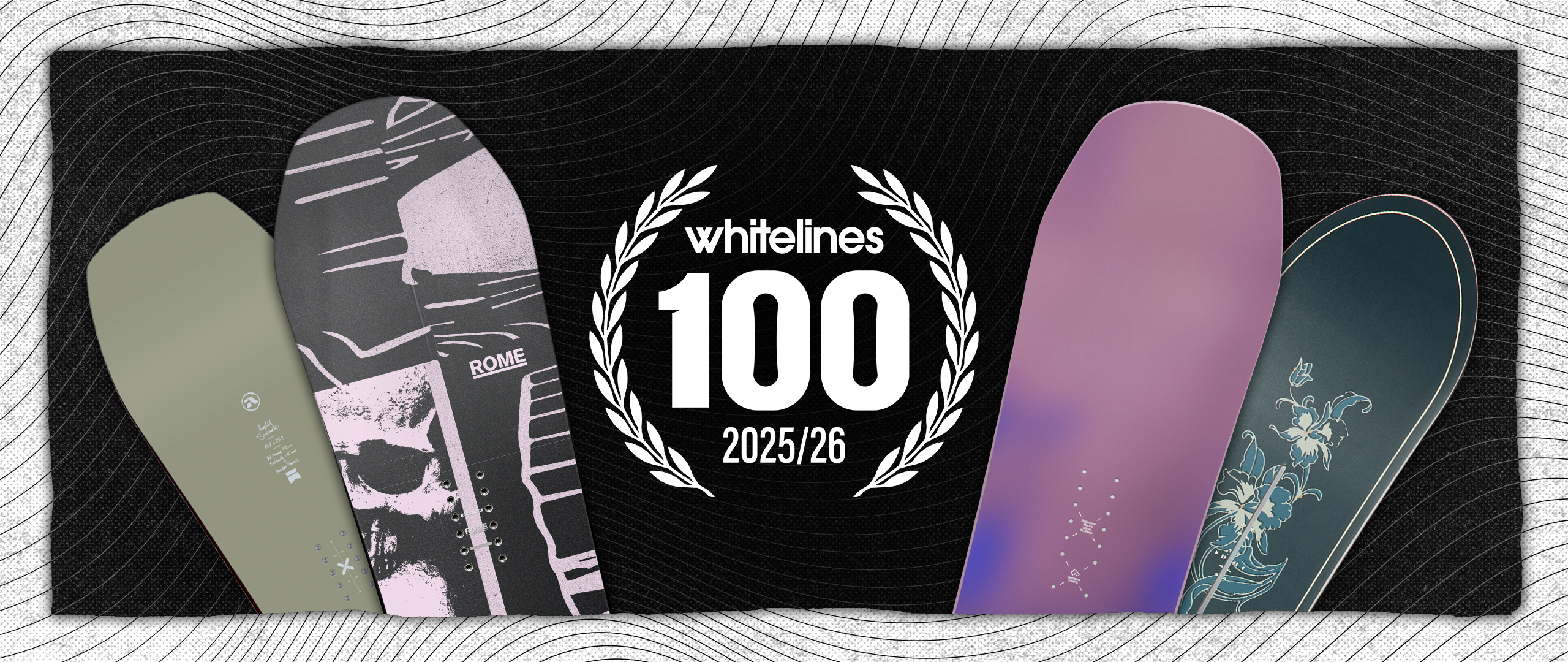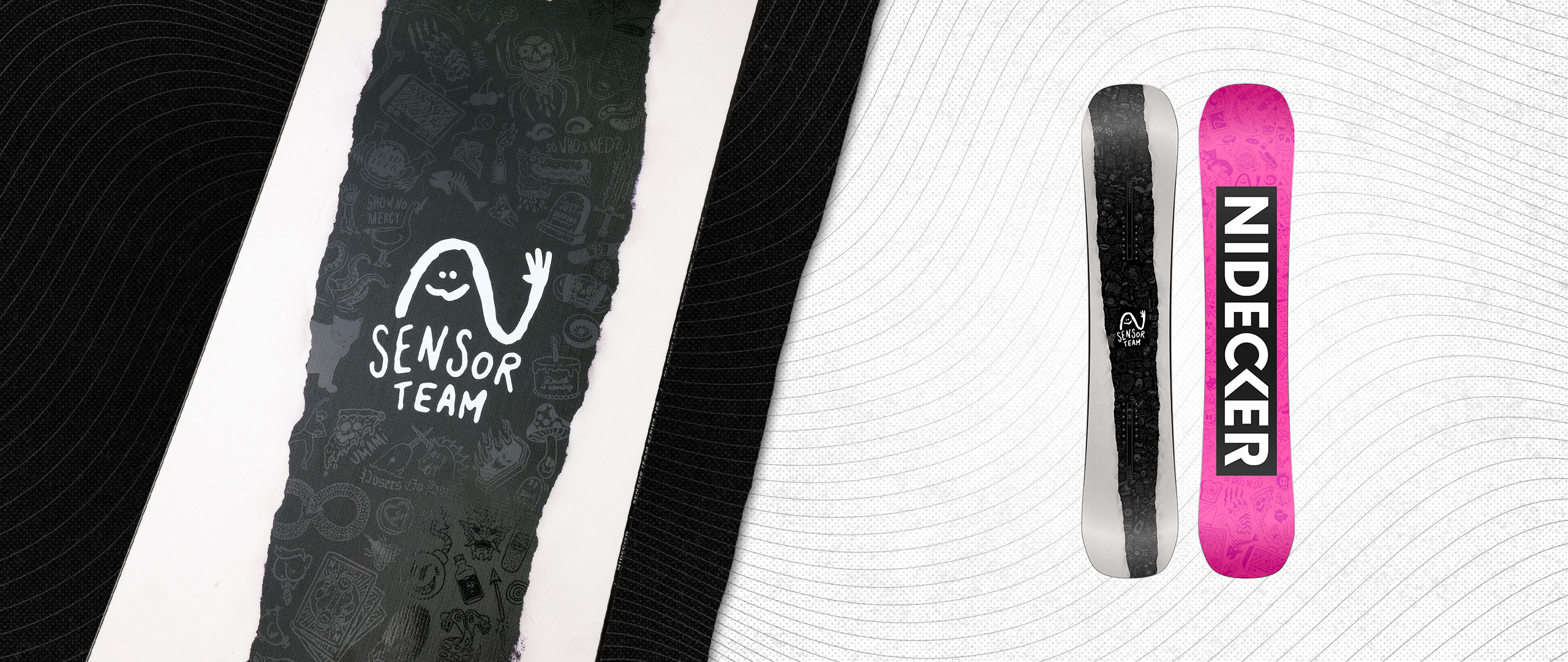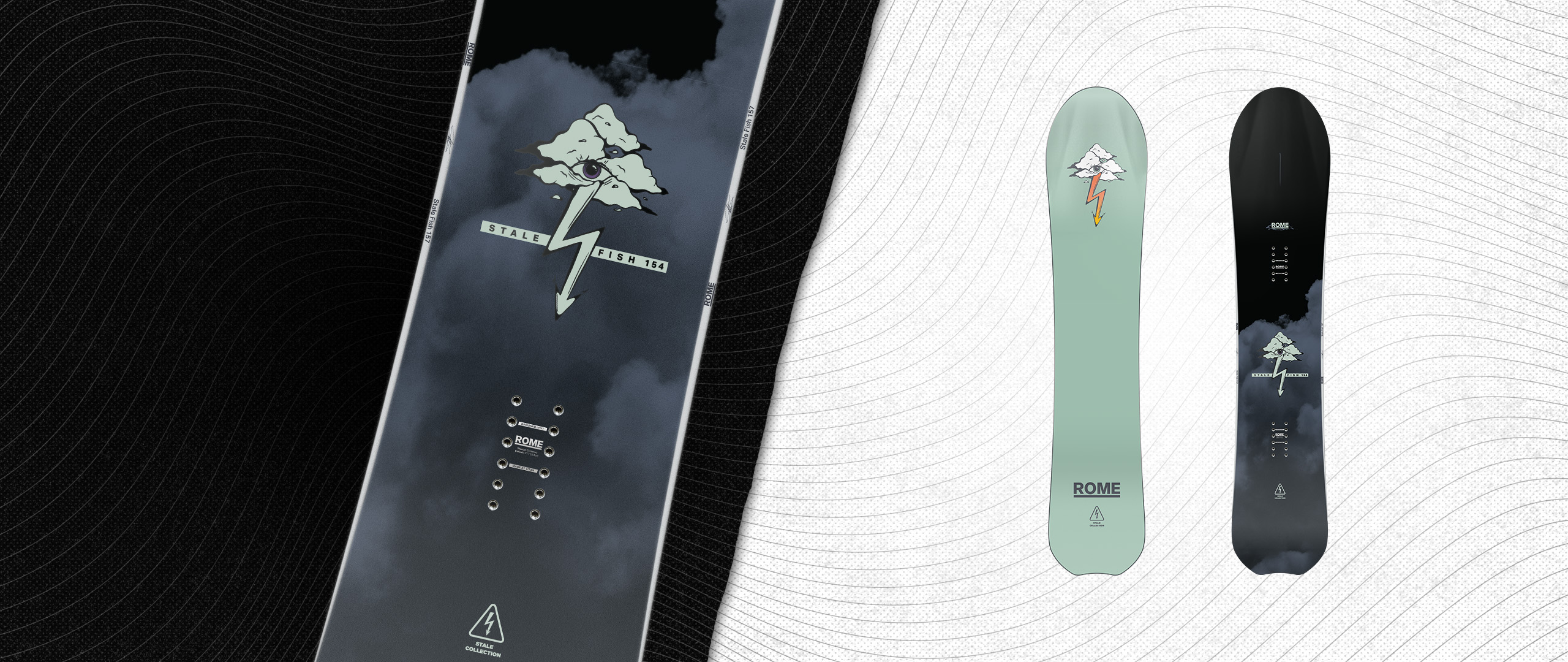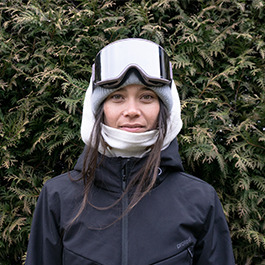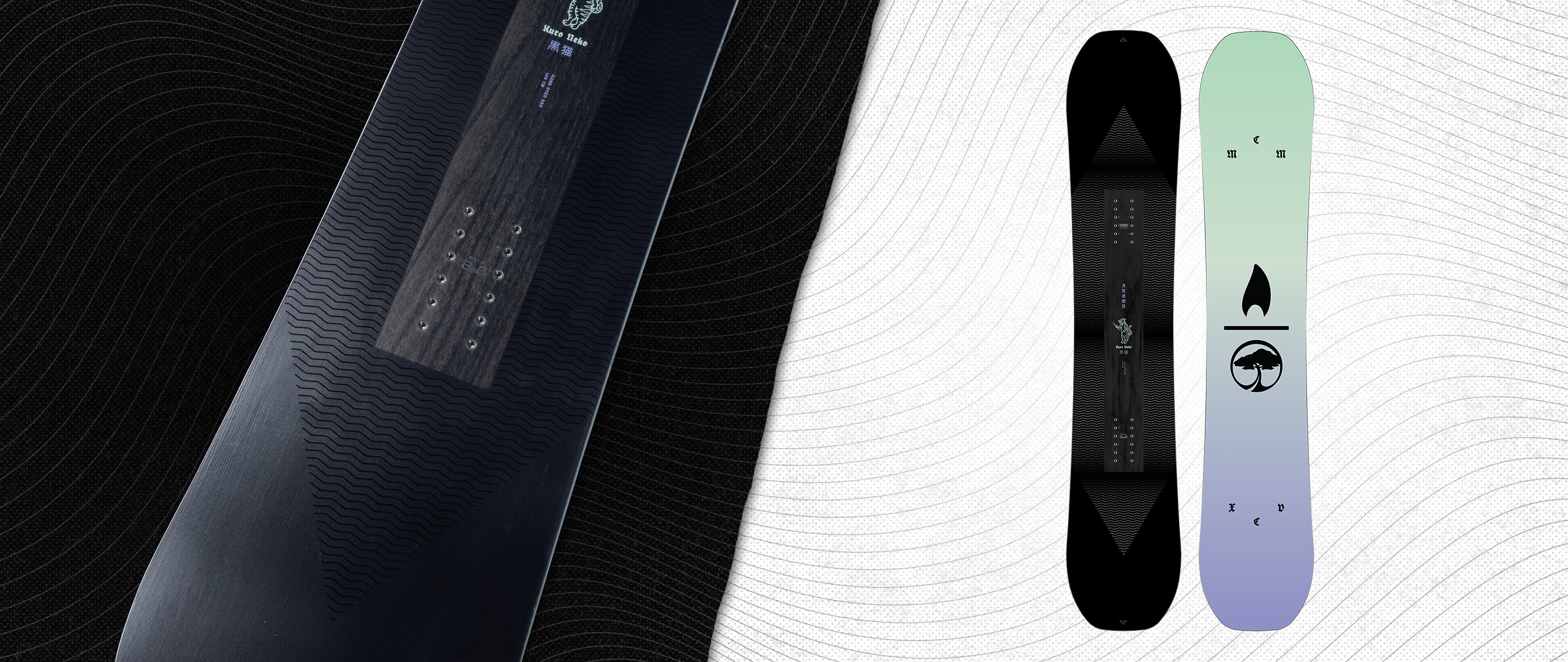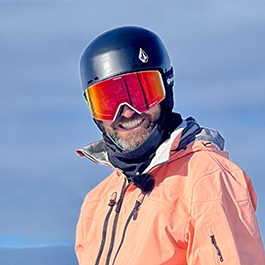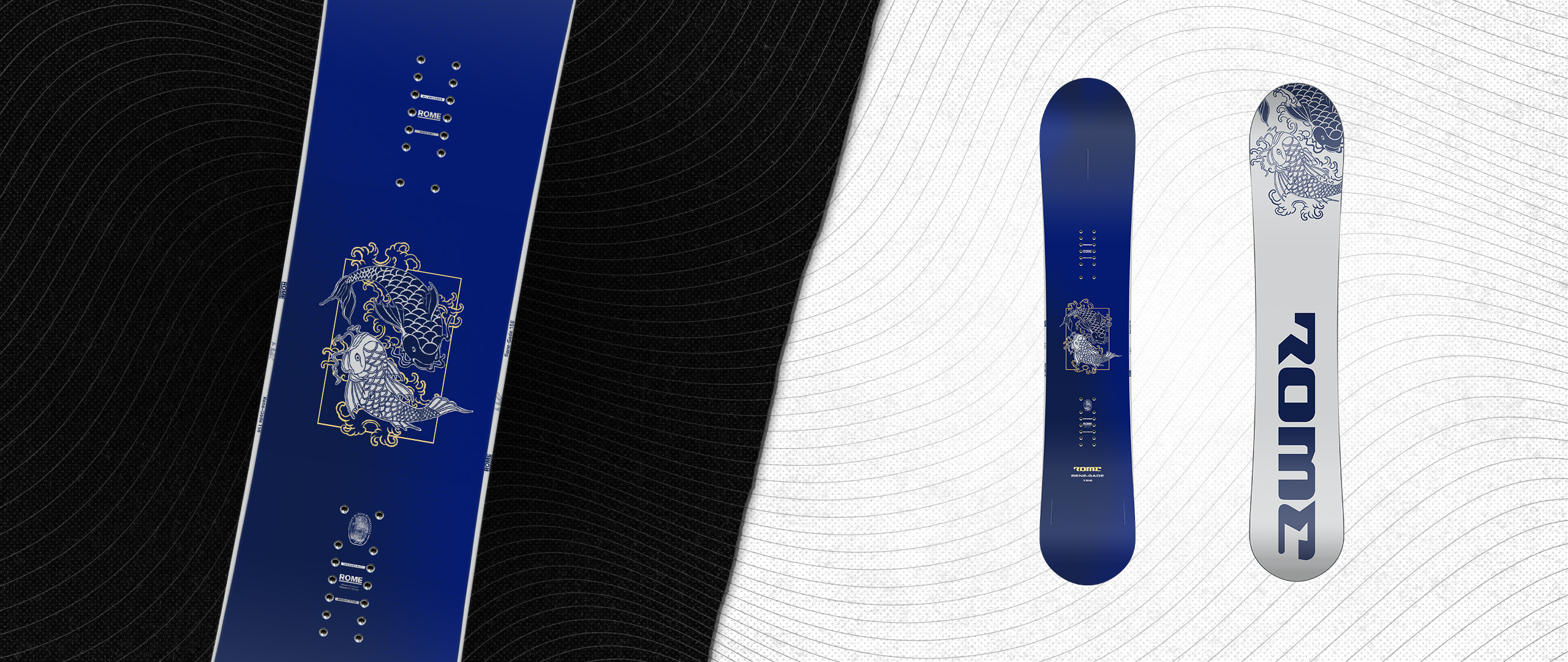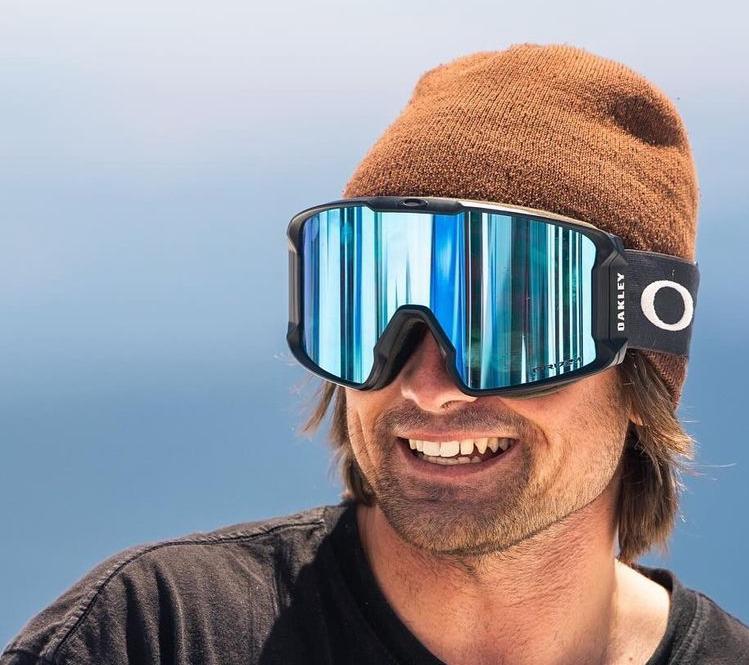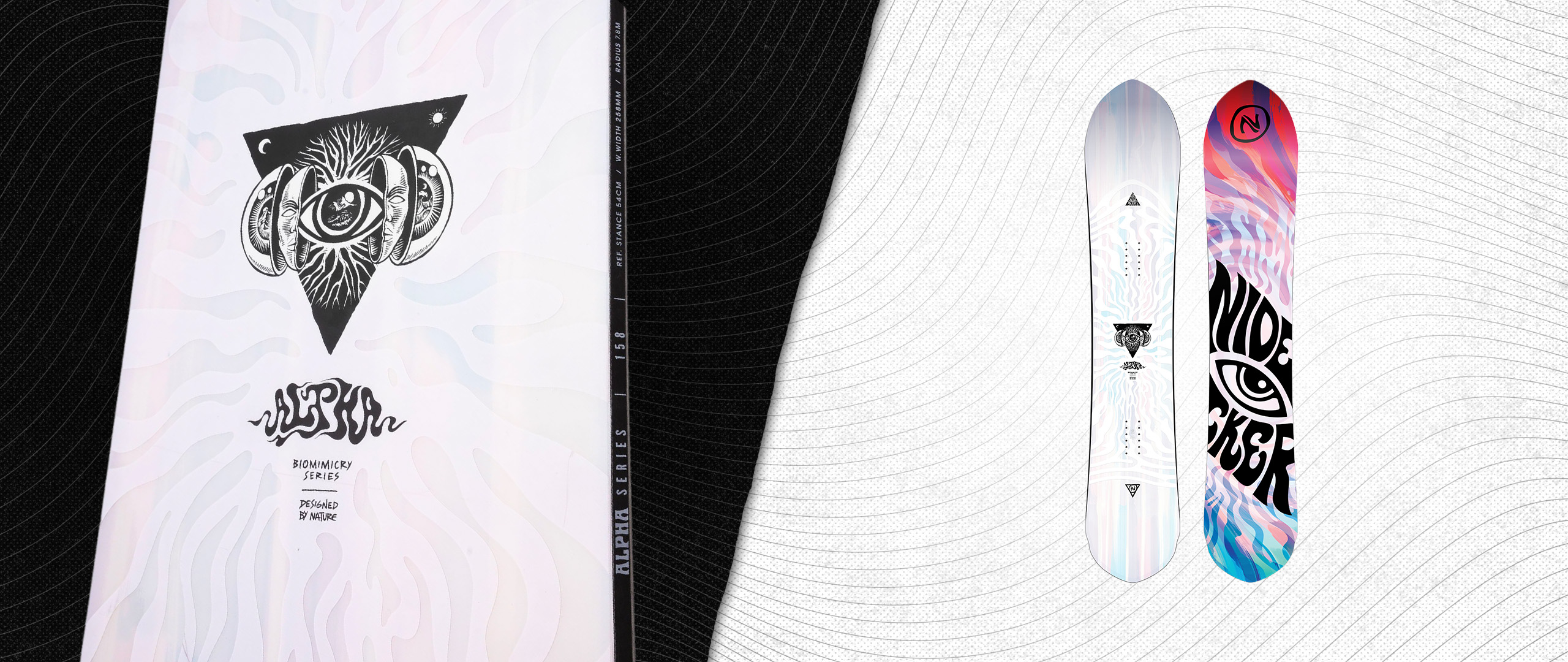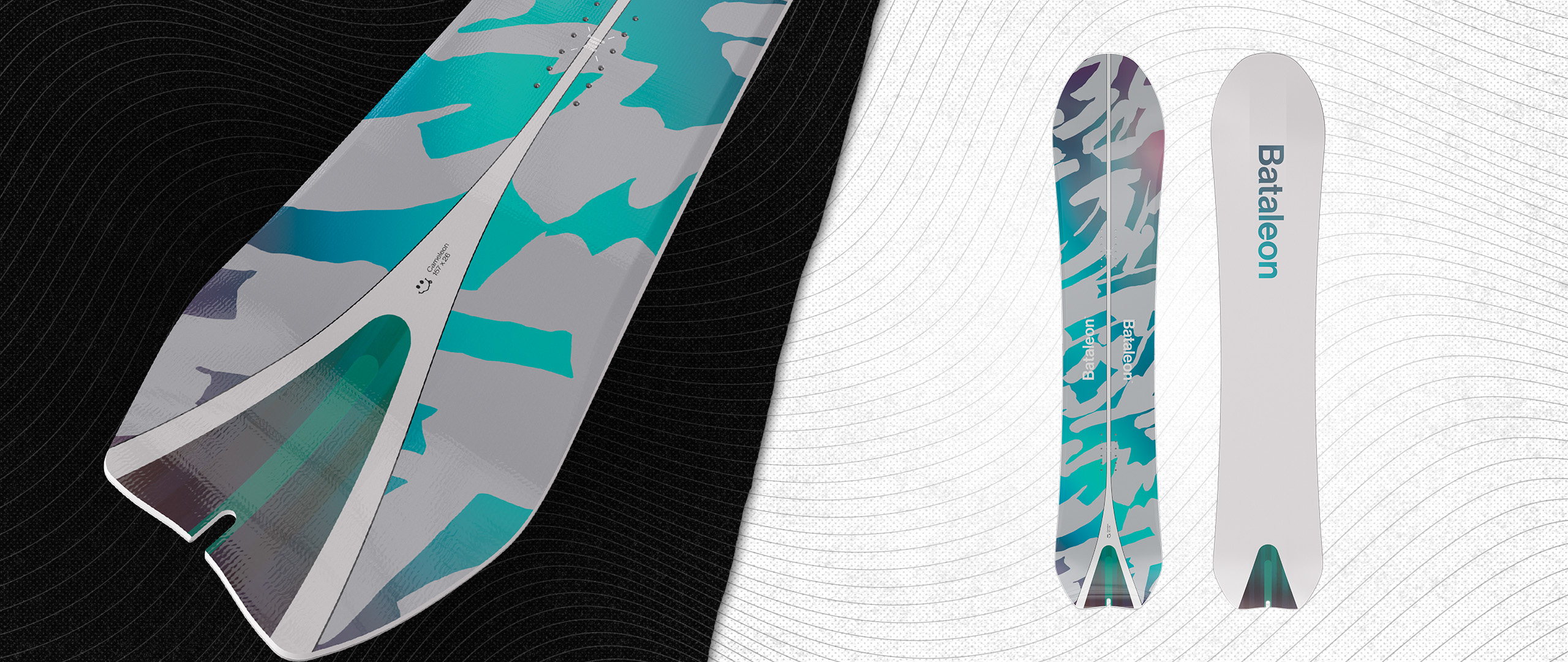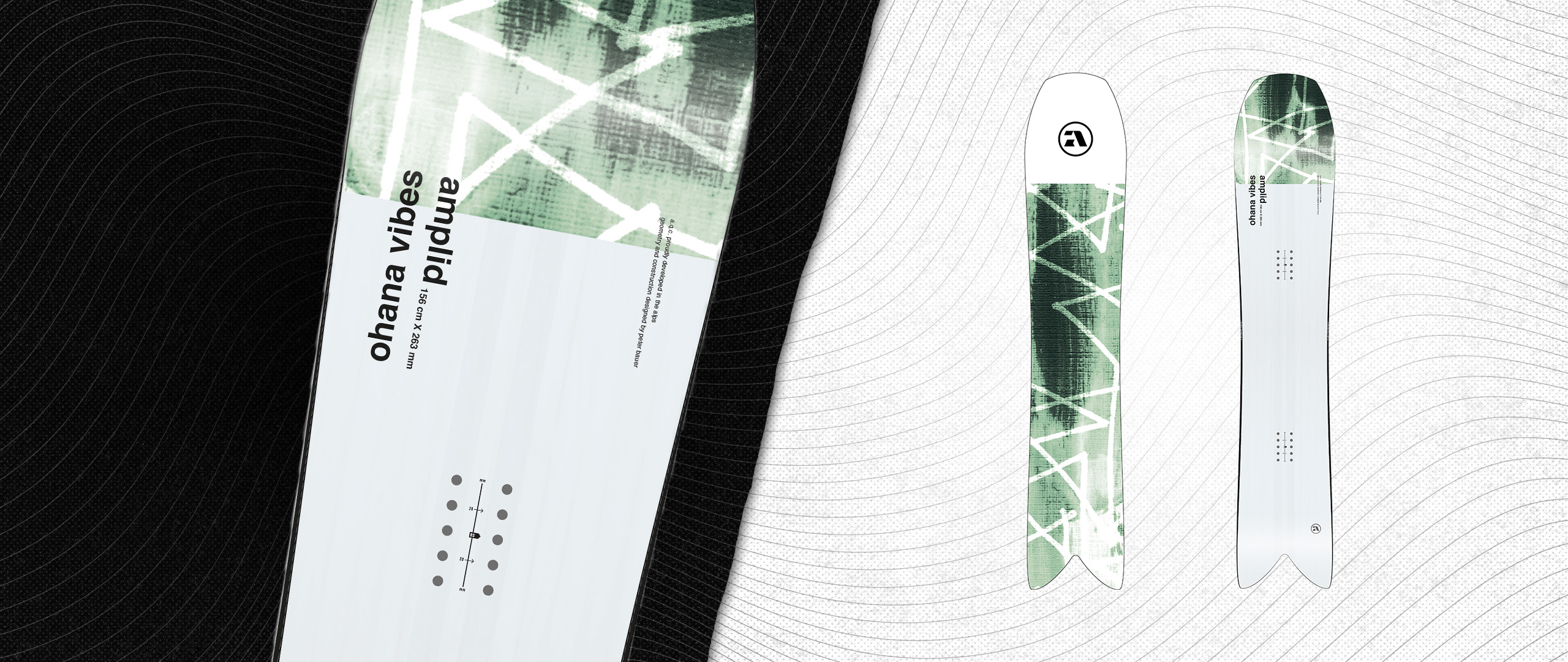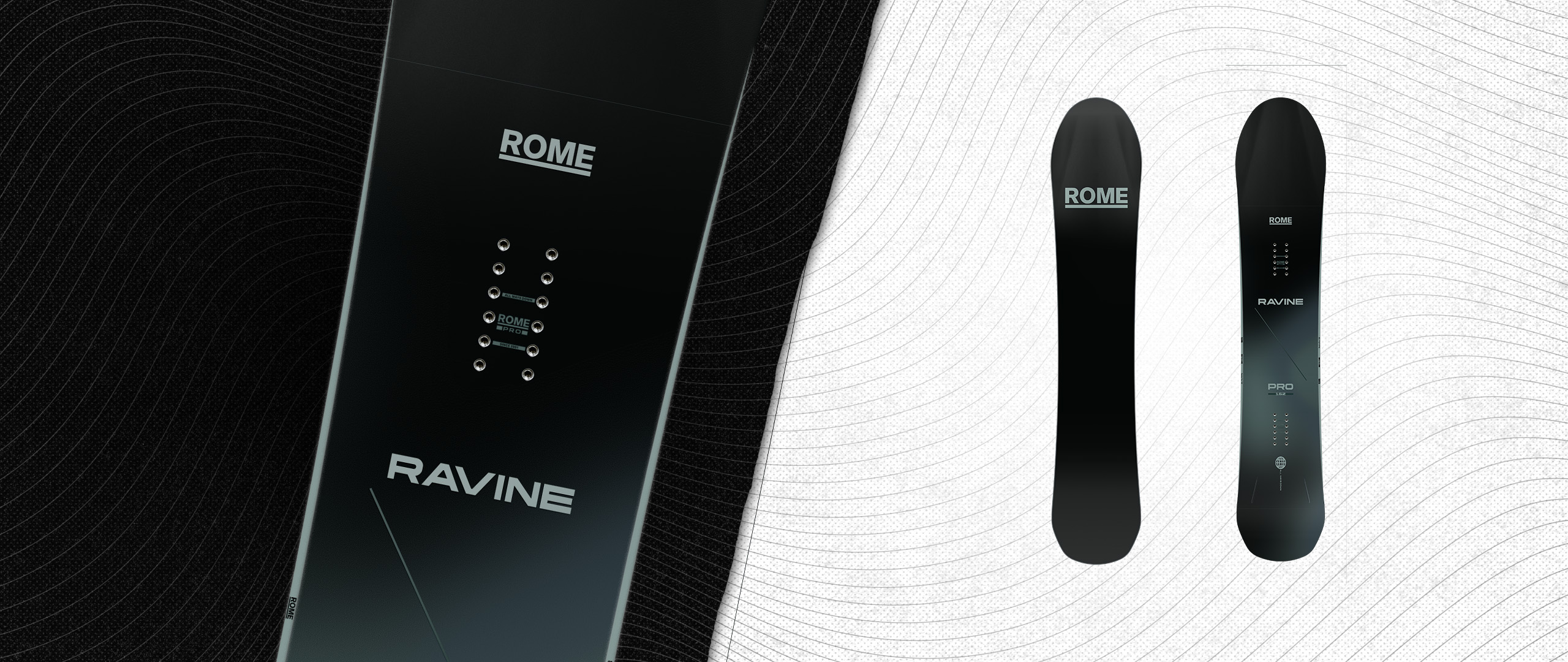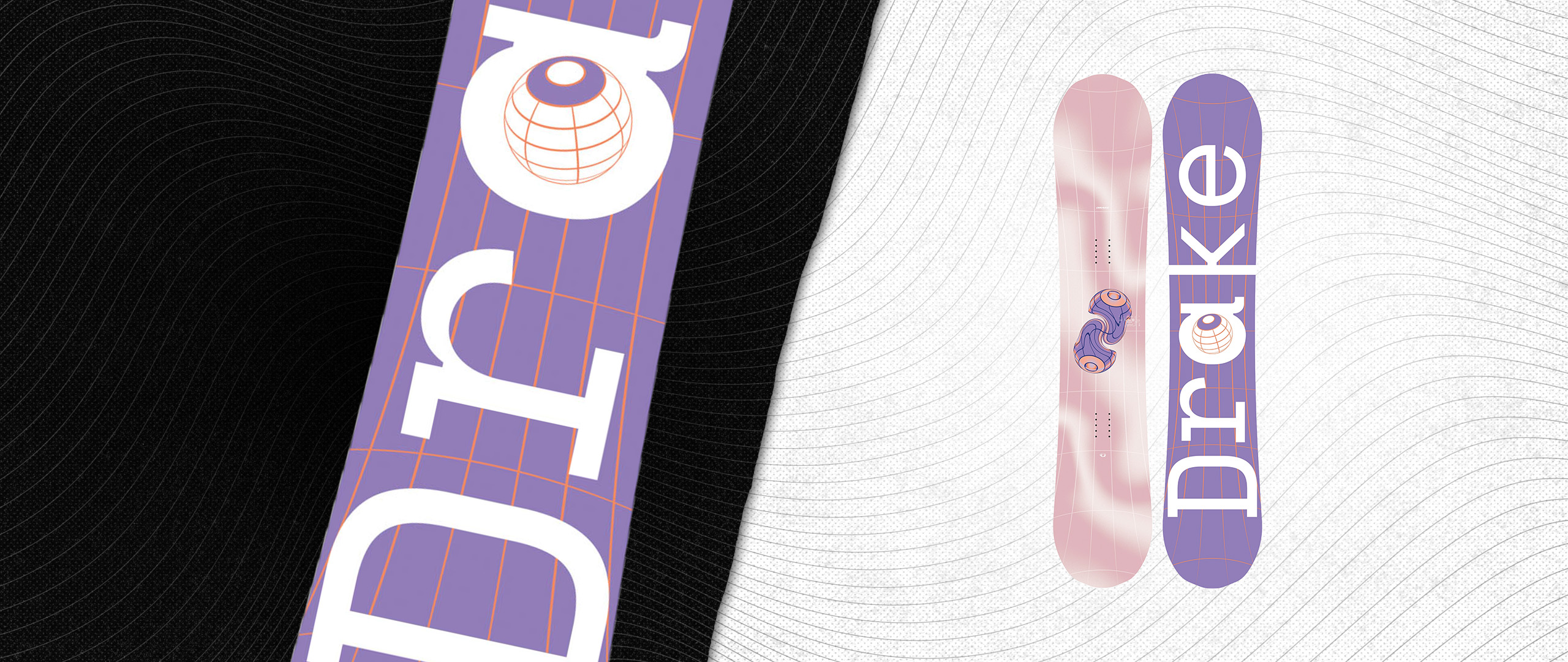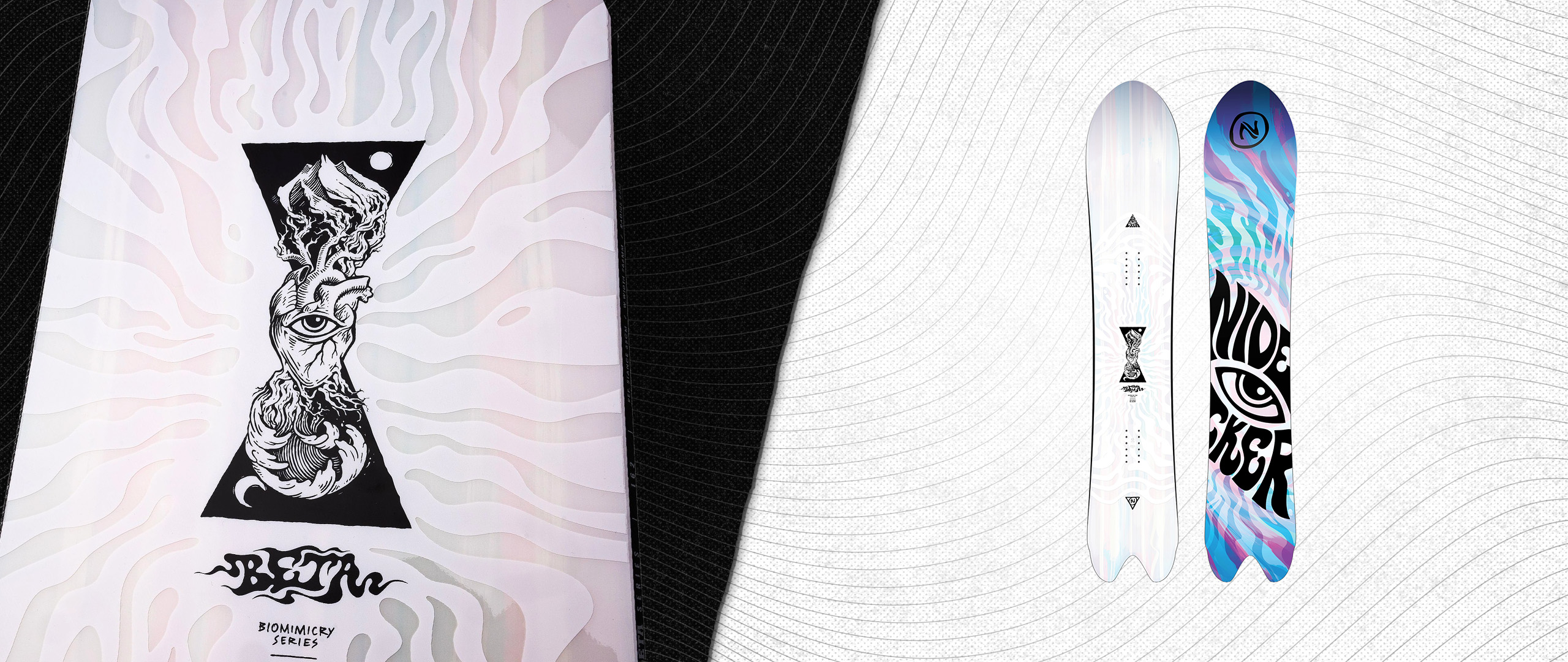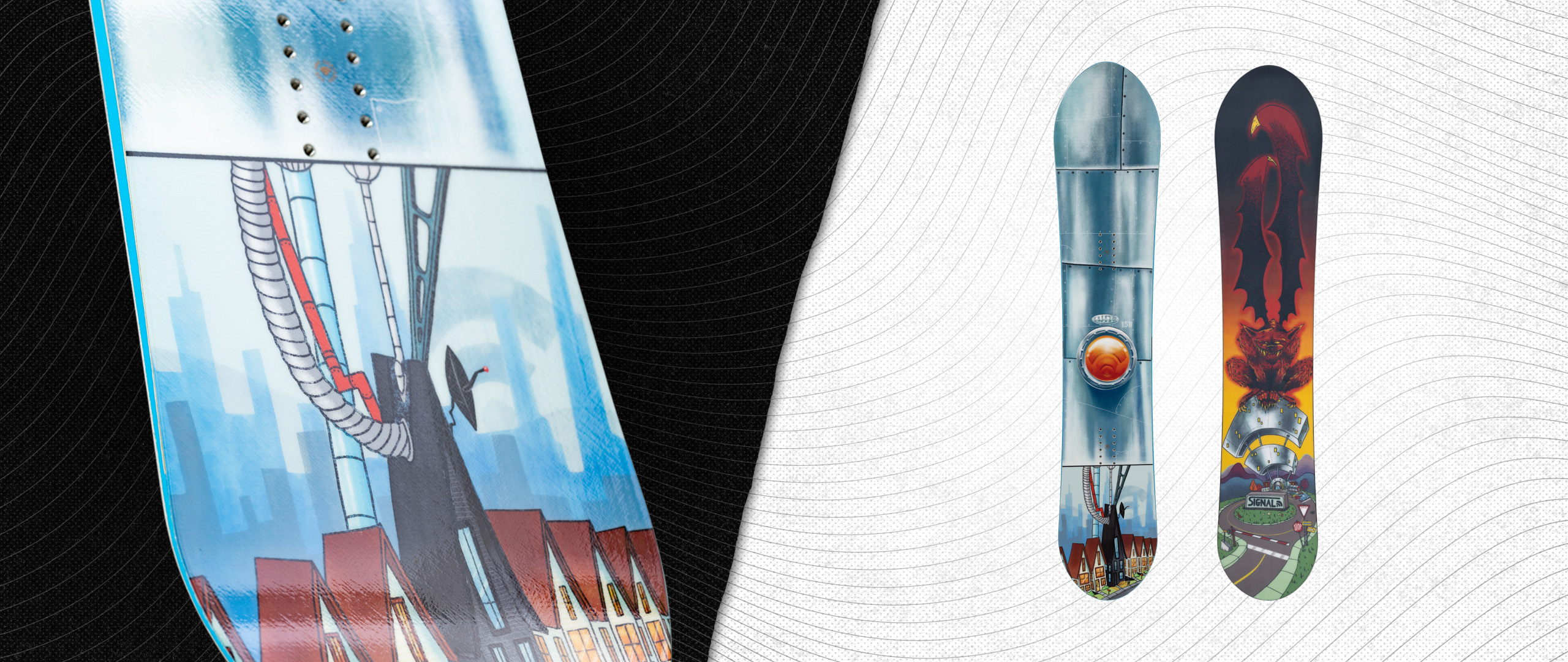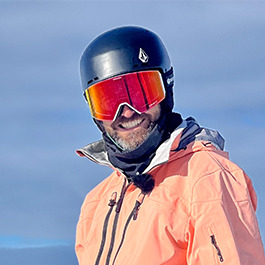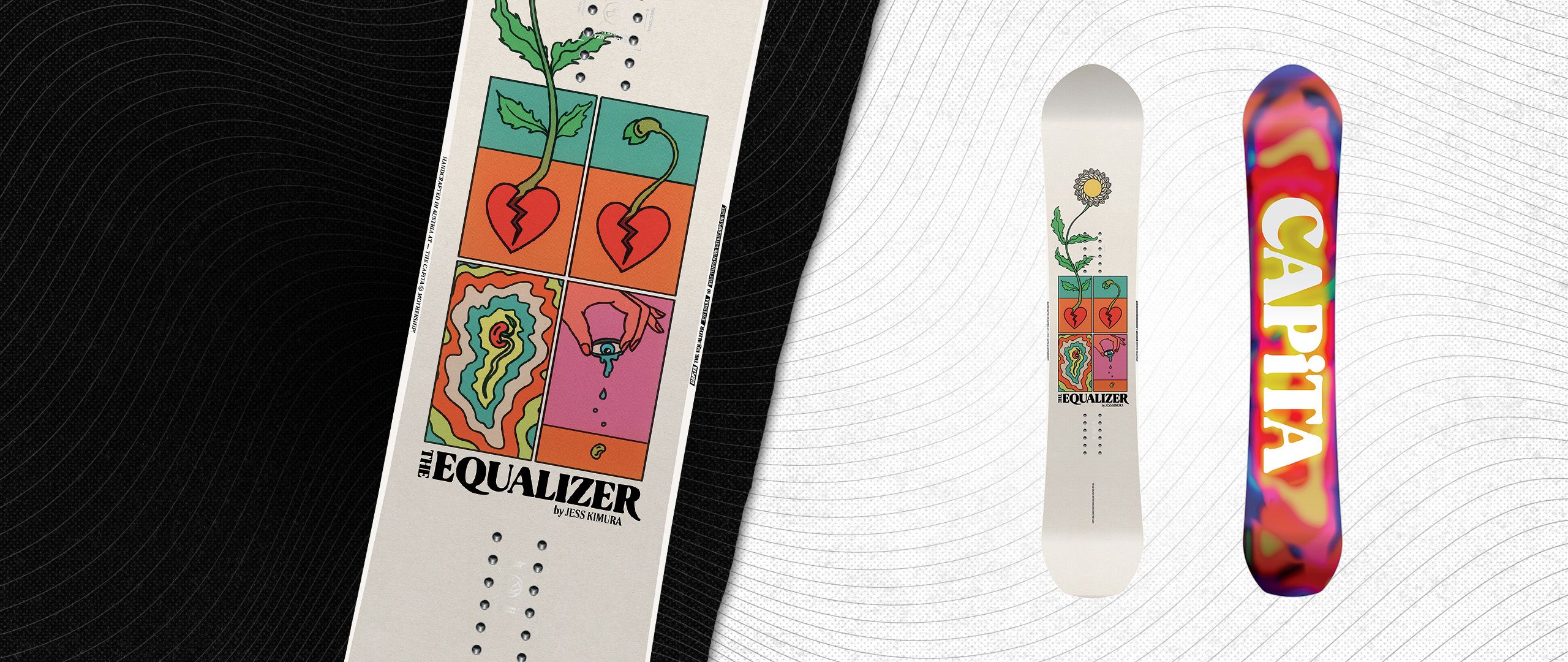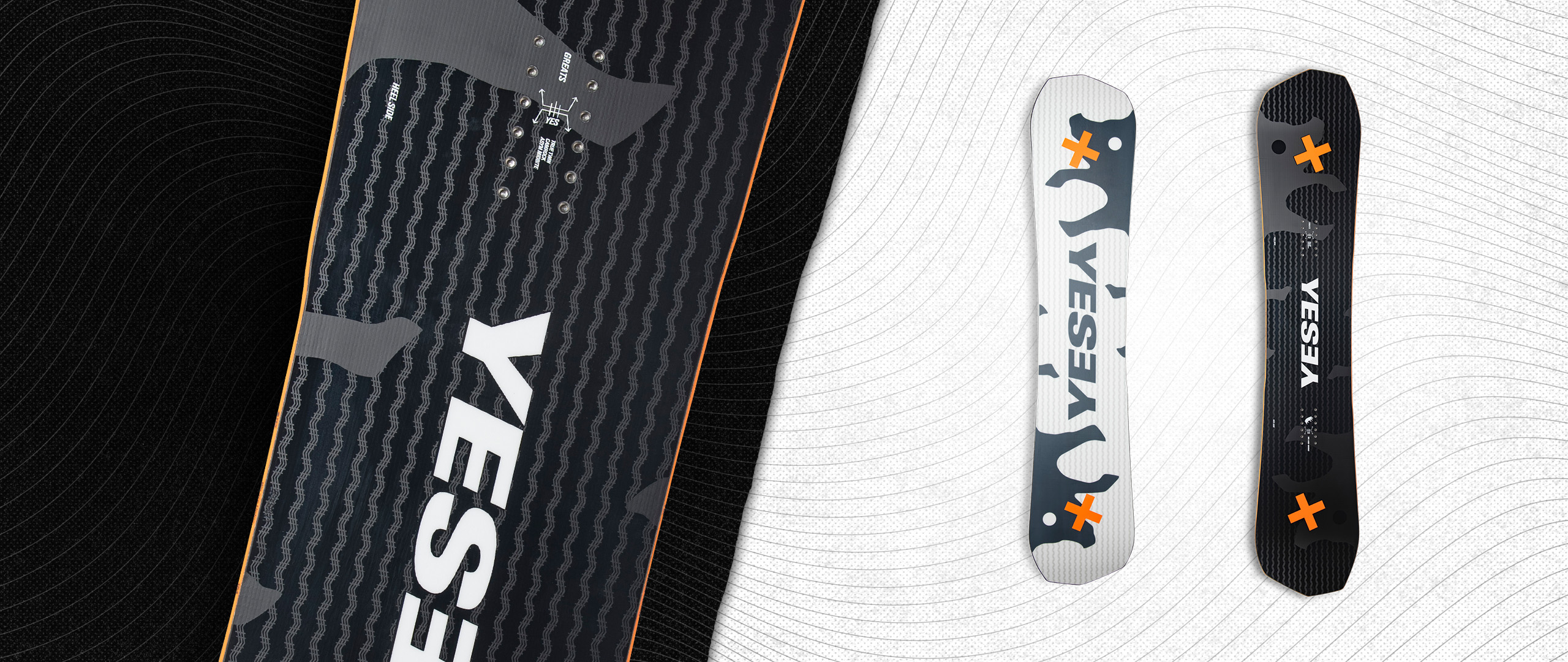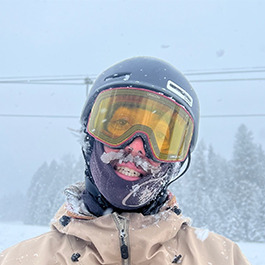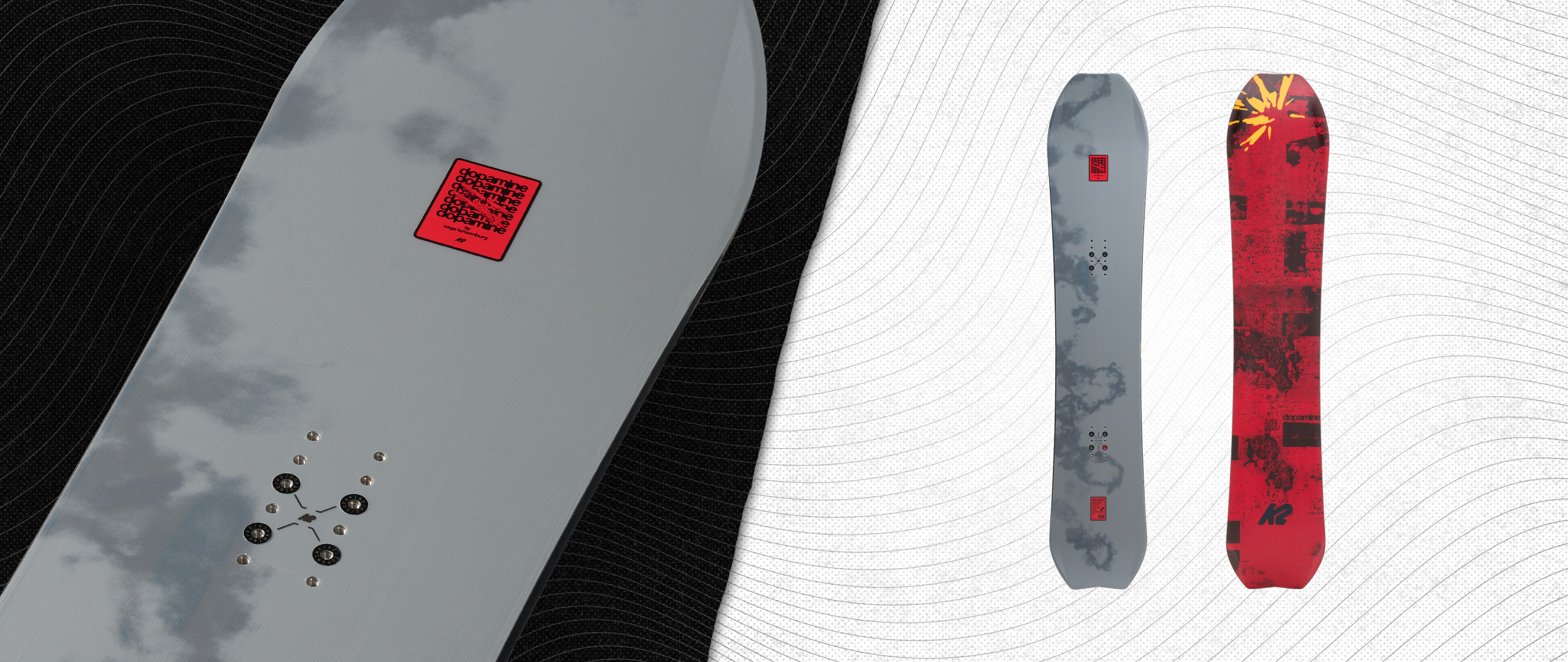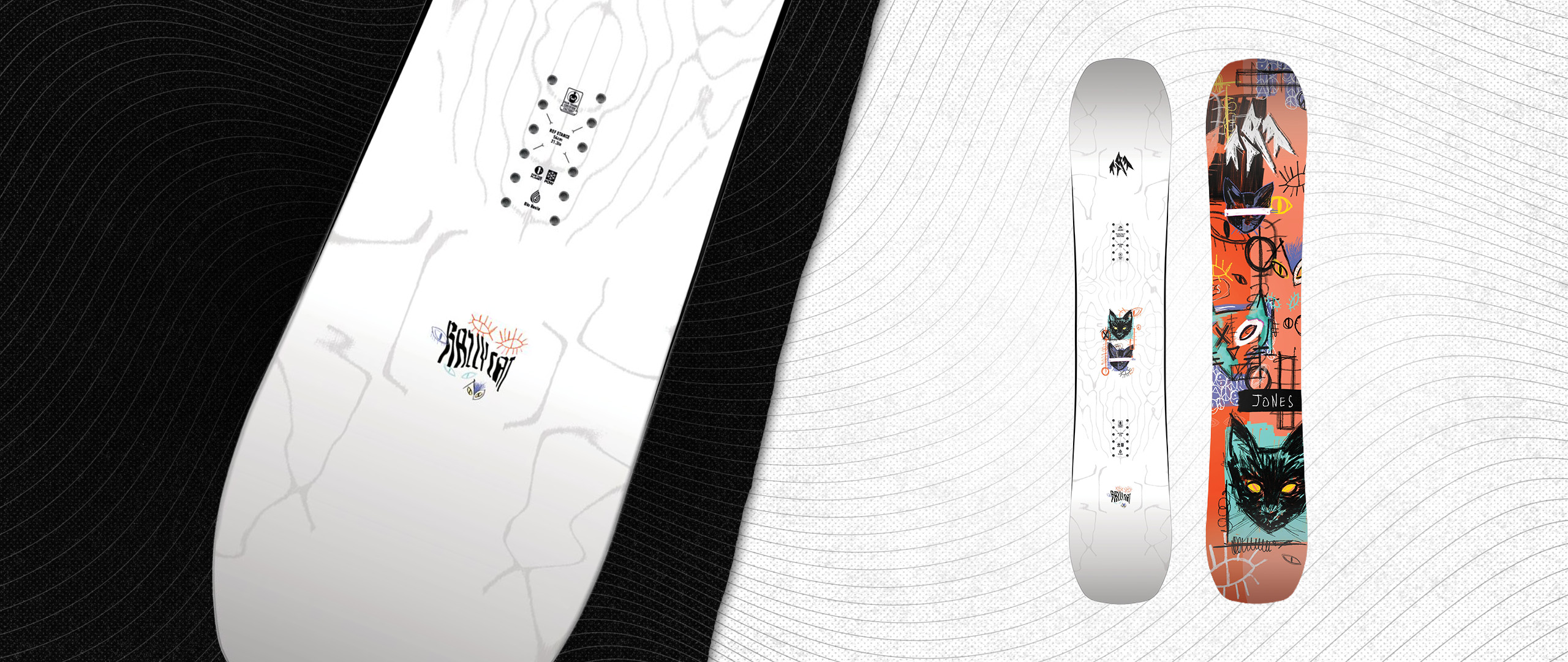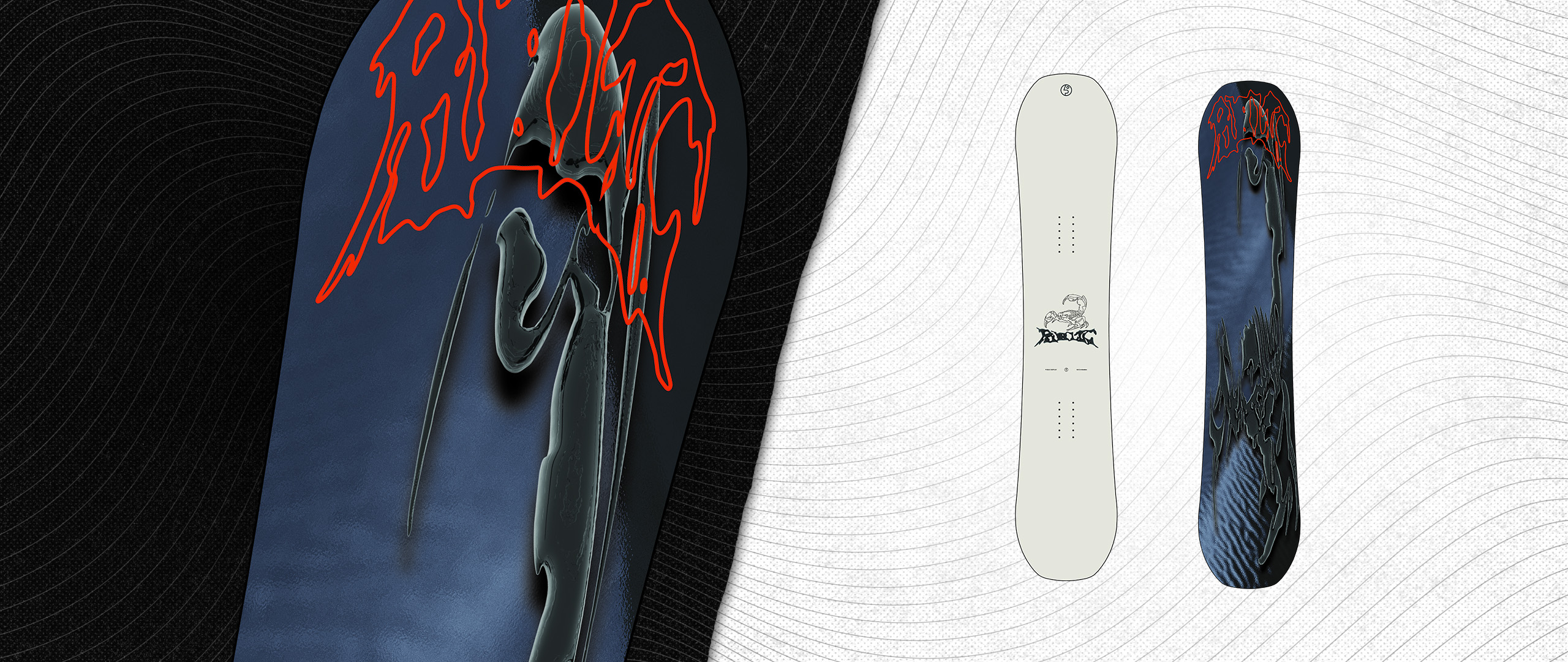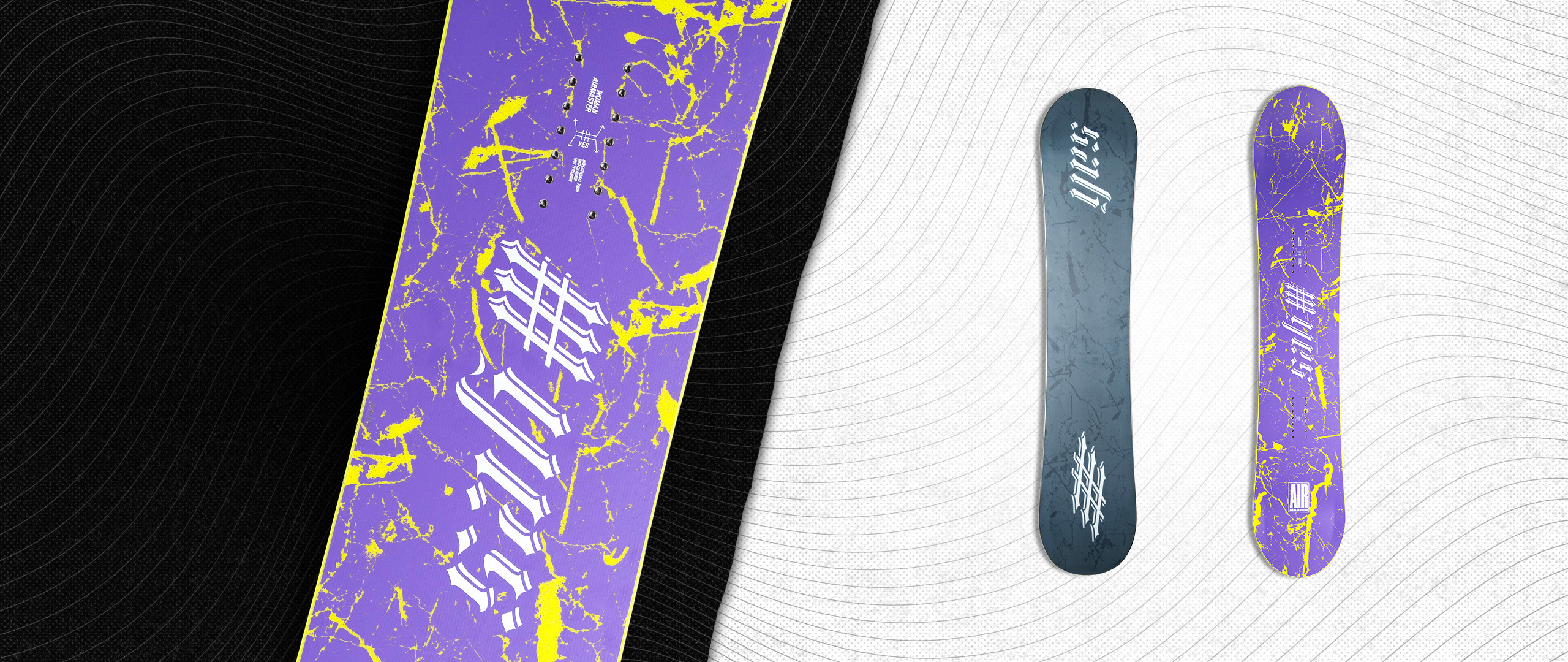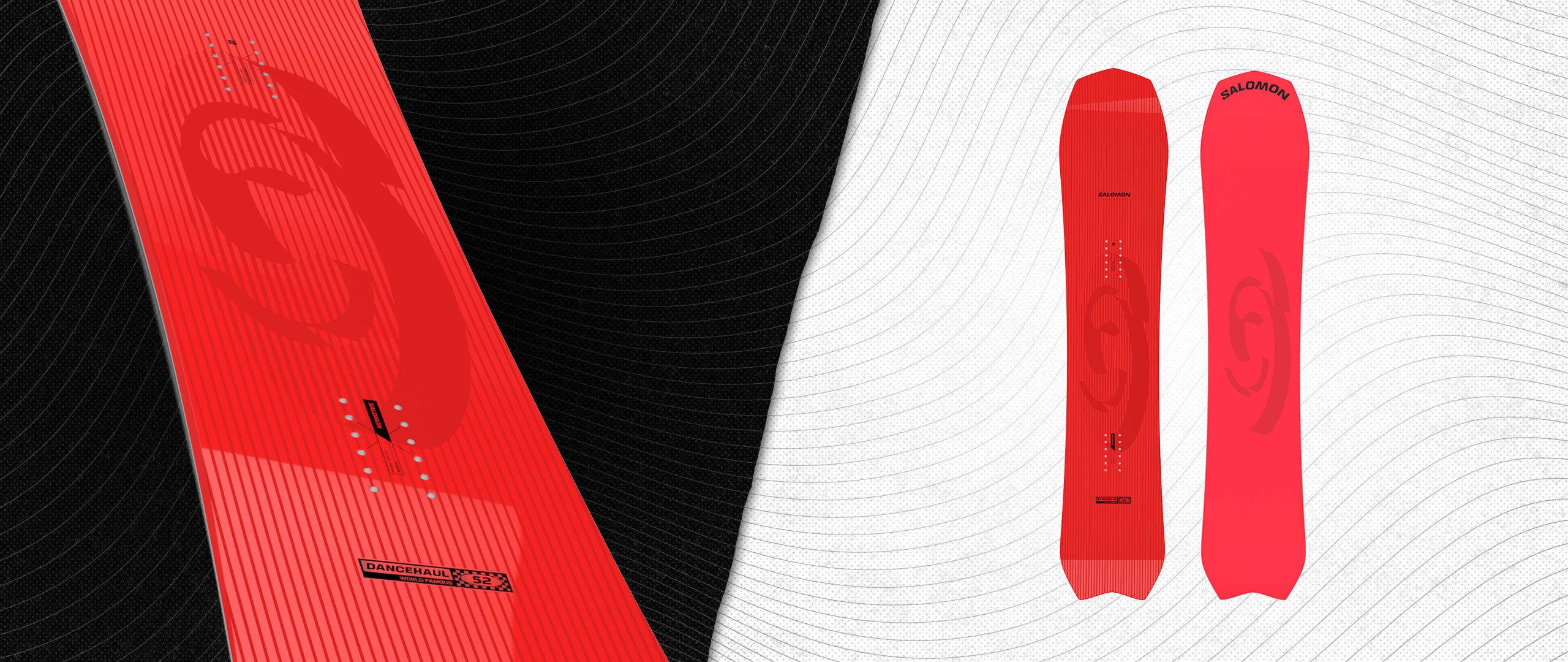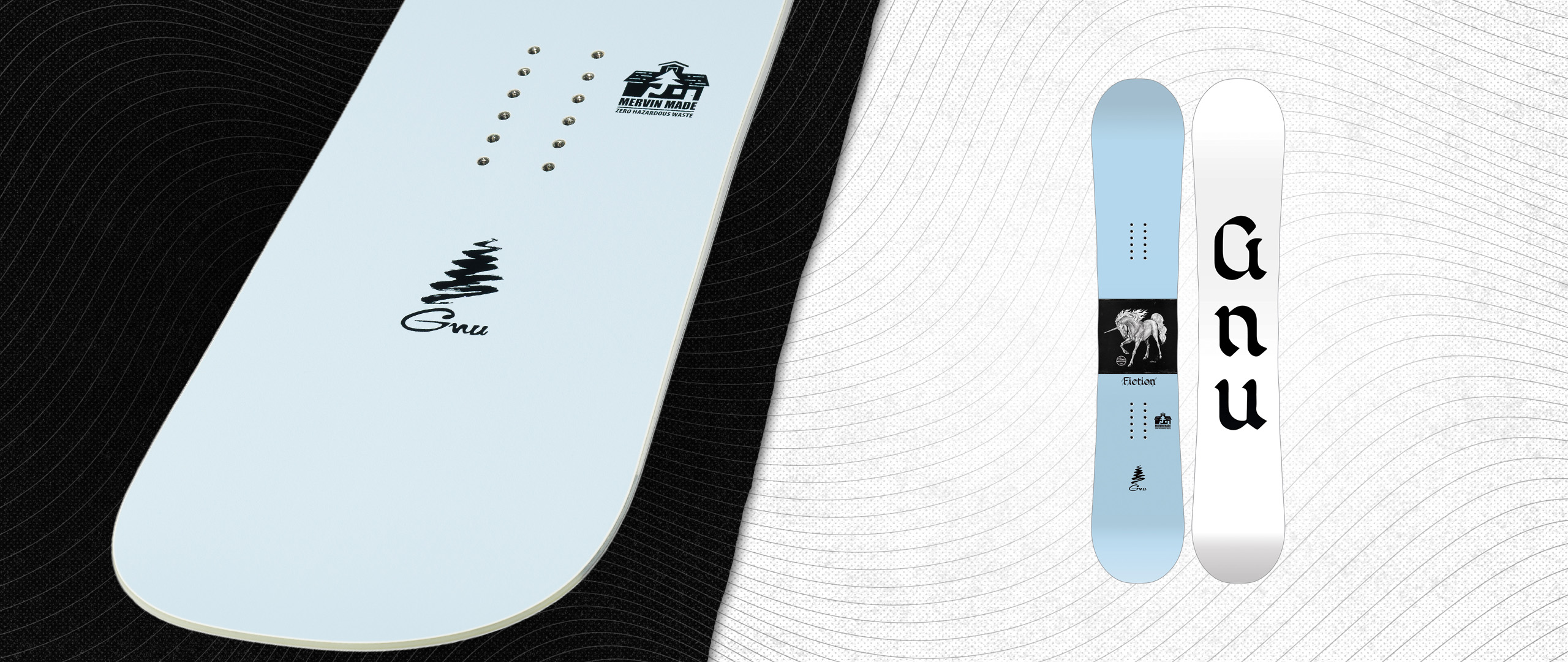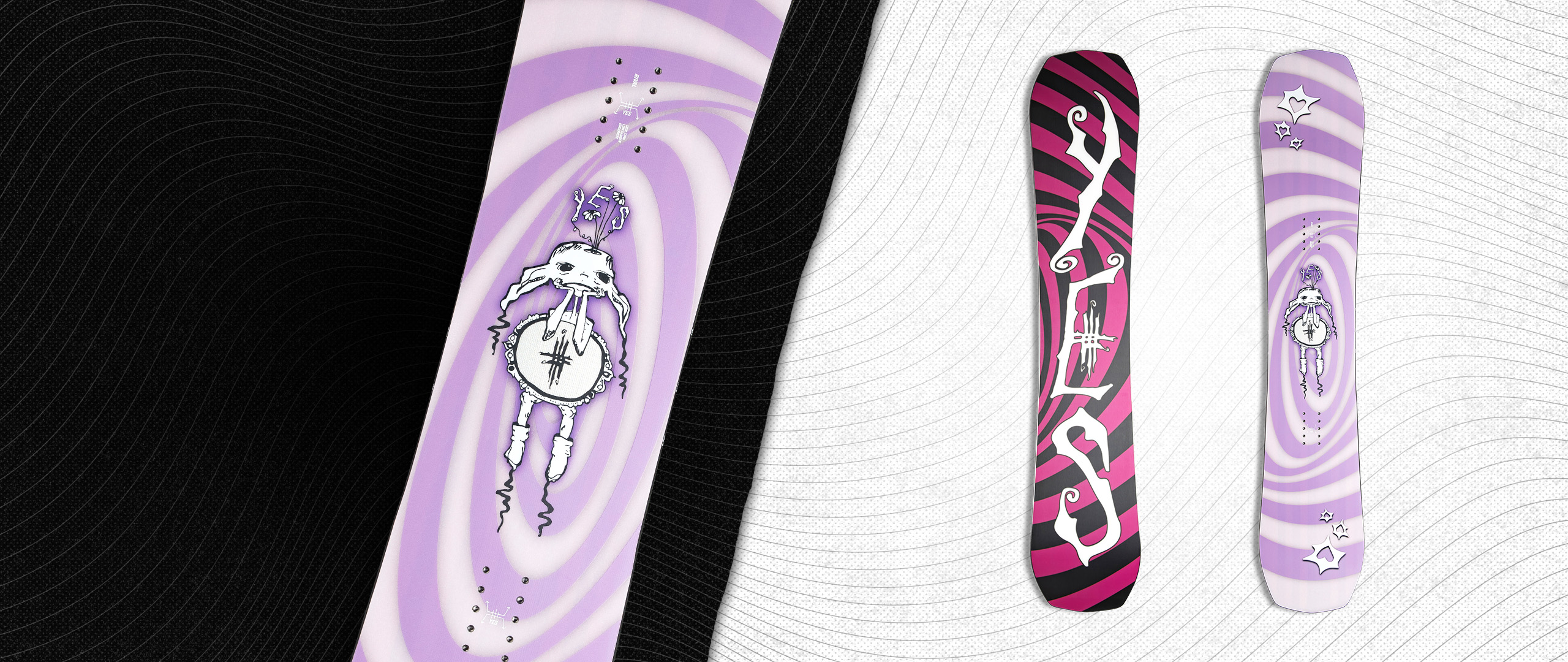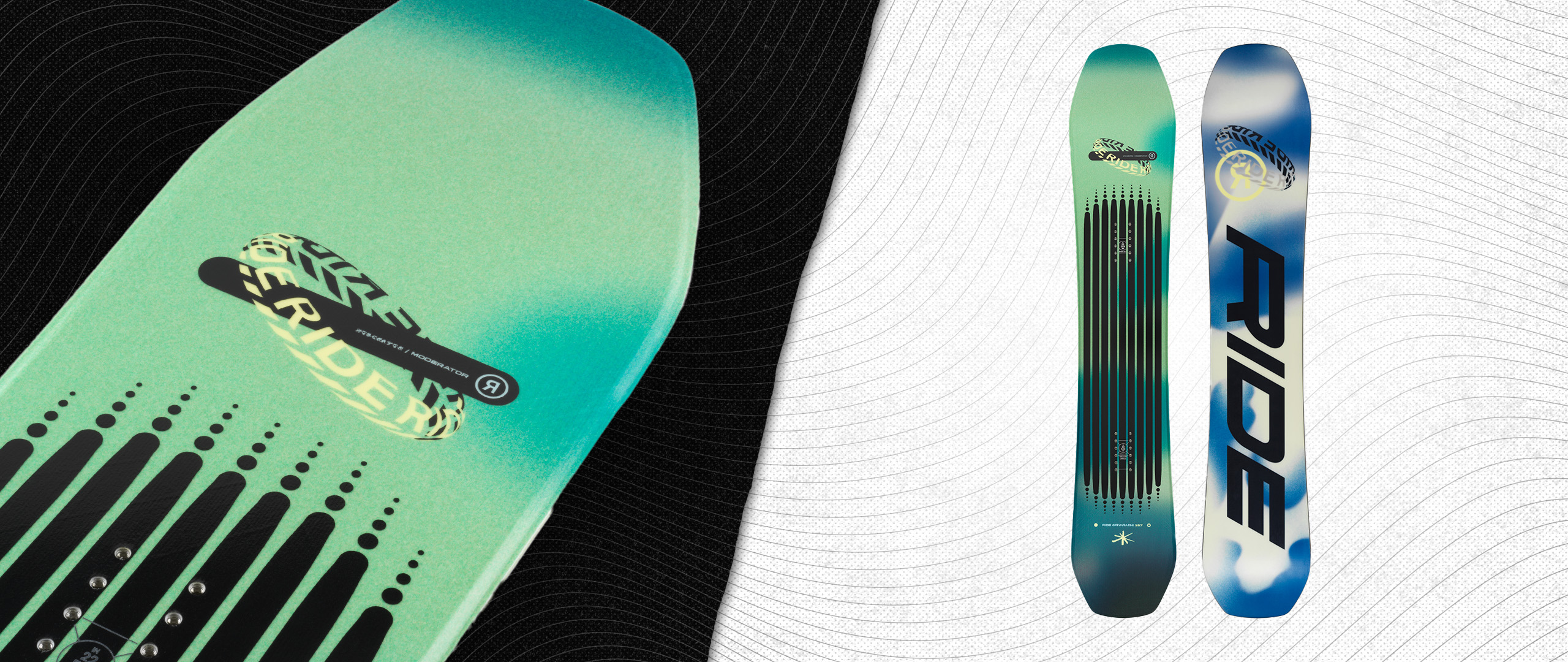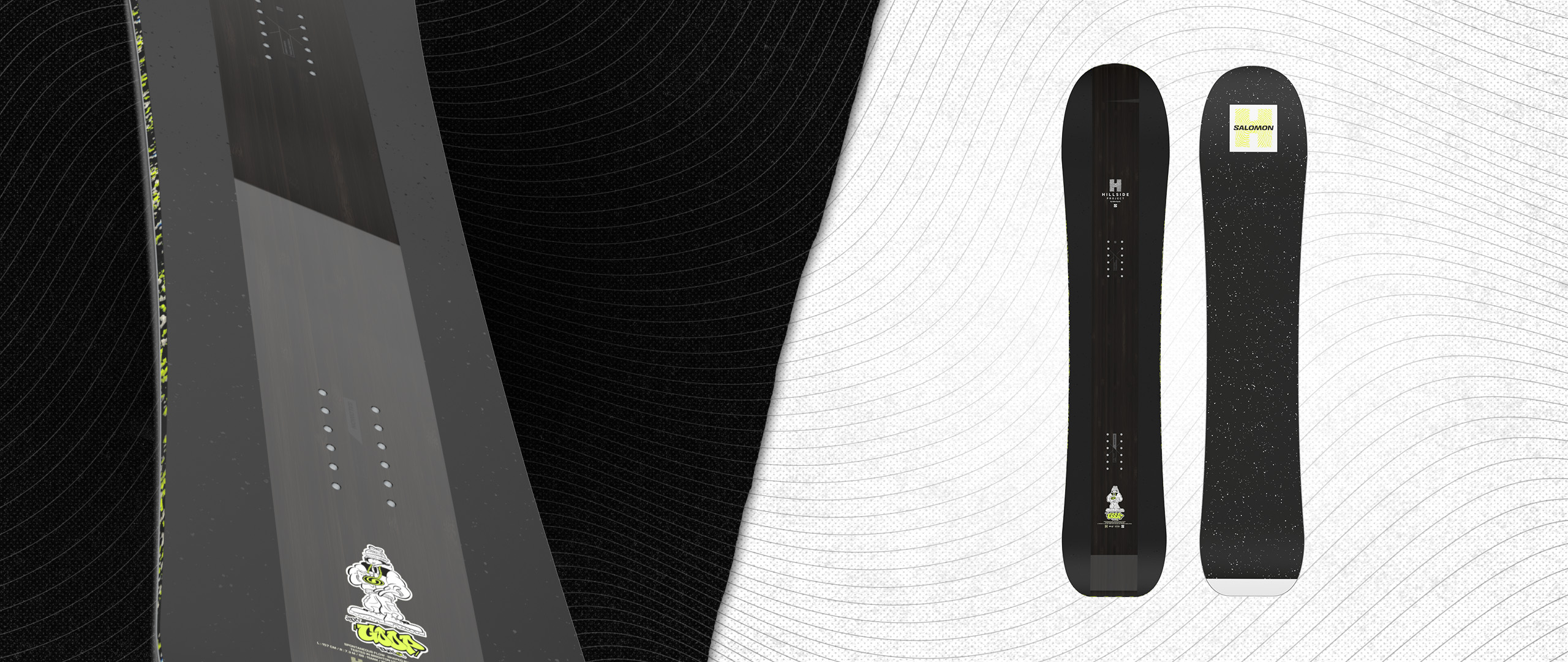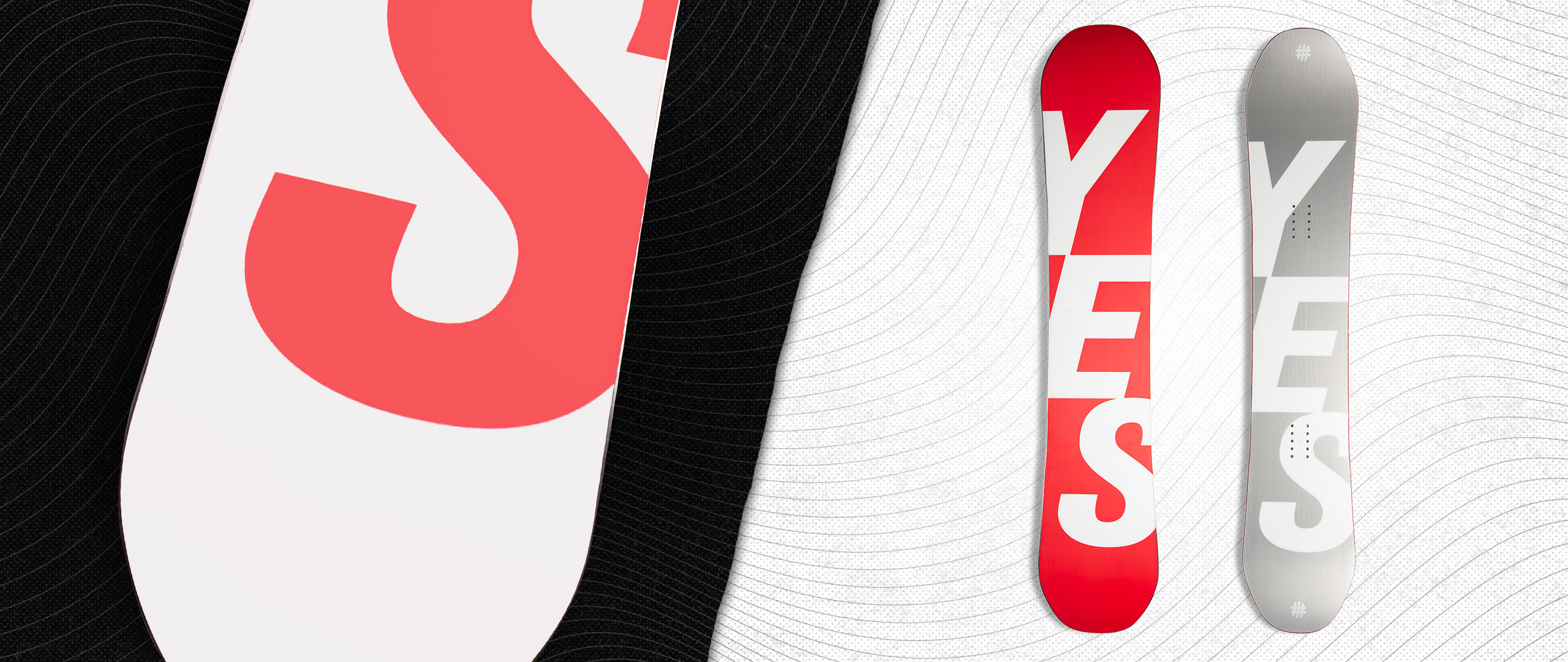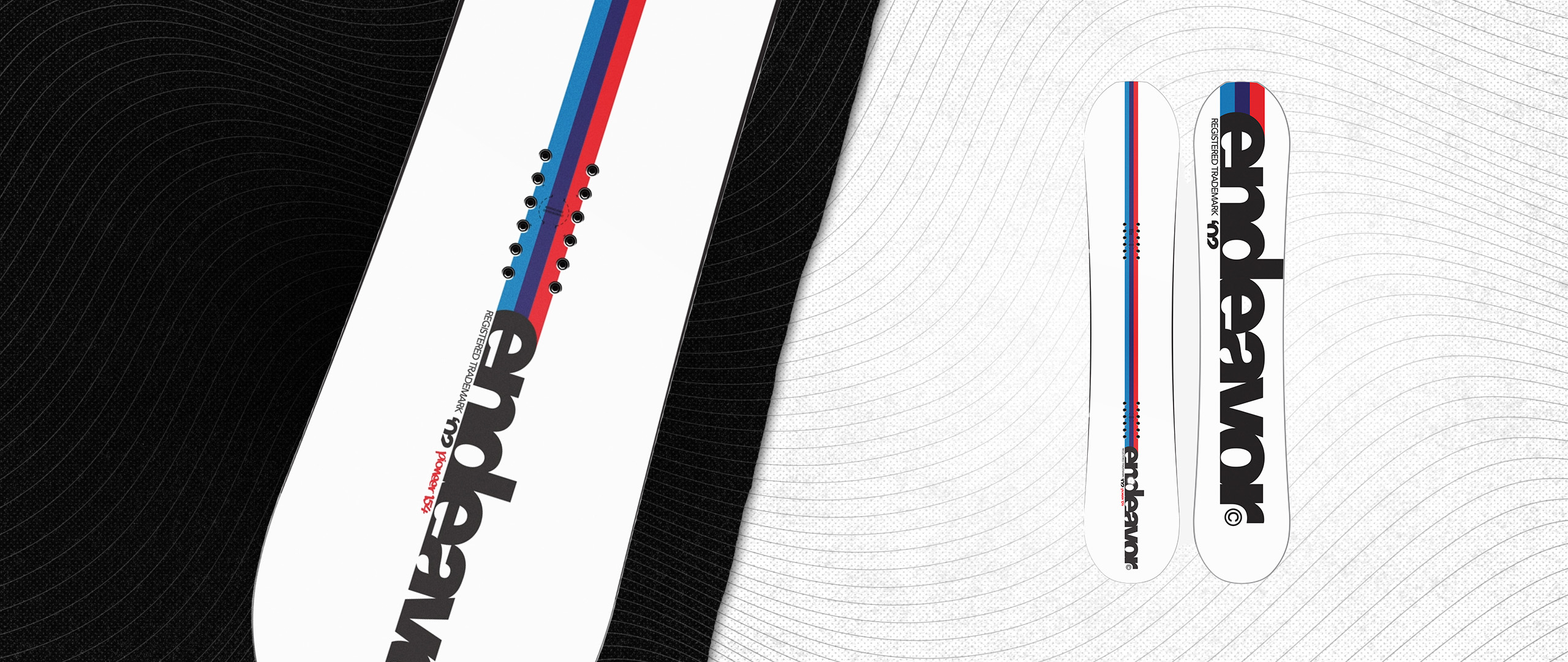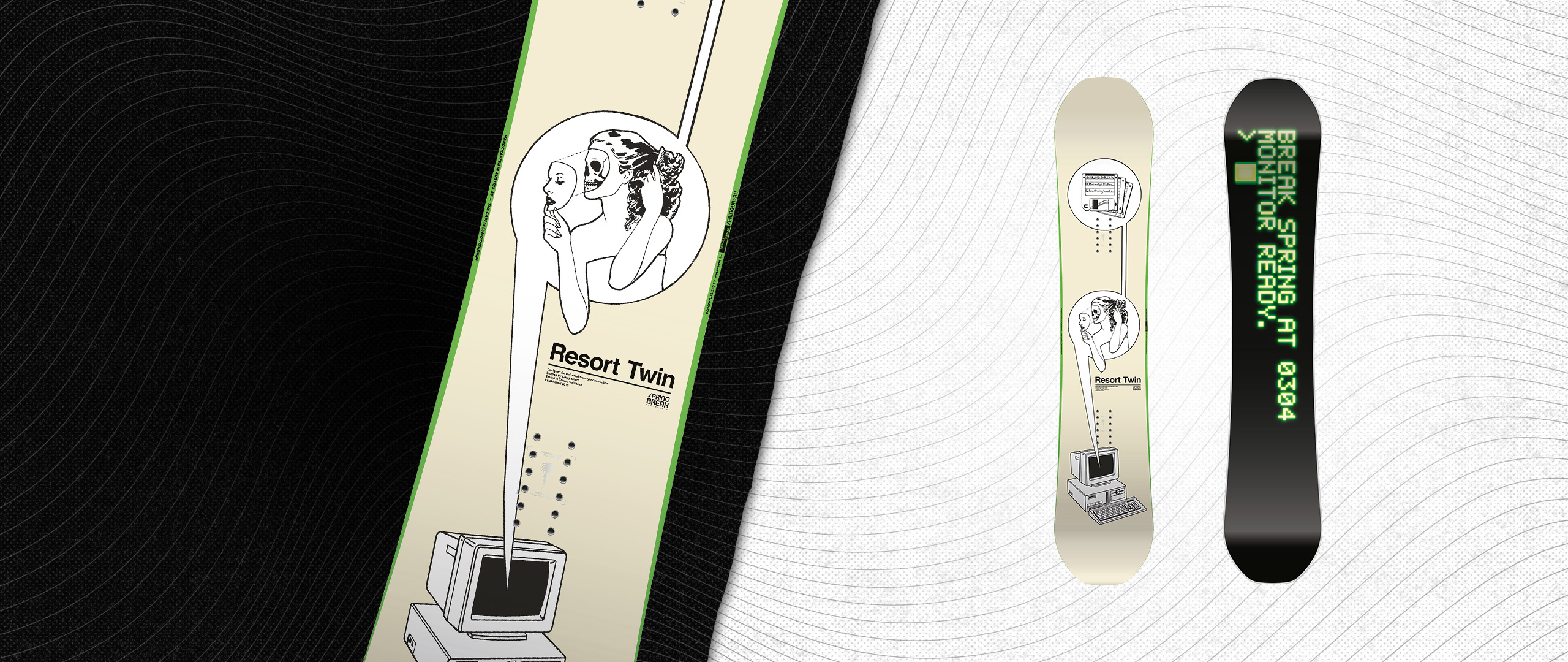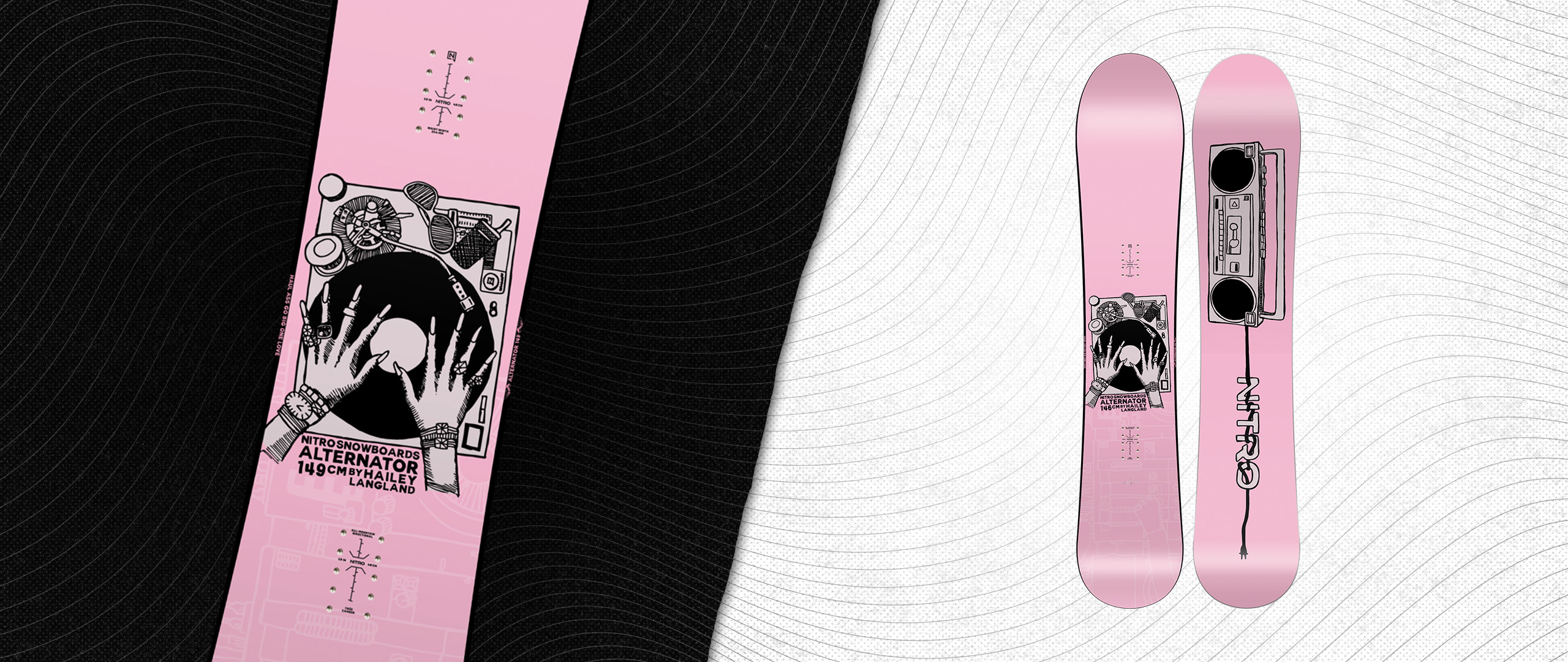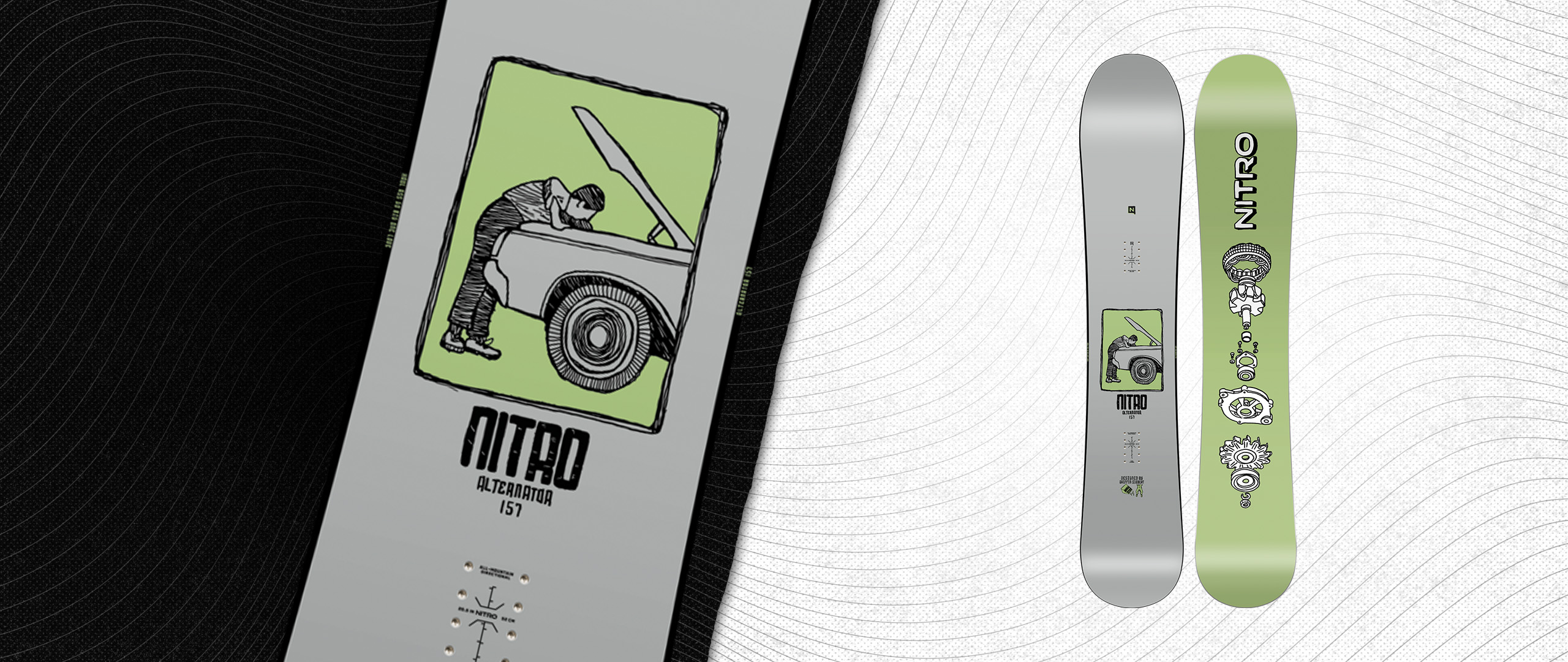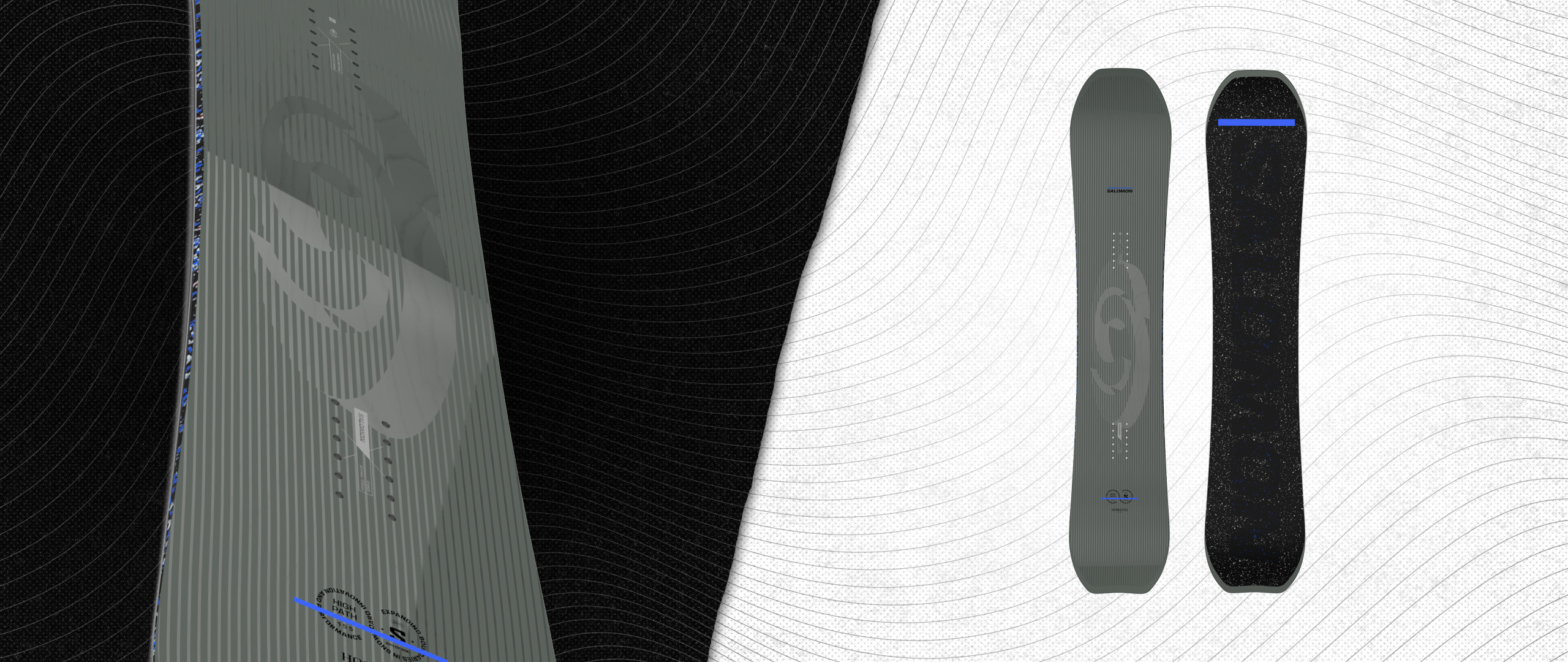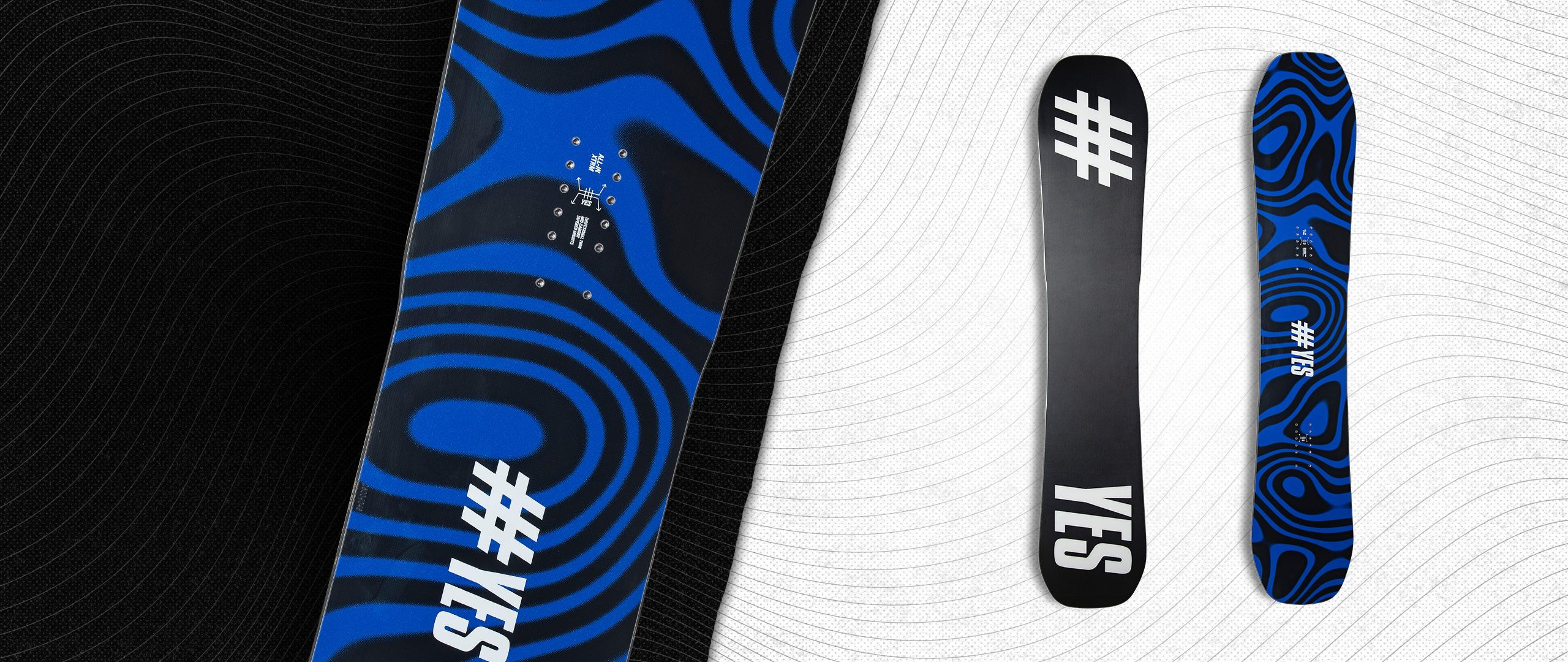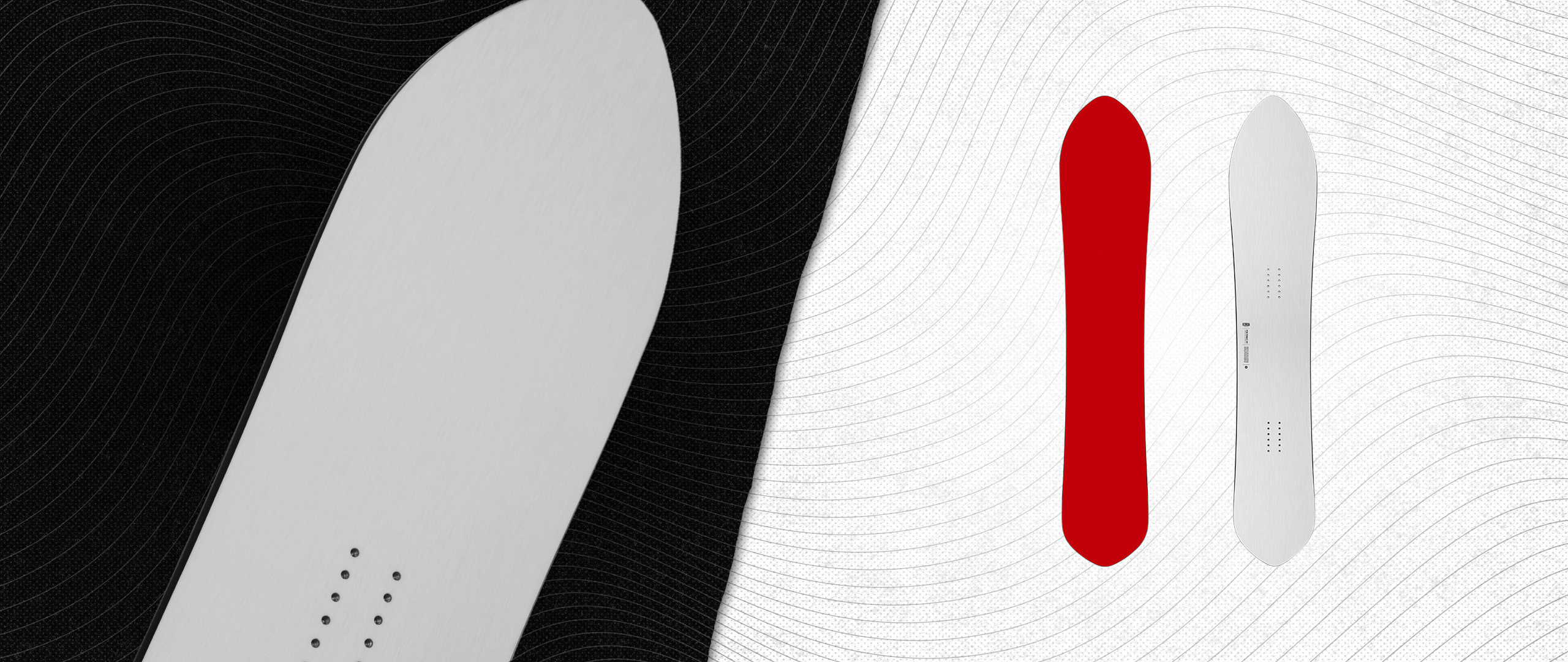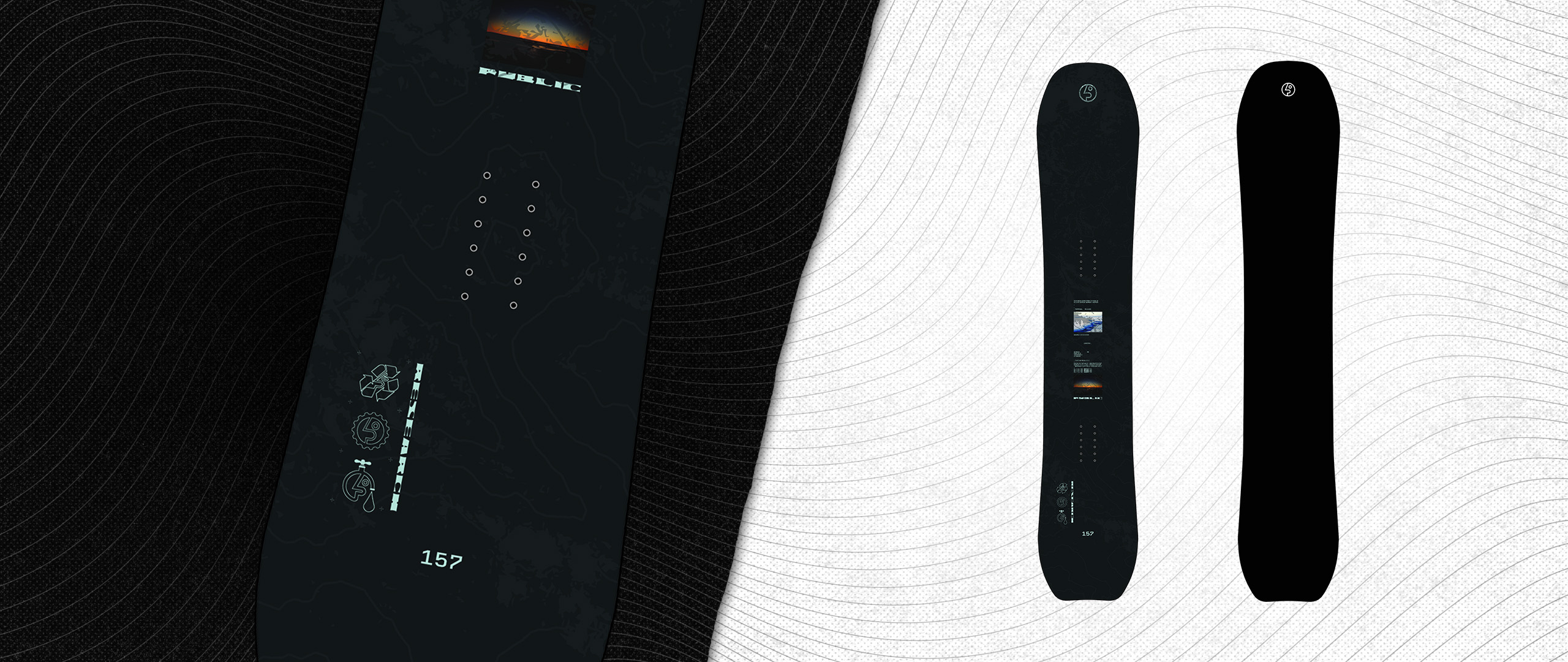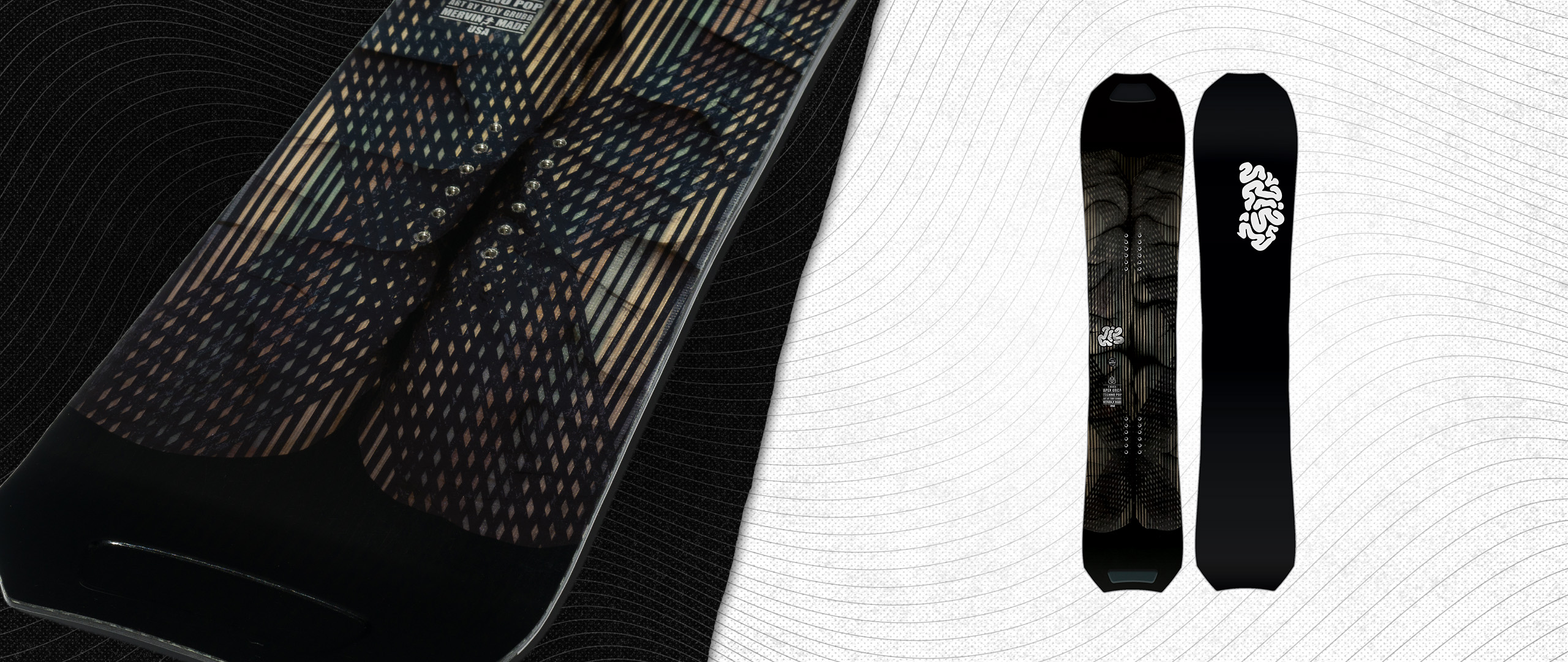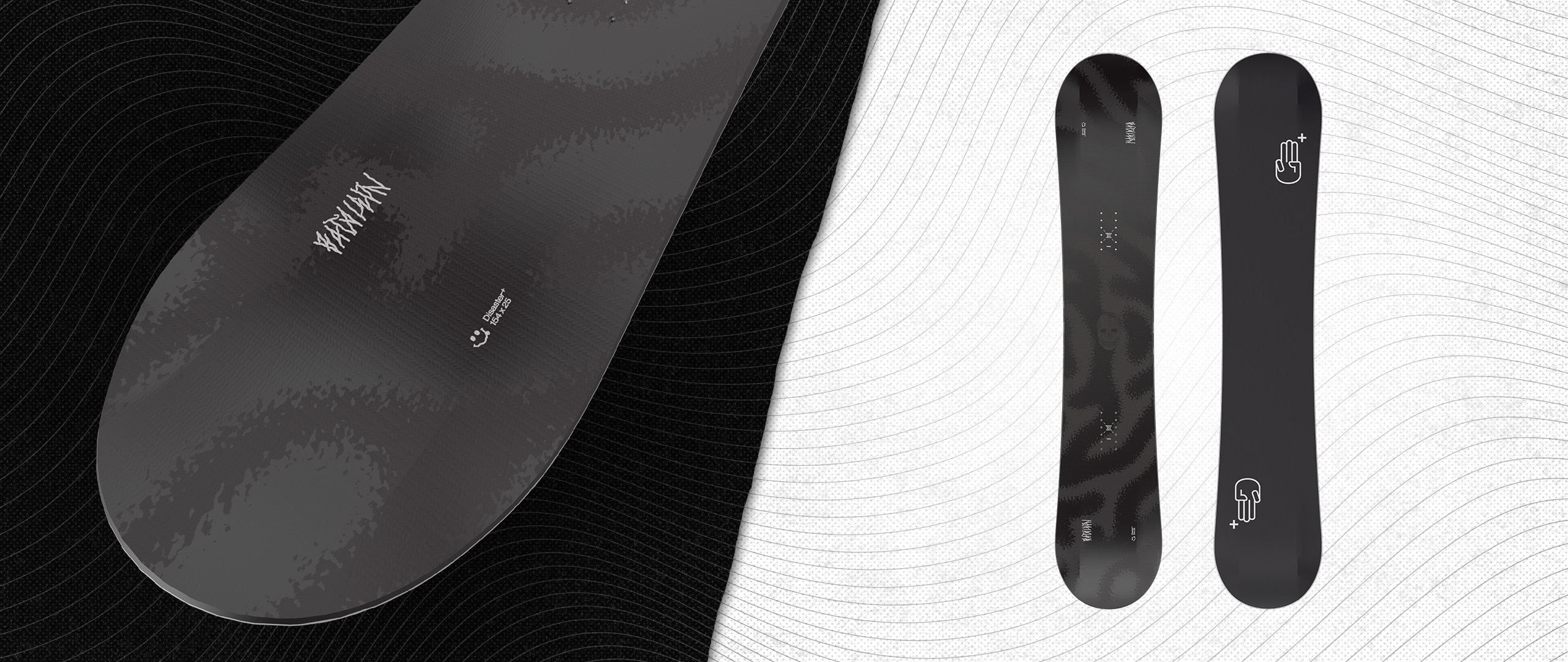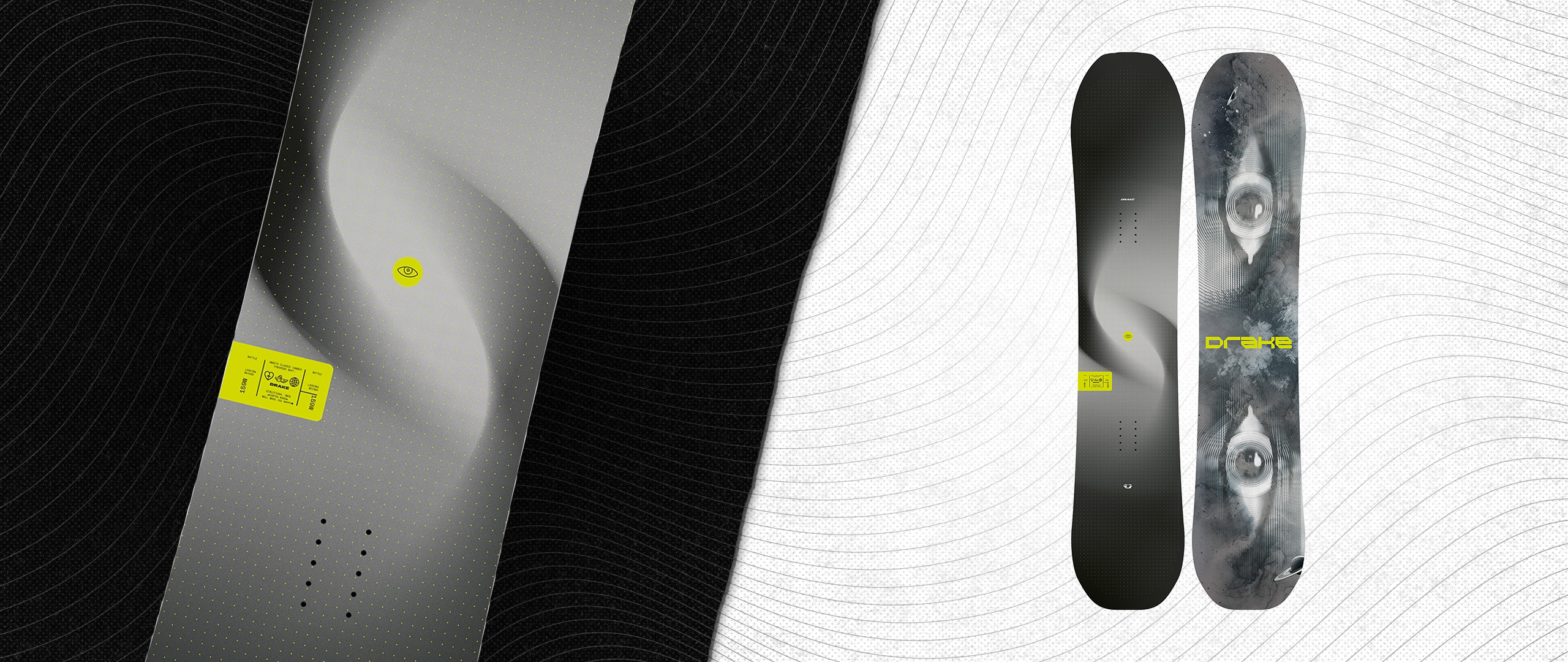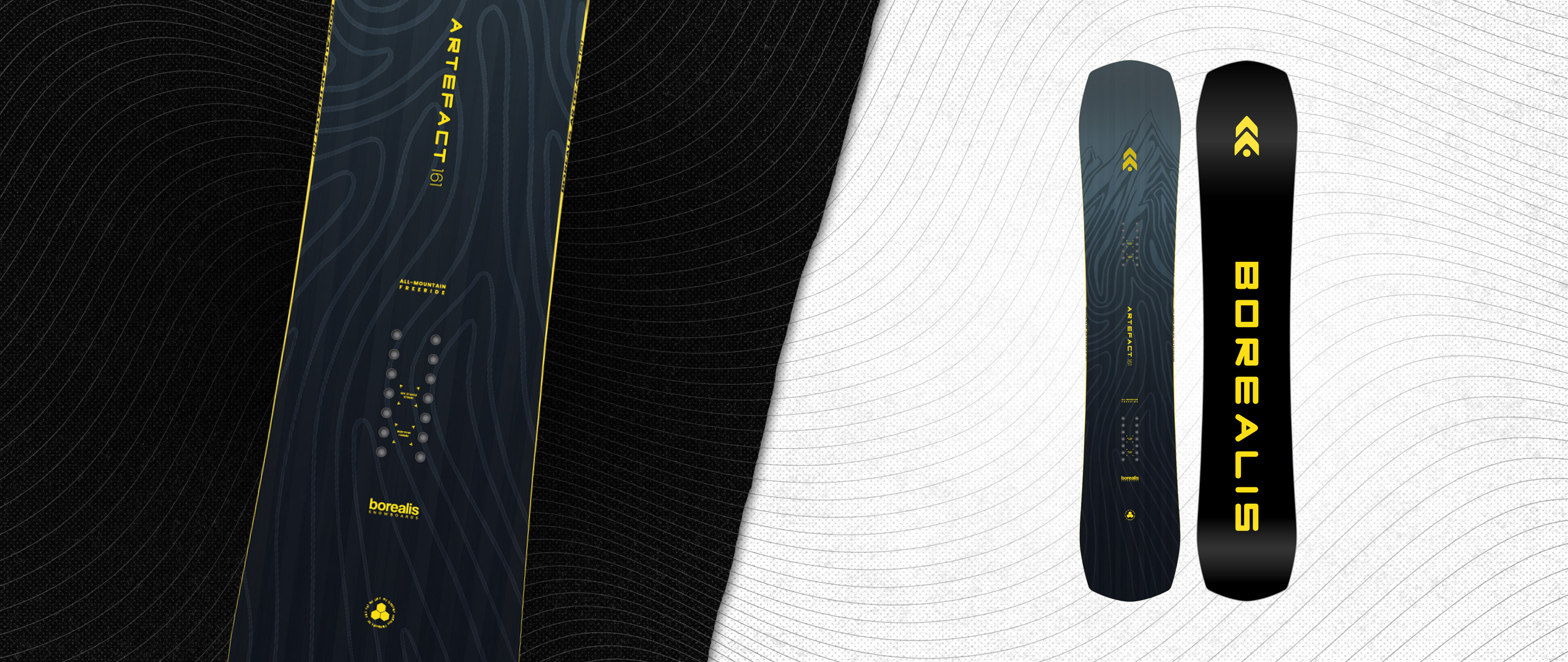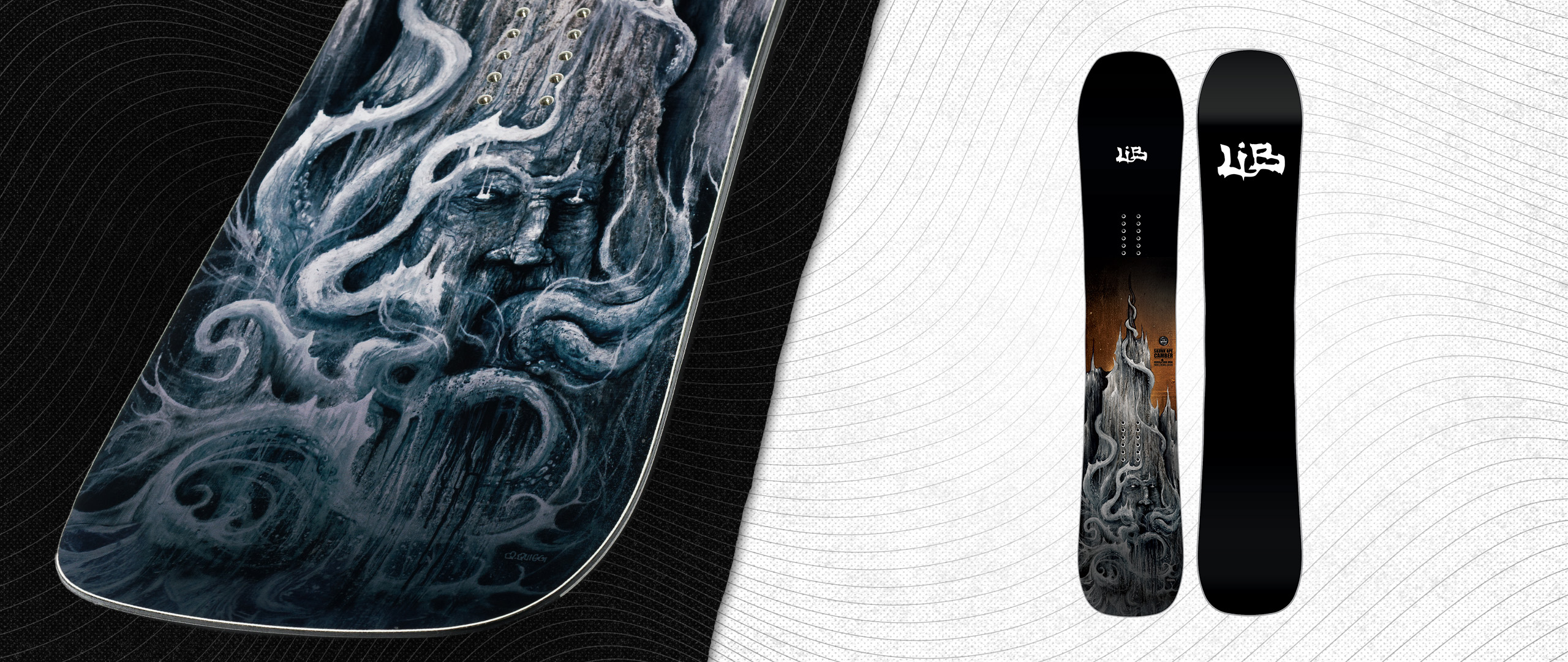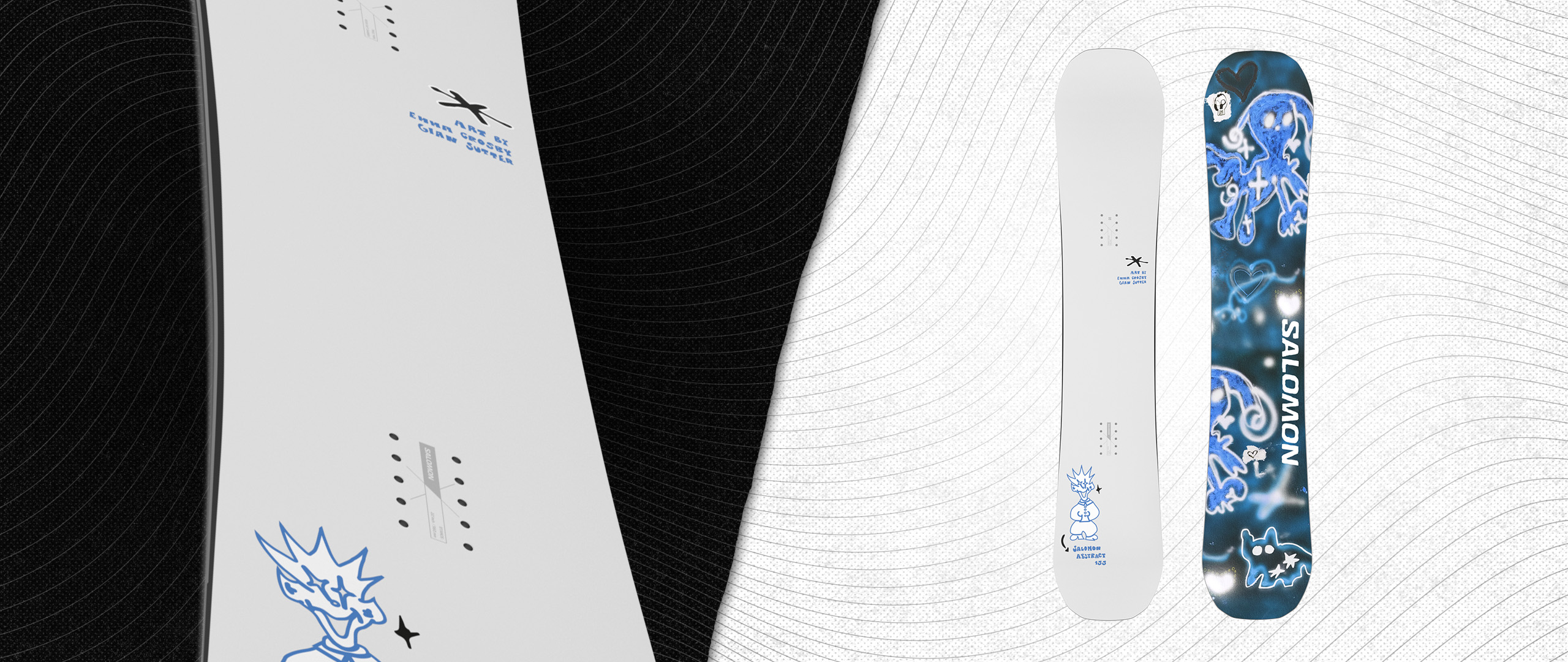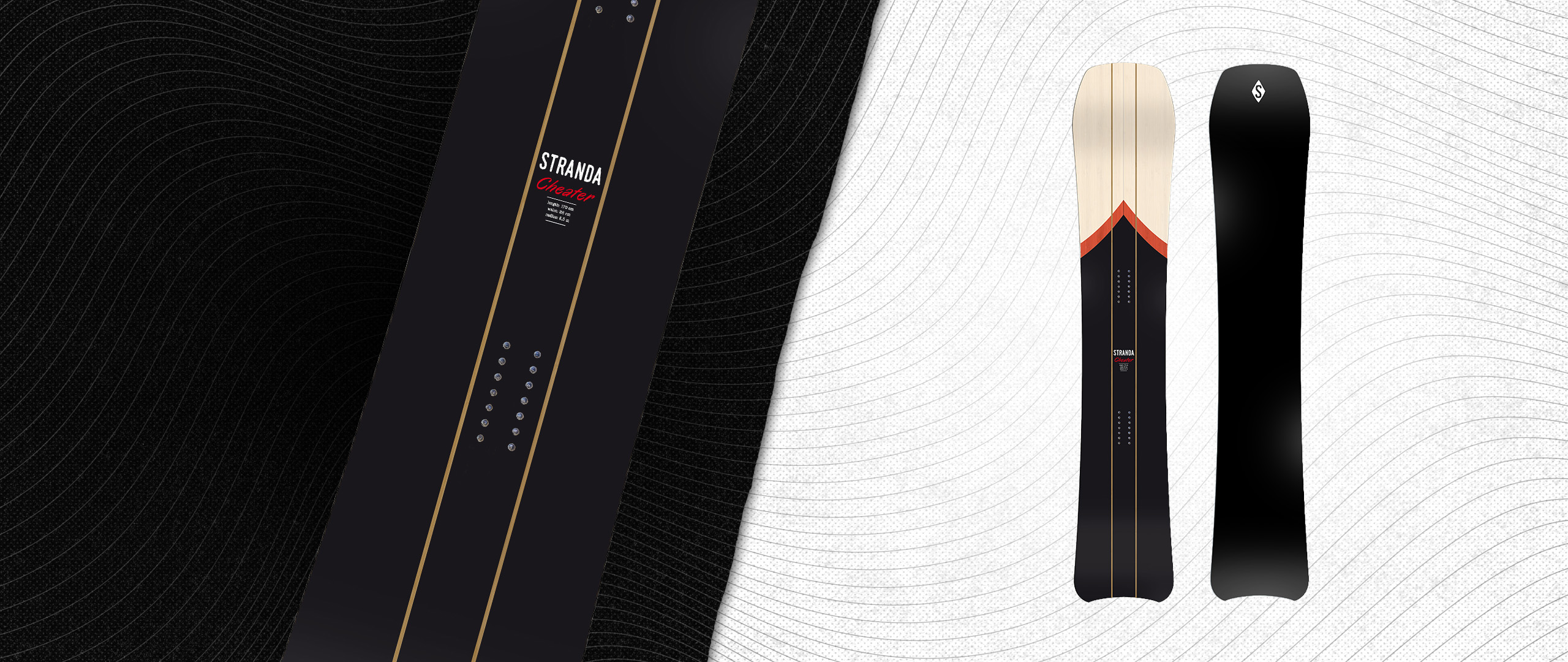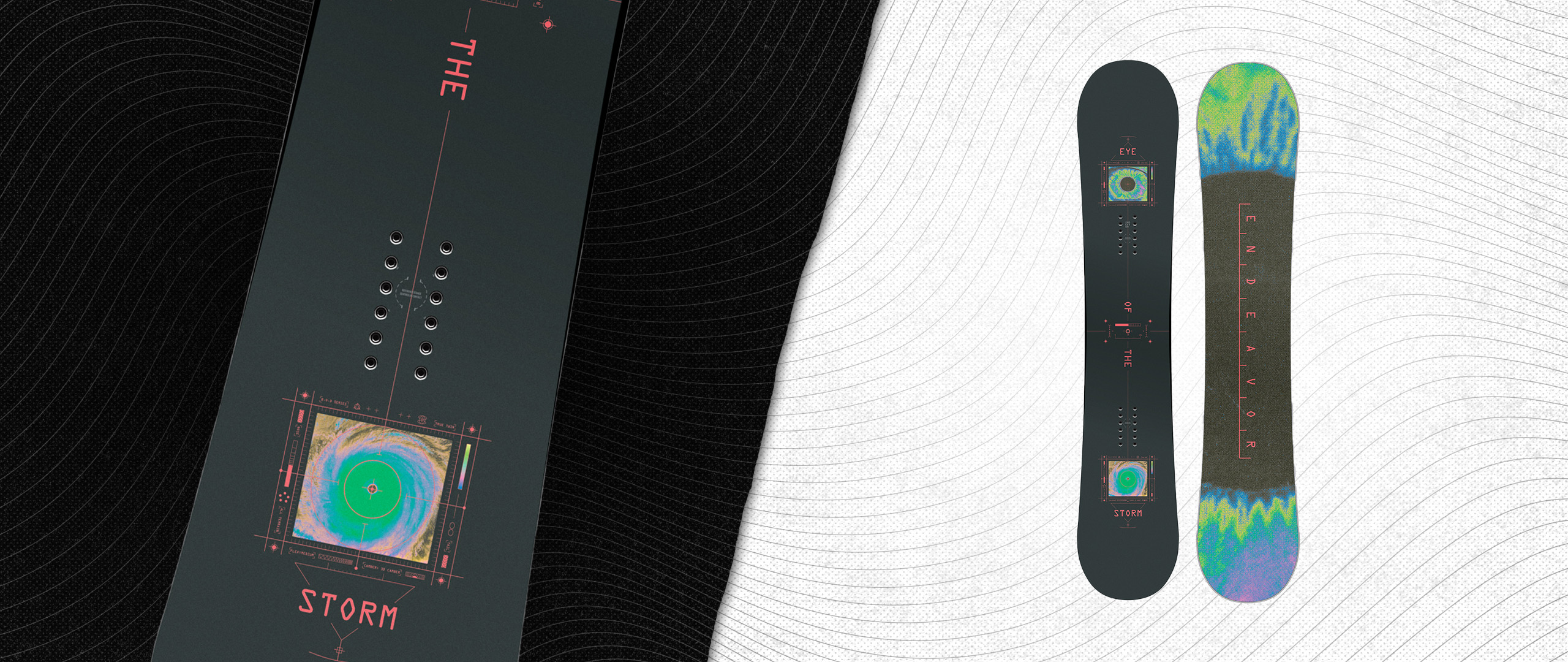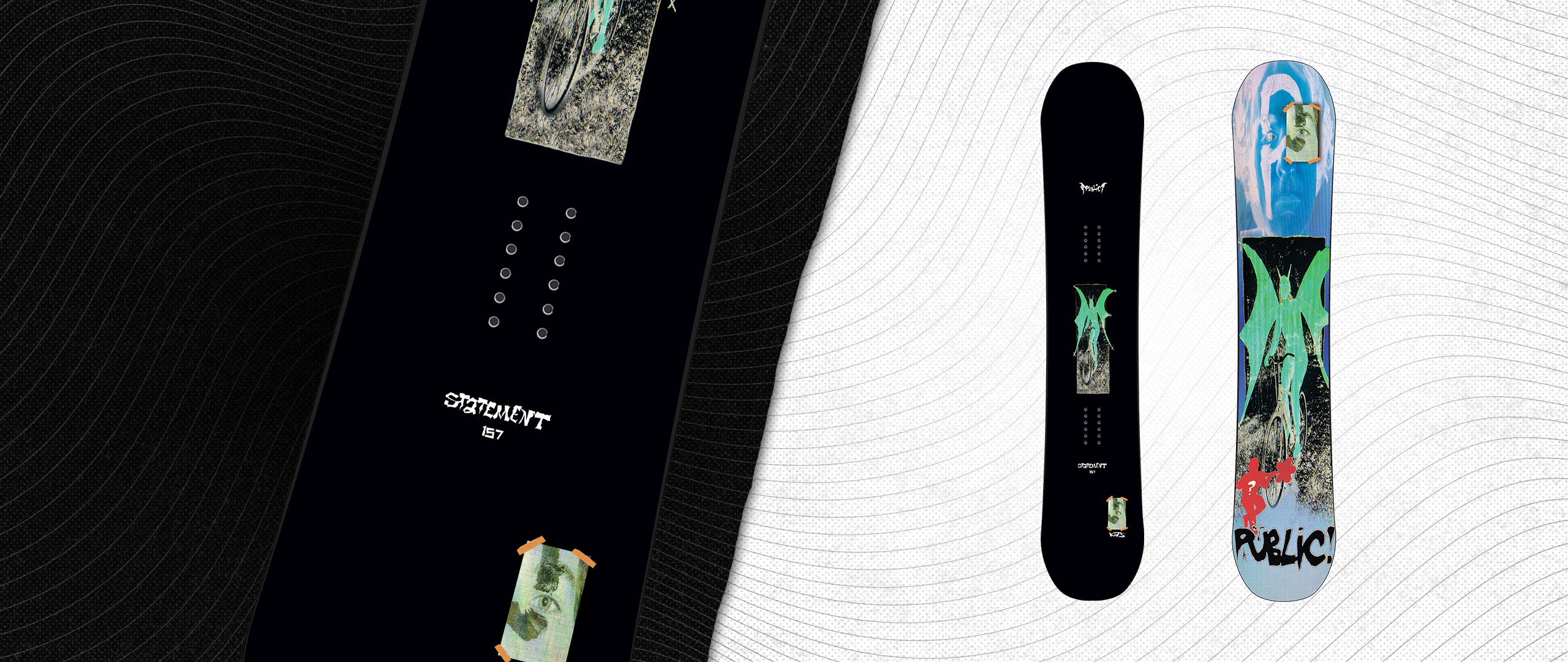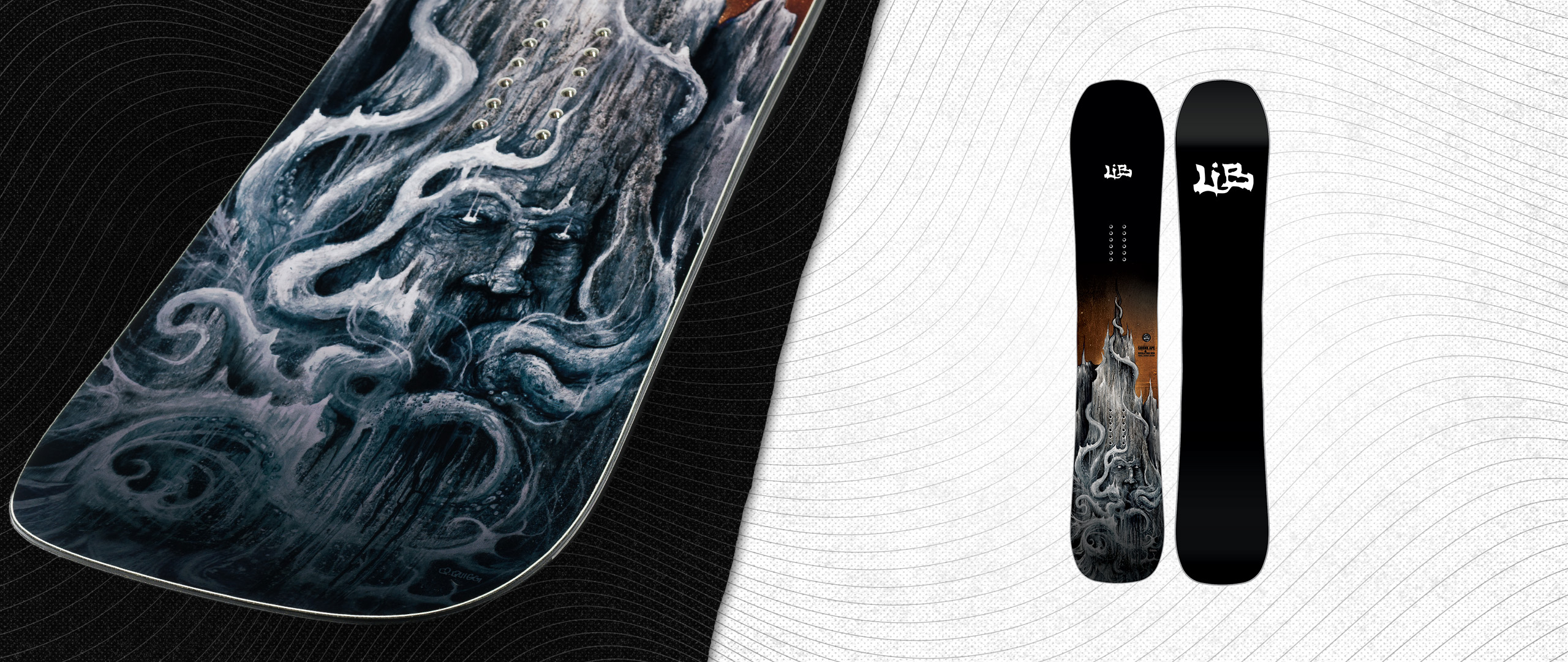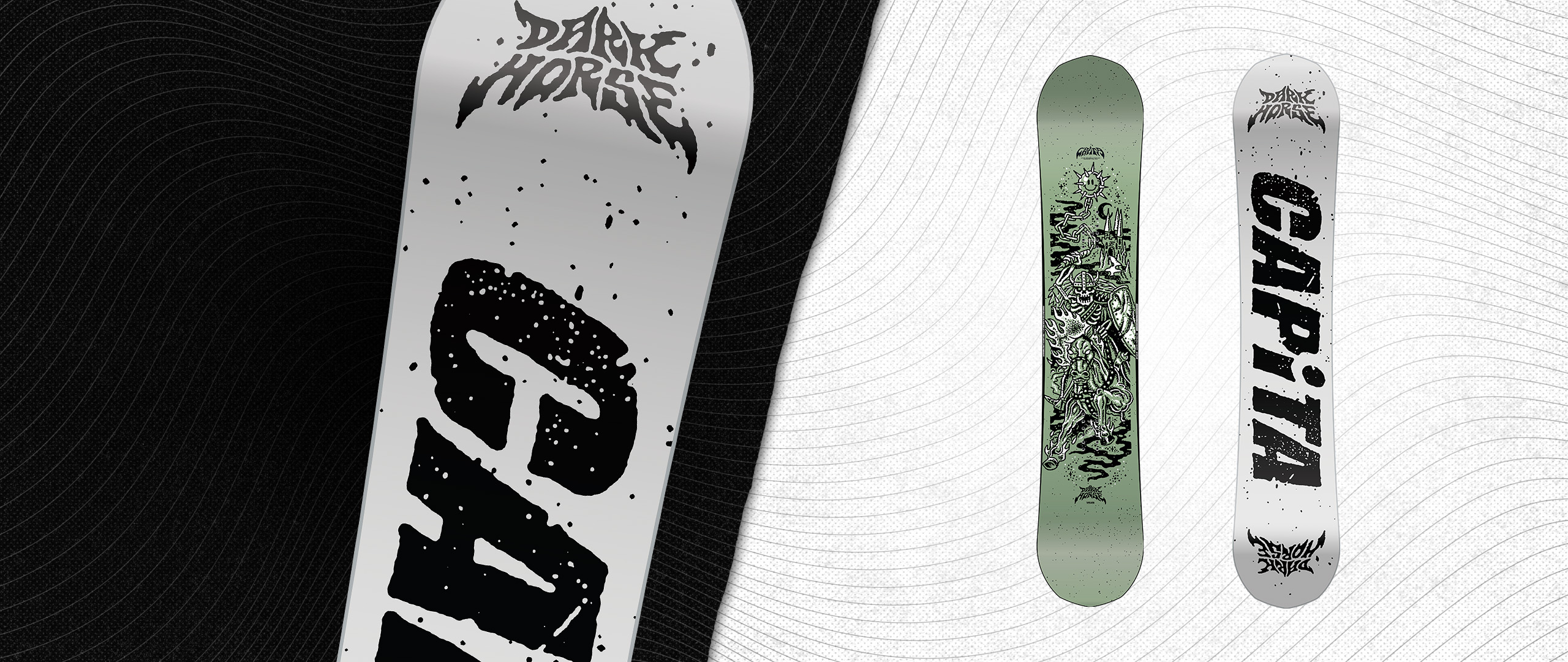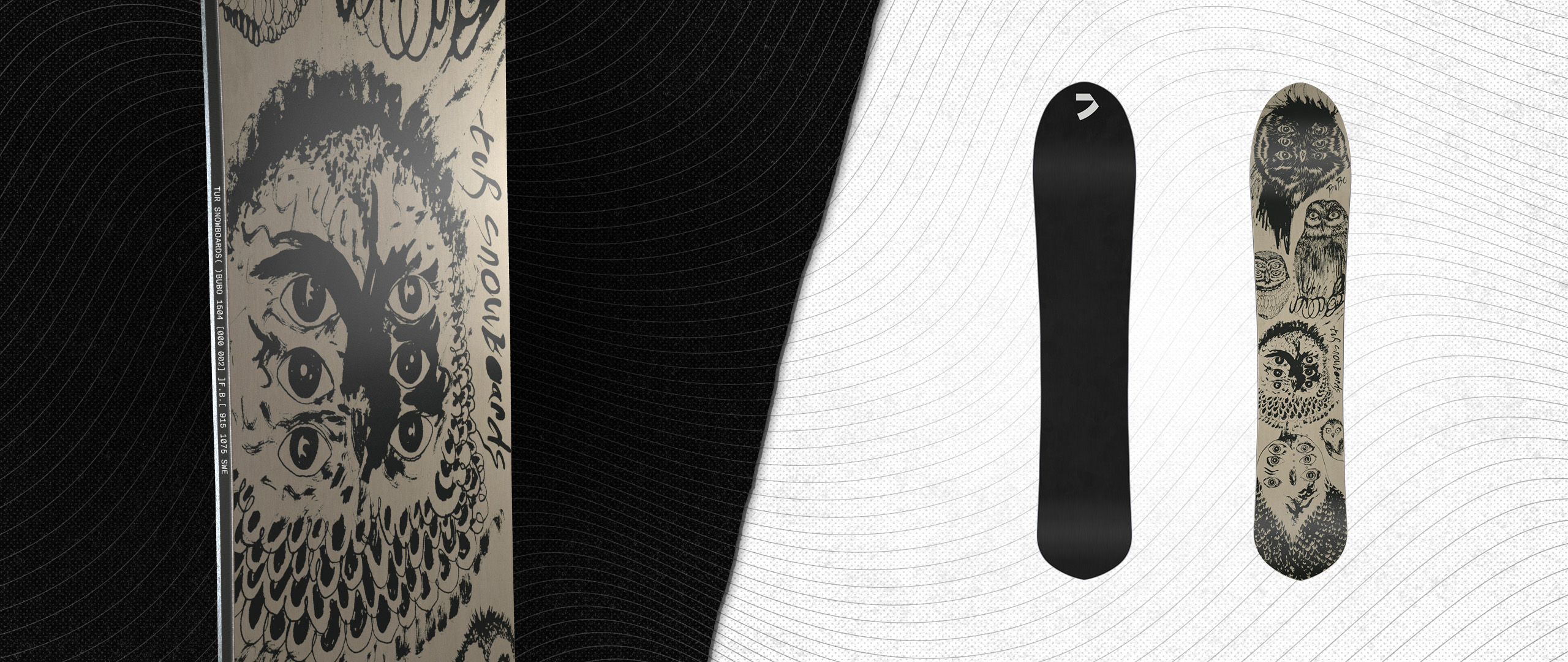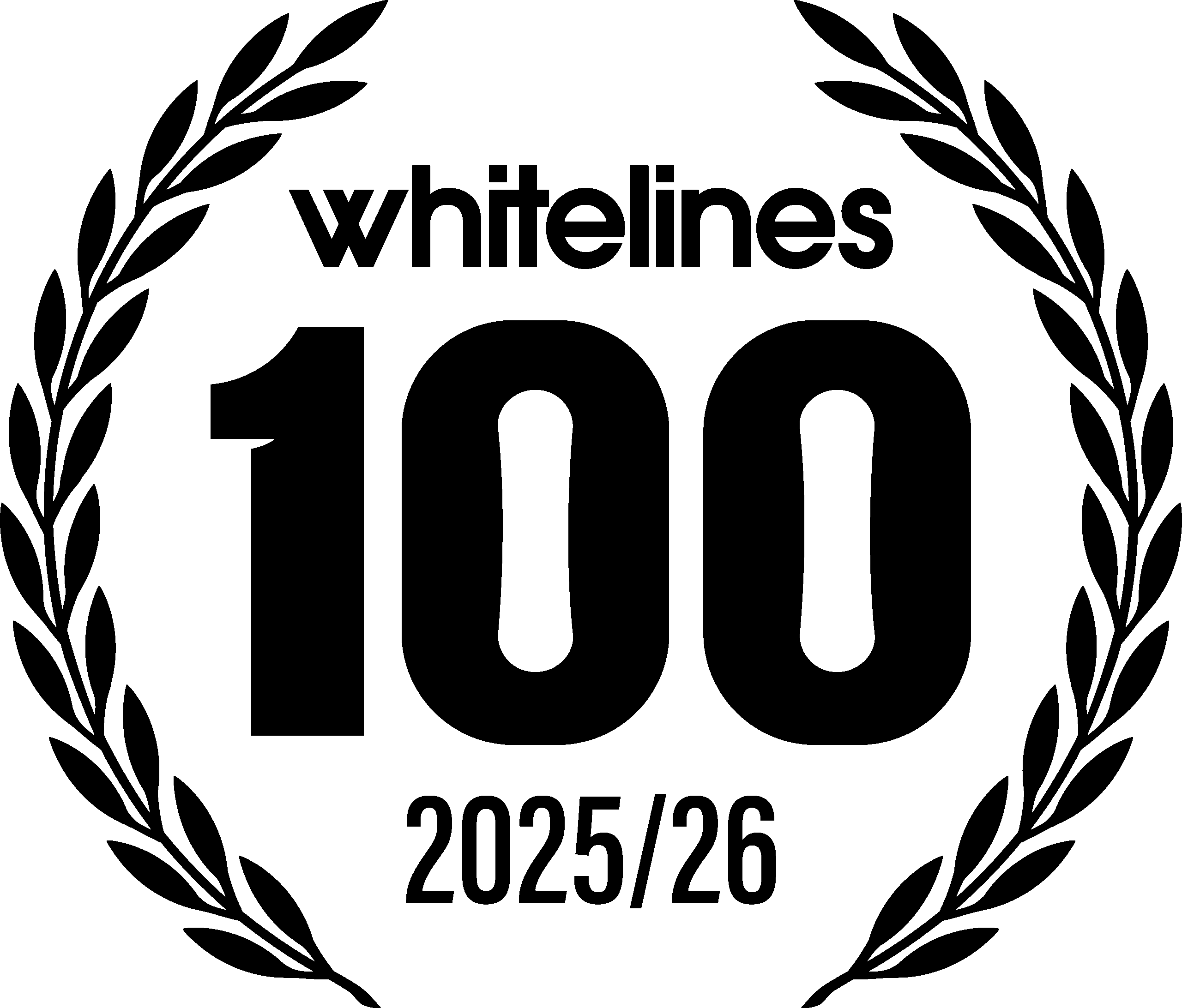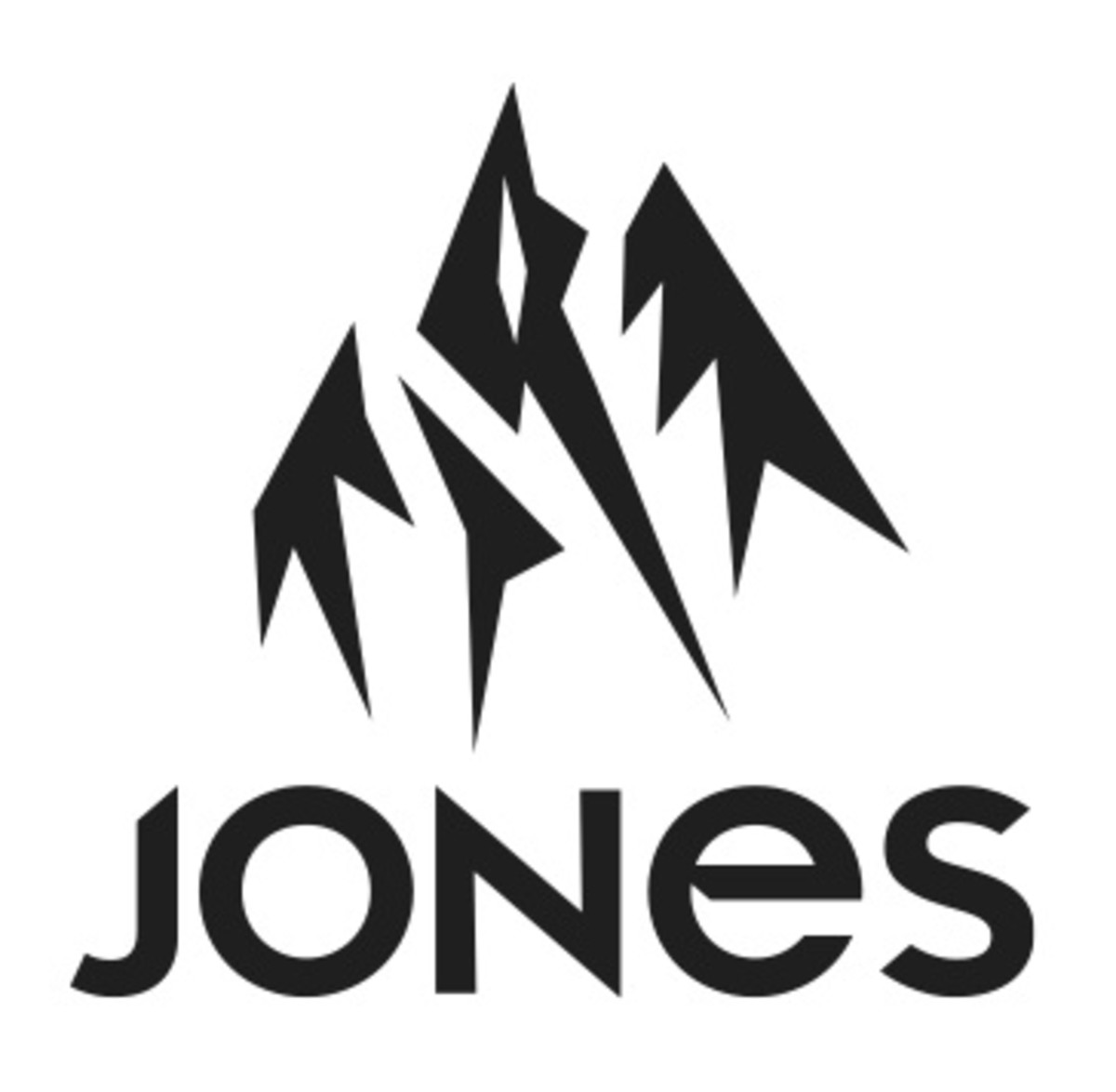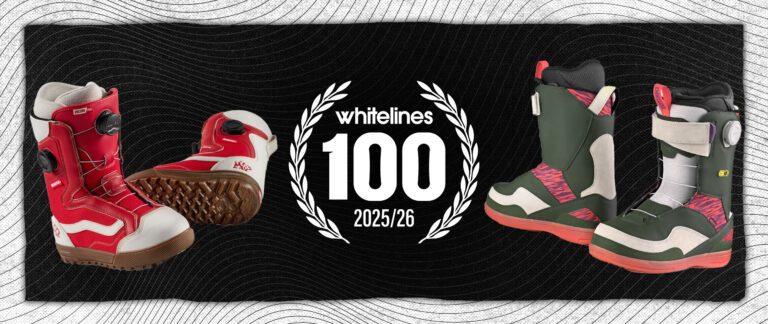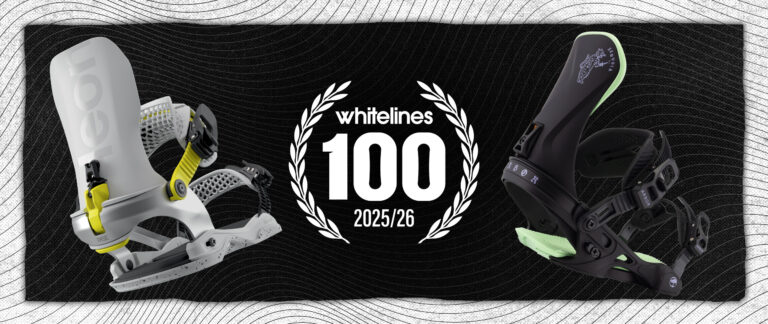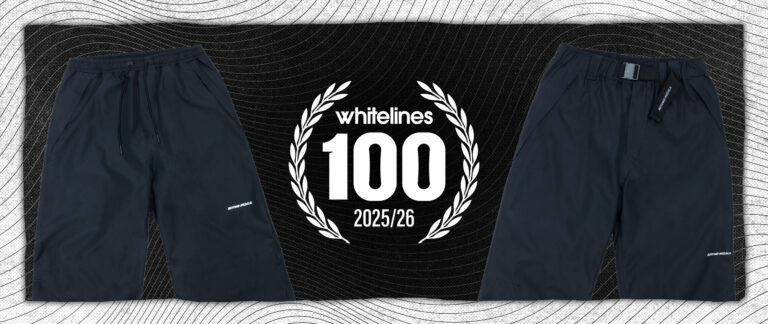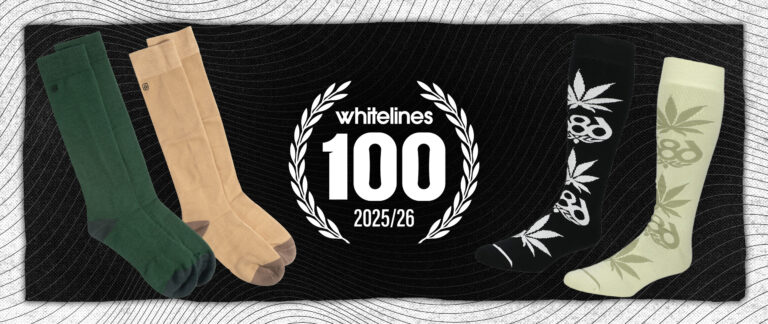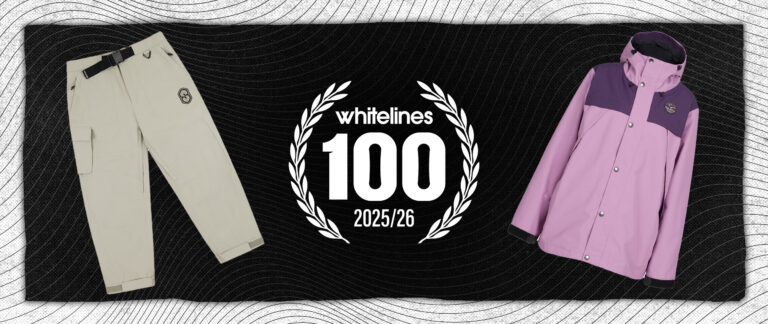Amplid Soulmate Snowboard 2025-2026
PRICE: £429 / €499 / $499
SIZES: 149, 153, 157, 161
FLEX: 6
SHAPE: Directional Twin
PROFILE: Camber
3D: No
BASE: Extruded
NEW FOR 25/26 SEASON: No
Why we chose the Amplid Soulmate:
The Amplid Soulmate proves that a quiver killer don’t necessarily have to do the same to your bank balance. A premium-feeling ride at a tasty price.
Who is the Amplid Soulmate for?
Despite Ryanair’s efforts to make “no frills” feel like something you’re condemned to, we know that plenty of riders see the appeal in carving out the unnecessary and focusing on the fundamentals – and that’s exactly what the Soulmate does. It’s also ideal for the relative novice that likes the idea of keeping their options open as they progress.
Tech Talk
Shape, profile, sidecut and construction materials
As you can probably guess, the shape is the star here. The Amplid Soulmate deploys a slight taper to the outline, a notch in the tail, and a short early-rise section in the profile to elevate a twin shape into something more all-mountain friendly. It really is a thing of beauty; one that even the simplistic one-colour topsheet – beige, no less – can’t disguise.
Construction-wise the extruded base, biax fibreglass and fully-poplar core are all tried-and-tested industry stalwarts. None of those will get the tech nerds excited, but then that’s not at all what the Soulmate is about. The clue’s in the name…
Tester Verdict
Jim Walker

“This is a lovely board to ride everywhere. Super smooth, fluid and agile edge-to-edge with great hold into deep carves, it’s perfect for hooning around in whatever conditions are thrown at you. It held up well on hard morning groomers, cut through the crud and afternoon slush and was an absolute dream in some late-season powder. There is enough pop to have some fun with it too. The only negative would be that it gets a little choppy over the bumps, but overall it was just loads of fun and made me smile.”
Buy the Amplid Soul Mate Snowboard 2025-2026: from €499 at AMPLID.COM

Nidecker Sensor Team Snowboard 2025-2026
PRICE: £449 / €470 / $500
SIZES: 147, 150, 153, 156, 159
FLEX: 6
SHAPE: True Twin
PROFILE: Camber
3D: No
BASE: Extruded
NEW FOR 25/26 SEASON: Yes
Why we chose the Nidecker Sensor Team:
It’s difficult for a true twin to stand out from the crowd, but the Sensor Team manages it. Nidecker’s brand new freestyle model is just so much fun to ride, blending a playful flex with a little extra width for stability. It’s the kind of board you feel confident on right away, which is exactly what you need in a park deck. Plus, the hidden doodles in the topsheet graphic will keep you entertained on many a chairlift ride.
Who is the Nidecker Sensor Team for?
Anyone that wants to get creative, in and out of the park. The ‘Team’ moniker might make you think this board is built for serious rippers, but it’s really super friendly. Side hits, kickers, rails, powder set-ups… if there’s a transition, this thing will find it. Weekend warriors and seasonaires alike will dig it – as will anyone with big-ish feet that doesn’t want to be lumped with a sluggish wide model.
Tech Talk
Shape, profile, sidecut and construction materials
There’s not much to report when it comes to the outline; we’re talking about a classic true twin that will ride just as well switch as forwards. As mentioned, the Sensor Team packs a little more width than the other models in Nidecker’s freestyle-focused Sensor collection, so it’s very stable on the in-run and landing, and floats pretty well despite its compact nose. Trad camber ensures it’s bang on trend, with all the edge grip and pop you need to rip off take-offs. The poplar/paulownia core is one of Nidecker’s lightest combos, and together with a biax fiberglass layup it’s tuned for a mid-stiff flex that won’t buckle during heavy landings but which is totally pressable even if you don’t boast the legs of a pro. There’s some carbon at the nose and tail for a little more ‘wuppah’, and traditional ABS sidewalls to keep the construction feeling bombproof. The N-7000 base claims to combine the low-maintenance durability of extruded with the speed of sintered p-tex; we found it to be plenty fast enough for the park but it definitely still benefits from a wax.
Tester Verdict
Pat Nichols

“The Sensor Team is just a really well balanced freestyle snowboard. It has a great camber profile that’s still quite forgiving, with plenty of pop and response. It’s a surprisingly damp ride and feels super stable on jumps. The flex profile was bang on the money; it feels even throughout the board with the sweet spot on the nose and tail being pretty large. This means that you can sit in the pocket comfortably, and I found you could crank a press right to the top of the board without it folding under you. Oh, and there’s enough torsional flex for buttery fun times too. I’d recommend this as a general park freestyle board to pretty much anyone that rides both rails and jumps.”
Buy the Nidecker Sensor Team Snowboard 2025-2026: from $500 at evo.com
Buy the Nidecker Sensor Team Snowboard 2025-2026: from £445 at BLUETOMATO.COM

Rome Stale Fish Snowboard 2025-2026
PRICE: $599.95 / €569.95
SIZES: 151, 154, 157, 160, 163
FLEX: 7
SHAPE: Directional
PROFILE: Setback Camber
3D: Yes
BASE: Sintered
NEW FOR 25/26 SEASON: No
Why we chose the Rome Stale Fish:
Ståle Sandbech’s signature board perfectly captures the Norwegian’s riding approach – creative, progressive, and keen to send it with serious style across any terrain.
Who is the Rome Stale Fish for?
You wanna ride it all, but you don’t want a boring board. No, you want something sexy – like Ståle! Whether you’re hunting powder stashes, launching natural features, or carving perfect euro turns on firm snow, this directional powerhouse handles it all with the confidence of a stubbly viking god. Phwoar! I mean, Thor!
Tech Talk
Shape, profile, sidecut and construction materials
For a board with such creative credentials, the Stale Fish features an aggressive directional design. With 15mm of taper – more than many powder boards – it’s built to slash and surf while maintaining excellent control on the groomers. The Free-The-Ride Camber profile provides reliable edge grip and pop, while the extended rocker towards the nose – alongside Rome’s Directional Diamond 3D shaping – enhances float and reduces hang-ups in variable snow. A single carbon HotRod down the centerline reinforces the flex without making the board overly stiff, maintaining the playful character Ståle is known for. A bi-radial sidecut keeps turn initiation smooth and predictable, while flax impact plates dampen vibrations for confidence-inspiring performance whether you’re stomping big airs or charging through chop.
Tester Verdict
Pat Nichols

“I couldn’t bring myself to give this board back to Rome last year. After a full winter of riding, I still love it. It’s perfect for carving, jumping, and throwing up massive powder slashes – and it absorbs heavy landings like it’s nothing. If you’re in the market for a resort ripper/all-mountain freeride board, look no further. 10/10.”
Buy the Rome Stale Fish Snowboard 2025-2026: from $600 at evo.com
Bataleon Whatever Snowboard 2025-2026
PRICE: $579.95
SIZES: 138, 144, 148, 151, 154, 157, 156W, 159W, 162W
FLEX: 5
SHAPE: Directional Twin
PROFILE: Camber
3D: Yes
BASE: Sintered
NEW FOR 25/26 SEASON: No
Why we chose the Bataleon Whatever:
Newly reshaped for Winter 26, the Whatever’s deceptive directional outline hides a twin contact surface, delivering the ultimate all-terrain board for riders who want to keep their quiver simple.
Who is the Bataleon Whatever for?
The Whatever embodies its name perfectly – it’s built for riders who want to do whatever, wherever. Whether you’re sessioning park features, surfing pow, or just running into Kiki at the beach, this board’s like “Yeah whatever.”.
Tech Talk
Shape, profile, sidecut and construction materials
The Whatever’s genius lies in its contradictions. While the updated outline appears strikingly directional, the contact surface remains true twin – offering the best of both worlds. Bataleon’s signature 3BT shaping provides medium nose and tail uplift, reducing edge catch while maintaining camber’s pop and precision. Under the hood, the Light Core keeps things lively, while carbon stringers add snap without sacrificing playfulness. Dual carbon “SuperTubes” enhance the board’s natural spring even further, and a sintered base delivers reliable glide from kicker in-runs to cat tracks. Urethane sidewalls provide enhanced dampening and durability, while BackSeat Inserts complete the package, creating a board that truly lives up to its anything-goes philosophy.
Tester Verdict
Maria Kuzma

“Playful and responsive energetic board. Great on piste holding an edge through turns and nice poppy ollies. Great also on the jumps and boxes. My favourite all mountain / freestyle board.”
Buy the Bataleon Whatever Snowboard 2025-2026: from $579.95 at evo.com

Arbor Kuro Neko Snowboard 2025-2026
PRICE: £535 / €599 /$520
SIZES: 141, 145, 149
FLEX: 5
SHAPE: True Twin
PROFILE: Camber
3D: No
BASE: Sintered
NEW FOR 25/26 SEASON: Yes
Why we chose the Arbor Kuro Neko:
Directly translated to ‘black cat’, the Arbor Kuro Neko is certainly an omen, but rather than a portent of doom, it puts the ‘super’ in superstitious.
Who is the Arbor Kuro Neko for?
While you don’t have to be bagging X Games medals to strap in, some experience riding a snowboard is definitely preferable here. With its freestyle-focused shaping and performance-oriented build, the Kuro Neko is a snowboard that allows confident riders to unlock their potential between the park ropes and beyond.
Tech Talk
Shape, profile, sidecut and construction materials
Arbor sticks to the classic triumvirate for a modern park board- true twin outline, dynamic camber profile and middle of the road flex. This is Goldilocks’ porridge in snowboard form, not too soft, not too stiff, juuuust right for freestyle domination. But that’s not to say it’s a one-trick pony, the positive bend found between the contact points is catnip for anyone who wants a dynamic and lively ride, ideal for blasting around resort.
A blended wood core with blunted tips keeps things footloose and fancy free when you’re throwing down aerial manoeuvres, whilst a high-end sintered base keeps things flowing underfoot, even in the late-season slush.
Tester Verdict
Sara Previte

“This board is targeted to a strong intermediate to advanced female freestyle rider. A bit stiffer, so it would be suitable for a smaller guy as well. Although a freestyle board, it railed turns and handled some light pow really well. Perfect for the girl who spends most of her time in the park but isn’t afraid to venture around the mountain.”
Buy the Arbor Kuro Neko Snowboard 2025-2026: from $519.95 at evo.com
Buy the Arbor Kuro Neko Snowboard 2025-2026: from €599.95 at BLUETOMATO.COM
Burton Counterbalance Snowboard 2025-2026
PRICE: $659.95 / €680 / £610
SIZES: 142, 146, 150, 154, 158, 162, 154W
FLEX: 7
SHAPE: Directional
PROFILE: Setback Camber
3D: No
BASE: Sintered
NEW FOR 25/26 SEASON: Yes
Why we chose the Burton Counterbalance:
Burton’s newest quiver-killer borrows DNA from their legendary Custom while adding modern tech that makes one board do what used to require three.
Who is the Burton Counterbalance for?
Riders of all sizes and sexes who want to surf pow when the lifts open, session the park when it’s tracked out, and hunt out side hits on the home run. It’s a genuine all-rounder with a slightly directional shape that will reward those who love to go fast and turn above all else.
Tech Talk
Shape, profile, sidecut and construction materials
All the talk is of this thing replacing the Deep/Free Thinker models. But in this writer’s opinion, The Counterbalance draws heavy inspiration from Burton’s mid-90s shapes – both the original Custom and the Johan Oloffson pro model. Both were slightly directional outlines that blurred the lines between freeride and freestyle; both helped define a generation of riding. The profile combines setback camber underfoot with extended nose rocker, delivering stability through variable conditions while providing effortless float in soft snow. Burton’s patent-pending Squeezebox core technology varies thickness throughout the board – thinner sections underfoot increase flex and manoeuvrability, while beefier areas outside the stance provide stability and snap when carving or boosting. The Super Fly II core keeps weight down without sacrificing durability, while 45° Carbon Highlights add tip-to-tail carbon reinforcement for precise energy transfer and reduced weight. The board is also available in dual graphic options as part of Burton’s new gender-neutral sizing system – skate-deck-like ‘Hallucinate’ and 90s-looking ‘Deco’. Choose your poison.
Tester Verdict
Ed Leigh

“I’m not usually a big Burton fan. I find the Channel system can affect the flex, plus I tried this board with a very loose Step On set-up, so the odds were very much against it. Full credit to the Counterbalance, though – it still shone. This is a lovely board, definitely on the softer side for a freeride board but it had a lively shape for turning, held well and was stiff in the right places. Playful gets thrown around a lot, but it was very easy to manipulate and place.”
Buy the Burton Counterbalance Snowboard 2025-2026: from $659.95 at evo.com

Borealis Drakkar Snowboard 2025-2026
PRICE: £559 / €649 /$749
SIZES: 158
FLEX: 7
SHAPE: Directional
PROFILE: Hybrid
3D: No
BASE: Sintered
NEW FOR 25/26 SEASON: No
Why we chose the Borealis Drakkar:
It was a Whitelines Team favourite before, but with some choice upgrades and a specc’d up build, the Borealis Drakkar truly lives up to its Viking longship namesake- intimidating, sleek, fast and, of course, hellishly furious.
Who is the Borealis Drakkar for?
They say don’t judge a book by its cover, but with the Borealis Drakkar, you absolutely can, and should. It’s unabashedly a freeride cannon, I mean, could you ride it through the park? Sure, the same way you can drive a Bugatti Veyron through the stop-start traffic in NYC. These hogs flourish when they’re gunning it on the open road and thrive in the steep and deep. If that sounds like your bag, then come on in. If not, maybe look towards the more adaptable Artefact instead.
Tech Talk
Shape, profile, sidecut and construction materials
More than 10 years of R&D have gone into finetuning the Borealis Drakkar into the powerhouse it is today, with some subtle tweaks over the past season that have turned all the dials up to 11. The entire front end has been reconstructed to ensure the utmost precision, from the elegant nose shape to the newly floaty rocker shifting back into the redrawn sidecut, all 3 working in unison to offer float in the deeper snow and rock-solid hold on the hardpack.
As you move down the Drakkar, you’ll notice the prominent taper and swallow tail, both adding to its prowess in the pow, whilst the carbon crossbracing sandwiched between reactive triax fibreglass in the tail allows you to drive power through that all-important back foot when the conditions require top-notch response.
Tester Verdict
Tristan Kennedy

“The Drakkar was apparently the first snowboard Borealis built, and has featured in their line for over a decade. But the 2026 version has various tweaks. Having not ridden a Borealis snowboard before, I can’t comment on how the new nose job they’ve given to this compares to the old one — what I can say with confidence is that this board absolutely rips in variable conditions, which is what they are aiming for. It’s short enough to turn on a dime, stiff enough to charge through crud, and floaty enough to sail through powder with ease.”
Buy the Borealis Drakkar Snowboard 2025-2026: from £480 at BOREALIS-SNOWBOARDS.COM

Rome Rene-Gade Snowboard 2025-2026
PRICE: €600 / $630
SIZES: 153, 156, 159, 157W, 160W
FLEX: 9
SHAPE: Directional Twin
PROFILE: Camber
3D: No
BASE: Sintered
NEW FOR 25/26 SEASON: No
Why we chose the Rome Rene-Gade:
Rene Rinnekangas’ signature model embodies everything the Finnish freestyle legend stands for – technical precision, fearless commitment, and authentic style.
Who is the Rome Rene-Gade for?
The Rene-Gade is an uncompromising machine for riders who charge pipes, stomp technical tricks, and need a board that rips as hard as they do. If that sounds like you, congrats – you just found your Excalibur.
Tech Talk
Shape, profile, sidecut and construction materials
From its 90s graphic to the trad camber profile, the Rene-Gade represents everything that made classic pro models legendary. That positive bend from tip to tail delivers maximum pop and edge hold, while the directional twin shape provides great drive and pow float while maintaining switch capability. Rome’s most responsive HotRod package – Directional Triple HotRods with Carbon Omega technology – creates a board that’s incredibly stiff laterally, with enough torsional play for technical rail work. Flax impact plates dampen heavy landings, while the SinterSpeed base ensures you’ll clear every gap. Last up, a radial sidecut keeps things predictable and locked-in – perfect for riders who need their gear to respond exactly as expected when the stakes are high.
Tester Verdict
Rakai Tait

“I took the Rene-Gade straight into a pipe run and this thing was a beast. It felt like a rocket ship and really wanted to go – you’ve definitely got to be ready for it! It feels like a true pro model which is pretty rare these days. It’s super stiff laterally but still has a bit of play torsionally which gives you a great lock on the rails mand you feel like you’ve got really solid landing gear underneath your feet when your pulling tricks and jumps, so if you land back seat you know it’s going to bring you back. You can really rail it too, it cuts like a knife; you can just do whatever you want with it! Definitely a high-performance freestyle board, not for the faint hearted!”
Buy the Rome Rene-Gade Snowboard 2025-2026: from $629.95 at evo.com

Nidecker Alpha Snowboard 2025-2026
PRICE: $519.95 / £479 / €499.95
SIZES: 148, 153, 158, 162W
FLEX: 4
SHAPE: Directional
PROFILE: Setback Camber
3D: Yes
BASE: Extruded
NEW FOR 25/26 SEASON: No
Why we chose the Nidecker Alpha:
Nidecker’s Bio Series has proven itself over a few years now. These boards blend eyecatching shapes with serious technology, led by the all-terrain Alpha model. Plus, the latest version boasts one of the nicest graphics we’ve seen this year – seriously, the topsheet and base on this thing are goddamn gorgeous.
Who is the Nidecker Alpha for?
The Alpha is built for riders who prioritize flow over brute force. Think Mathieu Crepel. Whether you’re carving deep pow turns, threading technical tree lines, or just want a board that makes every descent feel effortless, the Alpha encourages creative line choice and smooth riding style. And while it’s obviously great in natural terrain, it works brilliantly for anyone seeking an all-round resort board that can handle switch take-offs and landings when needed.
Tech Talk
Shape, profile, sidecut and construction materials
The Alpha features a directional silhouette with a slightly pulled-in tail to help it sink better in deep snow, but it’s not a pure powder board at all – there’s still plenty of party in the back, as the modern mullet kids say. The nose is slightly spooned to help glide through turns and surf over slush and chop. The ‘Surfy CamRock’ profile is essentially a setback camber that’s grippy underfoot with a little more lift in the nose. The full length ‘Master Core’ blends poplar and paulownia, with carbon at the tip and tail to add snap to your ollies and dampen the ride. The layup includes sandwich construction and a dense extruded base that’s the best in its class, but if you wanna spice things up there’s an APX version with a sintered base and wraparound Power Rails for more knife-like performance.
Tester Verdict
Chris Kyte

“This board’s got your back. It had great edge hold, even through ice on a dicey heelside turn. The ample nose kept me floating in the soft stuff.”
Buy the Nidecker Alpha Snowboard 2025-2026: from $519.95 at evo.com
Buy the Nidecker Alpha Snowboard 2025-2026: from €549.95 at BLUETOMATO.COM

Bataleon Cameleon Snowboard 2025-2026
PRICE: $689.95
SIZES: 149, 153, 157, 161
FLEX: 5
SHAPE: Directional
PROFILE: Camber
3D: Yes
BASE: Sintered
NEW FOR 25/26 SEASON: No
Why we chose the Bataleon Cameleon:
The Cameleon proves that changing colors isn’t just for reptiles – this legendary shape-shifter excels from tight resort turns to effortless powder surfing.
Who is the Bataleon Cameleon for?
Riders seeking maximum versatility without compromise. Whether you’re threading tight trees, floating through open pow fields, or just charging the resort, the Cameleon adapts to all conditions. It’s the go-to choice for adventurous riders looking to break out of the usual twin-shaped box.
Tech Talk
Shape, profile, sidecut and construction materials
The Cameleon’s directional DNA excels across varied terrain, while the playful “FlexTail” provides enough clearance to stick the occasional switch landing. The Ultra Light Core paired with carbon stringers delivers lively response while keeping weight down. DRST SuperTubes (six carbon tubes) provide exceptional pop and camber retention, while the high nose uplift and medium tail uplift create that magical triple base float when the powder gods oblige. A sintered Ultra Glide S base takes care of any speed concerns, and urethane sidewalls add a touch more durability and vibration dampening.
Tester Verdict
Ed Leigh

“I was looking forward to how playful this board might be – and it was – but you did have to be super assertive. You really have to dive into the turn due to the wide nose, but the carbon stringers in the tail are effective at stopping it washing out, so it is very much a usable resort board. That said, this board really comes to life when you get it into deeper snow. I had a smile on my face from top to bottom of our heli-run on test. The moment that nose gets into deep snow, it just rolls away – it’s an effortless turner. Even in spring corn it was just a joy to ride.”
Buy the Bataleon Cameleon Snowboard 2025-2026: from $689.95 at evo.com
Buy the Bataleon Cameleon Snowboard 2025-2026: from €659.95 at BLUETOMATO.COM

Amplid Ohana Vibes Snowboard 2025-2026
PRICE: £509 / €599 / $599
SIZES: 156
FLEX: 7
SHAPE: Directional
PROFILE: Camber
3D: No
BASE: Extruded
NEW FOR 25/26 SEASON: Yes
Why we chose the Amplid Ohana Vibes:
Just look at it! This volume-shifted shape is just crying out to be taken to its natural habitat – big ol’ pow fields. Don’t let it down.
Who is the Amplid Ohana Vibes for?
Like everything in Amplid’s Future Shapes series, the new Ohana Vibes will attract the unconventional riders who want to savour every turn. The single size won’t be a good fit for everyone, but those who qualify are in for a treat. Fans of sustainability will appreciate the ‘two season’ approach too.
Tech Talk
Shape, profile, sidecut and construction materials
The main difference between this and its predecessor, the Amplid Aloha Vibes, is the slimmer (yet still relatively hefty) waist. To compensate, it’s a couple of centimetres longer, so not quite as much of an oddball as before.
Mellow-flexing biax fibreglass makes it easy to twist for a big ‘un; while there is carbon in the build, it runs from end to end for additional pop. The mostly camber profile helps in that regard as well, with just a smidge of rocker in the nose to improve the already formidable powder float. It’s certainly no all-rounder, but the hardpack-friendly longer sidecut and subtle taper mean that you don’t need to wait for dumps.
Tester Verdict
Pat Nichols

“Wicked fun little board. Feels like the capita slush slasher had a performance tune.
Sadly no powder on test day but plenty of slush, chop moguls and side hits and this thing took it all in its stride. Also has surprisingly deep bags of pop for such a shaped tail.
Carving was pretty good but not the best grip I’ve experienced and I did lose the tail at times.
But for a fun, powder, slush and resort rat it’ll be good craic”
Buy the Amplid Ohana Vibes Snowboard 2025-2026: from €599 at AMPLID.COM

Rome Ravine Pro Snowboard 2025-2026
PRICE: $669.95 / €629.95
SIZES: 152, 155, 158, 161, 159W, 162W, 165W
FLEX: 8
SHAPE: Directional
PROFILE: Camber
3D: Yes
BASE: Sintered
NEW FOR 25/26 SEASON: No
Why we chose the Rome Ravine Pro:
Rome completely redesigned their aggressive freeride flagship – the result is a board that demands respect and rewards commitment on natural terrain.
Who is the Rome Ravine Pro for?
Serious freeriders who live for steep lines and deep powder days will find their perfect match here. This board thrives on wind lips, cliff drops, and charging through variable conditions. There’s some freestyle DNA in here too, but the aggressive flex of the Pro version isn’t for weekend warriors – it’s built for high speeds and heavy landings.
Tech Talk
Shape, profile, sidecut and construction materials
The redesigned Ravine Pro is Rome’s statement piece for aggressive all-mountain riding. Its Free-The-Ride Camber profile delivers maximum edge grip and explosive pop, while 7.5mm of taper helps it float and turn in deep snow without sacrificing anything on the groomers. The Directional Diamond 3D nose sails over bumps and crud, while Directional Double HotRods provide carbon reinforcement exactly where you need it for powerful energy transfer. Impact plates dampen heavy landings, while (deep breath) the Directional Tri-Radial sidecut offers precise turn initiation with smooth exit. A premium sintered base ensures you’re first back to the lift, while that stiff flex delivers instant response with just enough give to get creative – provided you’ve got the chops to show it who’s boss.
Tester Verdict
Pat Nichols

“This board feels super responsive. It’s got wicked edge hold for carving, and the new shape creates a smoother feeling through the nose – it looks sick too. There’s still enough flex to manipulate the board when needed, and switch riding is easier than you think – it really handles jumps well. My personal take? Really f**king fun for anything other than rails and butters.”
Buy the Rome Ravine Pro Snowboard 2025-2026: from $669.95 at evo.com

Drake DFL Snowboard 2025-2026
PRICE: €439
SIZES: 145, 148
FLEX: 7
SHAPE: Directional Twin
PROFILE: Camber
3D: No
BASE: Sintered
NEW FOR 25/26 SEASON: No
Why we chose the Drake DFL:
We love a bit of bang for our buck, and the DFL’s a nifty little board with a bunch of all-terrain adaptability for the price.
Who is the Drake DFL for?
We’d say it’s a bit too much snowboard for a beginner who’s still finding their feet, but any rider who can confidently cruise will find something to enjoy here. As a ‘Jacqueline of all trades’, the DFL would suit those looking to expand their horizons across a variety of terrain and experiment with different riding styles without having to invest in an entire quiver of snowboards.
Tech Talk
Shape, profile, sidecut and construction materials
Versatility is the name of the game with the Drake DFL, with the design team using tried and tested ingredients to create a snowboard that’s as happy munching miles on the hardpack as it is sniffing out powder stashes and gobbling sidehits. With its directional twin shape and 20mm setback, you’re able to easily shift your weight over the tail to keep the nose up and out in deeper snow. On the hardpack, the positive camber bend offers stability at speed, solid edge hold and a dynamic personality for pumping in and out of turns. And thanks to the cambered bend and blunted tips, you’ve got a lowered swing weight and a snowboard that wants to pop, lock, press and spin.
Tester Verdict
Simona Silvestri

“The DFL is a great all-rounder. I tested it on a day of riding mostly red and blue runs in Val Gardena, and was impressed by the edge hold, the ease with which it turned and the speed of the base. My regular board is definitely a bit stiffer, so that’s what I’m used to, but I think the soft flex of this would be great for more intermediate riders, and people who spend a lot of time on the pistes. Unfortunately, I didn’t get to try it in powder (it wasn’t a very good winter in the Dolomites!), but I guess it would handle OK, although my preference would be for a stiffer board.
Personally, the pink colour is a bit too stereotypically ‘girlie’ for me, but the graphic had a kind of 90s revival vibe, which I liked.”
Buy the Drake DFL Snowboard 2025-2026: from $483.99 at NORTHWAVE.COM

Burton Family Tree Sketch Artist Snowboard 2025-2026
PRICE: $729.95 / €730 / £660
SIZES: 147, 151, 155, 159, 163
FLEX: 8
SHAPE: Directional
PROFILE: Camber
3D: No
BASE: Sintered
NEW FOR 25/26 SEASON: Yes
Why we chose the Burton Family Tree Sketch Artist:
Art meets nature’s canvas in this wide-bodied freeride deck that promises to turn the mountain into your own personal masterpiece every single run.
Who is the Burton Family Tree Sketch Artist for?
Creative riders ready to graduate from their twin-tip comfort zone will find (ahem) fresh inspiration here. This isn’t a board for newbs – its stiff flex and camber profile demands commitment, but rewards skilled shredders with stability, float, and razor-sharp precision.
Tech Talk
Shape, profile, sidecut and construction materials
Part of Burton’s Family Tree Line, the Sketch Artist’s substantial width and aggressive 18mm taper create a platform for freeride expression. Its progressive sidecut design delivers more drive and energy through turns when riding in your natural stance, while the wide nose provides bomber stability for launching natural features and floating through powder. Classic camber underfoot ensures maximum edge grip and pop, while the Super Fly II core keeps things lightweight and agile. 45° Carbon Highlights in the layup provide extra snap from tip to tail. The short directional tail sinks naturally in deep snow but maintains enough surface area for confident landings.
Tester Verdict
Pat Nichols

“Amazing board for freeriding and carving, but I disagree with Burton’s claim that it’s a 10/10 all-mountain board. It has a huge taper, a directional shape and a stumpy tail, so it’s clearly a ripper for groomers, powder and charging freeride lines. It was super responsive while still being damp which made for really effortless edge changes with great grip.”
Buy the Burton Family Tree Sketch Artist Snowboard 2025-2026: from $729.95 at evo.com
Buy the Burton Family Tree Sketch Artist Snowboard 2025-2026: from €729.95 at BLUETOMATO.COM
Rome Boneless Snowboard 2025-2026
PRICE: $529.95 / €499.95
SIZES: 138N, 141N, 144N, 147N, 150, 153, 156, 159, 157W, 160W, 163W
FLEX:5
SHAPE: True Twin
PROFILE: Hybrid Camber
3D: Yes
BASE: Sintered
NEW FOR 25/26 SEASON: Yes
Why we chose the Rome Boneless:
The East Coast hardcore at Rome know a thing or two about board design, so when they announced a brand new model we were naturally excited. The Boneless does not disappoint. It’s a fresh take on unisex versatility. blending playful twin geometry with serious all-terrain capability.
Who is the Rome Boneless for?
As you’d expect from the all-mountain category, it’s for riders who refuse to be boxed into one riding style. Whether you’re perfecting your park skills, exploring tree runs, or just want a board that adapts to the conditions in front of you, the Boneless delivers that rare combination of freestyle fun and carveability. With its mellow flex, it’s perfect for creative-minded riders in the market for a quiver of one.
Tech Talk
Shape, profile, sidecut and construction materials
The Boneless’s versatile performance stems from some smart design choices. Its Fusion Camber profile combines rocker in the nose and tail with camber underfoot, delivering the best of both worlds – playful turn initiation and reliable edge grip when you need it. The Twin Diamond 3D base contours enhance float and reduce catch, while the bamboo Omega HotRods provide responsive snap without being overly aggressive. Rome’s True Twin Tri-Radial sidecut ensures identical performance whether riding regular or switch, making it ideal for park progression and side hits. The medium flex strikes that perfect balance between forgiving and responsive, while flax impact plates add vibration dampening for a smoother ride across variable terrain.
Tester Verdict
Maria Kuzma

“A good all-round, all-terrain board.”
Buy the Rome Boneless Snowboard 2025-2026: from $529.95 at EVO.COM

Nidecker Beta Snowboard 2025-2026
PRICE: $519.95 / £479 / €499.95
SIZES: 151, 157, 162, 165W
FLEX: 4
SHAPE: Directional
PROFILE: Camber
3D: Yes
BASE: Extruded
NEW FOR 25/26 SEASON: No
Why we chose the Nidecker Beta:
Nidecker’s Bio Series hits different when it comes to powder performance – the Beta’s 3D nose and swallow tail geometry makes deep snow riding feel almost supernatural.
Who is the Nidecker Beta for?
Maybe you like mushrooms and stoner rock. Maybe you’ve fallen down a few Illuminati rabbit holes in your time. Or maybe you just appreciate a sick graphic when you see it. Either way, you most definitely live for stormy tree laps and bluebird powder days where you can fully connect with the mountain.
Tech Talk
Shape, profile, sidecut and construction materials
The Beta’s shape tells the whole story – this is a directional powder slayer with an extended spooned nose and a distinctive swallow tail that looks a little (OK, a lot) like a chip fork. But that tail design isn’t just an ode to battered sausages; it maximises the running length for groomers while sinking naturally in deep snow, eliminating back-leg burn. The ‘Surfy CamRock’ profile doubles down on this glidey feeling – it features a setback camber that’s fully carvable on hardpack and an extended nose rocker to help you surf through freshies and variable snow. The full-length ‘Master Core’ blends poplar and paulownia for lightweight control, while Pop Carbon sections reinforce the tips (particularly that long nose) and help smooth out the ride. Classic sandwich construction keeps the layup simple and durable. Like other boards in the Bio Series, the Beta features a ‘Hybrid’ base that’s denser than a typical extruded base and plenty fast, but purists can upgrade to the APX version for sintered p-tex, extra carbon and wraparound Power Rails that deliver more aggressive turning performance.
Tester Verdict
Pat Nichols

“A fun board for pow days and hitting slashes. The short tail meant the 162 I was riding felt like a much smaller board – it’s super easy to throw up spray and do nimble turns. It absorbs landings well, too, but it’s pretty damp, and the flipside of a shorter tail is that it lacks the pop to get much boost on the takeoff.”
Buy the Nidecker Beta Snowboard 2025-2026: from $519.95 at evo.com
Buy the Nidecker Beta Snowboard 2025-2026: from €499.95 at BLUETOMATO.COM

Signal Ludo Snowboard 2025-2026
PRICE: £529 / €579 / $549
SIZES: 150, 154, 158, 162
FLEX: 7
SHAPE: Directional
PROFILE: Hybrid Camber
3D: No
BASE: Sintered
NEW FOR 25/26 SEASON: No
Why we chose the Signal Ludo:
This is an all-mountain board that flirts with the unconventional, without going fully off the reservation. The Ludo offers up a refreshing take on the quiver killer.
Who is the Signal Ludo for?
Let’s face it: we could all use a big guy that will get you out of a jam – and that’s exactly what the Signal Ludo is. It’s wider than most, and the nose is fairly sizeable too, so those seeking a stable, reliable platform will get on well with this.
Tech Talk
Shape, profile, sidecut and construction materials
The Signal Ludo has a slight taper, which combines with the chunkier waist to make this an absolute trench-digger on piste. Profile-wise, the cambered middle section is flanked by rocker sections, delivering a nice balance of edge grip and butterability. The rocker is a little more pronounced in the nose, but switch riding is still very much on the table.
It’ll pop up nicely thanks to two thin carbon stringers run the entire length of the board, but it’s still not that stiff from end to end. It is fairly rigid from edge to edge, however, due to the triax glass.
Tester Verdict
Ed Leigh

“I loved this board – playful, but with great edge hold. Stable at speed, confidence-inspiring in the air and great on landings. It’s going to make you a better snowboarder. I would buy this board.”
Tester Verdict
Matt McCormick

“A really enjoyable board to ride all round, especially for those not wanting to charge really hard. For those just wanting to enjoy piste riding and side country, it’s a perfect board. Just simply fun.”

CAPiTA Equalizer Snowboard 2025-2026
PRICE: £485 / €549 / $599.95
SIZES: 142, 146, 150, 154
FLEX: 5.5
SHAPE: Directional
PROFILE: Hybrid Camber
3D: No
BASE: Sintered
NEW FOR 25/26 SEASON: No
Why we chose the CAPiTA Equalizer:
”If you build it, they will come”. Regardless of gender, sizing or societal norms, The CAPiTA Equalizer is one of the most tech-heavy and performance-focused snowboards on the market- period. (And we’re HUGE Jess Kimura fans.)
Who is the CAPiTA Equalizer for?
Definitely not for the faint of heart, the Equalizer is a no-holds-barred snowboard that’s catered to the kind of riders who are looking to push their limits on piste, in the sidecountry and beyond. Yes, we know the graphic is sick and everyone wants to take it home, but unless you’re throwing it down with precision and power across a multitude of terrain, this board will hand you your arse on a platter.
Tech Talk
Shape, profile, sidecut and construction materials
At a relatively mellow 5.5/10, it’s far from the stiffest option on the market, but the Equalizer is case in point that clever shaping and carefully considered design points maketh the snowboard. Versatility comes in the form of the crossbred camrock profile, and although it most certainly has the chops to gobble up sidehits and boost kickers, we’d classify it as more of an all-mountain freeride snowboard thanks to the 0.8” setback stance and ample nose. Pop the hood and you’ll find a heavy internal layup that allows for high-octane riding with an eye-watering degree of precision by virtue of the blended fibreglass layers and tri-wood core.
Tester Verdict
Maria Kuzma

“This board was absolutely perfect, hands down one of the best boards tested over Shops 1st Try. The board is super powerful and felt completely in control riding piste, without the board taking over. Hitting jumps, off-piste crud with ease and high-speed turns like nothing. Thank you, Capita and Jess Kimura, for the Equalizer. It was a pleasure to ride.”
Buy the CAPiTA Equalizer Snowboard 2025-2026: from $599.95 at evo.com

#YES Greats XTRM Snowboard 2025-2026
PRICE: £625 / $750
SIZES: 154, 156, 159
FLEX: 8
SHAPE: True Twin
PROFILE: Hybrid Camber
3D: No
BASE: Sintered
NEW FOR 25/26 SEASON: Yes
Why we chose the #YES Greats XTRM:
#YES took their beloved Greats – already a line staple – and gave it the full carbon treatment. If the original was great, this one floats like a butterfly and stings like a bee.
Who is the #YES Greats XTRM for?
Advanced freestyle riders who’ve outgrown softer boards but still want that playful #YES DNA will find their perfect match here. This is for riders who charge big features, need rock-solid stability at speed, and want a board that responds instantly to every input. While it excels everywhere, it’s particularly suited to riders ready to step up their park game.
Tech Talk
Shape, profile, sidecut and construction materials
The Greats XTRM is built around their asymmetrical twin concept, which features different sidecuts on each edge to compensate for biomechanical differences between toe and heelside turns. Asym MidBite edge technology enhances grip further while maintaining perfect switch performance. In short, this thing turns like it’s on rails. The CamRock profile makes for spring-loaded ollies (and nollies!) while eliminating any twitchiness from edge to edge. Carbon fibre construction replaces the standard biax layup found in the original Greats, accelerating response and dampening the ride at speed. Finally, YES have paired this with their lightest Vortex Core to ensure the board feels agile and playful feel despite all that carbon.
Tester Verdict
Kevin Frank

“An absolute ripper of a board from park to groomers and side hits. It’s very stable at speed and super comfy both switch and regular, with exceptional edge grip and immense pop. It’s just a bit stiffer than I would usually like for presses and butters, but this board got me way hyped!”
Buy the #YES Greats XTRM Snowboard 2025-2026: from $749.95 at evo.com

K2 Sky Pilot Snowboard 2025-2026
PRICE: £640 / €600 / $629
SIZES: 148, 151, 154, 157, 160, 163
FLEX: 6
SHAPE: Directional
PROFILE: Setback Camber
3D: Yes
BASE: Sintered
NEW FOR 25/26 SEASON: Yes
Why we chose the K2 Sky Pilot:
This is one half of Sage Kotsenburg’s ‘good vibes only’ capsule collection for K2, and the more freeride-focused of the pair. All music to our ears.
Who is the K2 Sky Pilot for?
Yes, it’s a freeride board, but nothing cooked up from Sage would ever rule out spontaneous, creative riding. As the name suggests, those who like getting airborne all over the mountain may find what they’ve been looking for here.
Tech Talk
Shape, profile, sidecut and construction materials
The camber bend of the K2 Sky Pilot has been pushed back slightly to allow for an extended rocker in the nose. That front end is also free of the carbon that runs longitudinally along the rest of the board, meaning you get tons of ollie power but a bit less resistance in the pow. The core is a new one for 2026, with bamboo and Aspen laid in ‘X’ shapes under each foot to quicken up the response and reduce the chances of a binding blowout. The whole thing also has a very subtle 3D bevel, delivering smooth turns on piste and even more float in the deep stuff.
Tester Verdict
Kevin Frank

“This board is phenomenal; quick edge to edge, and really fun to flick! It rips pow and is super comfortable, both switch and regular. Very, very fun for crushing resort laps, cat tracks and side hits. The spoon tech on the tip in front of the contact points leaves the nose feeling catch-free and very manoeuvrable. This could easily be the only board an intermediate to aggressive rider would ever need.”
Tester Verdict
Sara Previte

“This mid-wide snowboard is for a strong intermediate to advanced rider. As a fan of the K2 Instrument, this board has the essence of it, but feels more lively. It’s really poppy off side hits, turning you into a “sky pilot” – but it also has the special K2 sauce (a personal favourite of mine), so it’s still extremely damp.”
Buy the K2 Sky Pilot Snowboard 2025-2026: from $629.95 at evo.com

Jones Rally Cat Snowboard 2025-2026
PRICE: $479.95 / €449.95 / £391.95
SIZES: 151, 154, 155W, 156, 158, 159W, 161, 162W, 166W, 170W
FLEX: 2
SHAPE: Directional Twin
PROFILE: Camber
3D: Yes
BASE: Sintered
NEW FOR 25/26 SEASON: No
Why we chose the Jones Rally Cat:
When you need a board that’s genuinely friendly but still capable of proper mountain performance, the Rally Cat (ahem) roars to the rescue.
Who is the Jones Rally Cat for?
It’s perfect for progressing riders who’ve outgrown their first board but aren’t ready for something too aggressive. Whether you’re starting to charge harder on groomers, exploring off-piste terrain, or dabbling in the park, the Rally Cat makes everything feel doable and gives you even more as you push it.
Tech Talk
Shape, profile, sidecut and construction materials
The Rally Cat’s directional twin shape strikes that sweet spot between resort ripping and park lapping – you get the stability of a directional board for confident descents, but with enough twin DNA for comfortable switch riding and trick progression. The full camber profile provides reliable edge grip and pop without being too demanding, while Jones’s Medium 3D Contour Base adds that extra glide and flow that makes every turn feel smoother. Construction-wise, the updated Master Core keeps things light and lively, while straightforward biax glassing offers a forgiving flex that won’t punish mistakes. Factory-tuned and waxed with natural WEND wax, it’s genuinely ready to ride straight from the shop.
Tester Verdict
Maria Kuzma

“This board rode extremely well. It was fast and responsive without being too aggressive and controlling. Holds an edge through a turn hard, all around one of my favourite boards to test.”
Buy the Jones Rally Cat Snowboard 2025-2026: from $479.95 at evo.com
Buy the Jones Rally Cat Snowboard 2025-2026: from €449.95 at BLUETOMATO.COM

Public Display Snowboard 2025-2026
PRICE: $500
SIZES: 150, 153, 156
FLEX: 7
SHAPE: Directional
PROFILE: Flat
3D: No
BASE: Sintered
NEW FOR 25/26 SEASON: No
Why we chose the Public Display:
Thanks to its streetrail-focused build that is more than meets the eye, we’ve a lot of affection for the Public Display.
Who is the Public Display for?
As the name suggests, the peacocks amongst us will love how this facilitates head-turning tricks in, erm, public locations. But even if hitting handrails is only part of your shredder’s diet, the Display can step to the rest of the mountain too. The limited size range will rule some bigger riders out, however.
Tech Talk
Shape, profile, sidecut and construction materials
If you were to mark the Public Display against a checklist of what you might usually find on a typical street slayer (poplar core, biax fibreglass, shock-absorbing sidewalls, true twin shape), you’d run out of ink. It’s got a sintered base, though, which many in its category don’t, as well as a combination of carbon and aramid (better known by the brand name Kevlar) reinforcements to give it pop and longevity. Both of those features make it a solid resort board too, and that flat-to-rocker profile will be tons of fun when messing around in the deep stuff.
Tester Verdict
Kevin Frank

“This board was immensely fun to lap the park and beyond with. The flat camber profile gives you the feeling of stability without any catchiness of a full camber board. That being said, this board felt plenty stable and just as snappy as any cambered alternative I have rode. A bit on the stiffer side, but it absolutely butters and presses and snaps you out of those maneuvers in a big way! If you are planning on taking this board all over the mountain, I would recommend something a bit bigger than the 153 I tested – but I think it would be a completely capable all-mountain whip!”
Buy the Public Display Snowboard 2025-2026: from $500 at evo.com
Buy the Public Display Snowboard 2025-2026: from €549.95 at BLUETOMATO.COM

#YES. Airmaster Women’s Snowboard 2025-2026
PRICE: £440 / €500 / $530
SIZES: 146, 149, 152
FLEX: 8
SHAPE: Directional Twin
PROFILE: Camber
3D: Yes
BASE: Sintered
NEW FOR 25/26 SEASON: No
Why we chose the #YES. Airmaster Women’s:
The consummate all-mountain (un)professional, the #YES. Airmaster does it all, does it well and doesn’t leave you wanting.
Who is the #YES. Airmaster Women’s for?
Anyone looking to turn the dials up to 11. The Airmaster lays on a veritable buffet, so load up your plate and say grace. Think a hearty portion of bombing hills, a full rack of boosting sidehits, a steaming bowl of all-gas-no-brakes hellraising with a saucy glaze of sketchy landings for good measure. If that sounds like your kind of meal, then pull up a seat at the table and dig in.
Tech Talk
Shape, profile, sidecut and construction materials
Whilst having a full quiver of snowboards at your disposal to chop and change between might be your dream, your wallet probably doesn’t agree. #YES. uses a mix of tried and tested construction with brand-specific shaping to create a snowboard that can handle a huge range of terrain and conditions. The 3D shaping in the nose and tail pays dividends, creating more float in powder, smoother turns on groomers, and a bunch of extra forgiveness when you’re locking in new tricks in the park- it’s a win-win-win situation.
Tester Verdict
Maria Kuzma

“This board was epic straight off the rack. Solidly holding an edge on the groomed runs, poppy and playful enough to butter and jib in the park. I didn’t want to stop riding this board.”
Buy the #YES Airmaster Women’s Snowboard 2025-2026: from $500 at evo.com

Salomon Dancehaul Snowboard 2025-2026
PRICE: £440 / €500 / $549
SIZES: 139, 143, 147, 152, 154, 157
FLEX: 6
SHAPE: Directional
PROFILE: Camber
3D: No
BASE: Sintered
NEW FOR 25/26 SEASON: No
Why we chose the Salomon Dancehaul:
One of Salomon’s modern classics, the Dancehaul has built up a legion of admirers thanks to the way it rewards creativity and a go-anywhere, do-anything attitude.
Who is the Salomon Dancehaul for?
Despite the name and the pinstriped hotrod-red design, this one isn’t for speed freaks – but men or women looking for an all-mountain board that prioritises nimble, and spontaneous riding will get on famously with this one. If you ride somewhere with a lot of trees, it’s a no-brainer.
Tech Talk
Shape, profile, sidecut and construction materials
The Salomon Dancehaul is a little chunkier than most, allowing you to downsize a little and really make the most of its tight radial sidecut and tapered, notched tail as you squeeze between trunks and branches. The profile of the Dancehaul is essentially camber, with basalt stringers running along its full length, so even with a shorter tail there’s still plenty of pop to be had. Blasting around on piste is great fun too, especially with its sintered base and the varying radii of the sidecut. Mercifully for a wider deck, it features biax fibreglass that is much easier to twist through the waist than its triax or carbon-infused alternatives.
Tester Verdict
Kevin Frank

“Everybody loves the Dancehaul for a reason! Soft, very easy to control, very manoeuvrable and just a really good time. It definitely falters a bit at speed, and in areas where you would need a bit more board to rely on – but if you’re looking for a laid-back do-it-all board, this is it”.
Buy the Salomon Dancehaul Snowboard 2025-2026: from $549.95 at EVO.COM

Gnu Fiction Snowboard 2025-2026
PRICE: £350 / €400 / $400
SIZES: 133, 139, 142, 145, 148, 151, 154
FLEX:5
SHAPE: True Twin
PROFILE: Hybrid Camber
3D: Yes
BASE: Sintered
NEW FOR 25/26 SEASON: Yes
Why we chose the Gnu Fiction:
If we’re spitting facts, we’d say the Gnu Fiction does the one thing every confidence-inspiring snowboard claims to do- makes riding easier and more accessible. (Bonus points for doing it without an eye-watering price tag.)
Who is the Gnu Fiction for?
It’s an ideal snowboard for a rider who’s looking to step up their game in a gentle and encouraging manner. And that doesn’t just mean complete beginners, whether you’re a nervous rider who’s clocked days on the hill and is looking for something to boost morale, or you just fancy something mellow to cruise around the hill, the Gnu Fiction is all about easy-going exhilaration.
Tech Talk
Shape, profile, sidecut and construction materials
I think we can all agree catching an edge on a snowboard absolutely sucks, and the Fiction uses Gnu’s hybrid Banana profile, built around a central rockered pivot point, to alleviate the risk of these unintentional slams. As much as we’d love to be able to ride perfect snow all the time, it’s never guaranteed, and Gnu uses their Magne-Traction edge profile to offer increased grip through the length of the sidecut to help keep you in control when the going gets tough. Add the mellow flex into the mix and you’ve got a snowboard that allows for progression at your own pace, one that won’t take you for a ride if you’re not 100% on your game or kick your arse if you have slight wobbles.
Tester Verdict
Maria Kuzma

“This board was playful and rideable straight off the shelf. Easy butters and Ollie’s and holds piste crud well, even holds the edge well enough carving on piste.”
Buy the Gnu Fiction Snowboard 2025-2026: from $399.99 at EVO.COM

#YES Rival Snowboard 2025-2026
PRICE: £435 / €500 / $530
SIZES: 140, 144, 149, 152
FLEX: 6
SHAPE: True Twin
PROFILE: Camber
3D: No
BASE: Sintered
NEW FOR 25/26 SEASON: No
Why we chose the #YES Rival:
It’s a women’s-specific freestyle board that rivals anything else in its category – delivering playful performance without patronizing design or dumbed-down features.
Who is the #YES Rival for?
Female riders searching for a legit freestyle deck will find their match in the Rival. Whether you’re progressing through park features, perfecting your switch riding, or exploring all-mountain terrain with a creative mindset, this board consistently delivers. With its stable shape and fun flex, it’s equally suited to new riders stepping up their game or experienced shredders (like #YES’s Icelandic talent Hundi) who appreciate a responsive, confidence-inspiring ride.
Tech Talk
Shape, profile, sidecut and construction materials
The Rival showcases YES’s commitment to designing women’s boards with the same technical innovation as their unisex models. Its MidBite edge profile provides enhanced grip and stability without sacrificing the playful character that makes twin tips fun. The Mid Camber profile aims for a balanced approach – enough camber in the middle for pop and edge hold, flattening out towards the tips for easy turn initiation and reduced catch. ‘Freestyle L’ fibre reinforcement keeps the board light and responsive, while biax glassing provides a forgiving flex that encourages progression. Last but by no means least, a sintered base ensures you’ll be carrying plenty of speed into jumps (or the lift line).
Tester Verdict
Sara Previte

“This board was super poppy and playful – a perfect all-mountain board. It can ride pow if you set the stance back, and it’s supportive when landing big jumps. Easy to spin, butter, and ride switch.”
Buy the #YES Rival Snowboard 2025-2026: from $529.95 at evo.com

Jones Women’s Dream Weaver 2.0 Snowboard 2025-2026
PRICE: $529.95 / €499.95 / £434.95
SIZES: 139, 142, 145, 148, 151, 154, 156
FLEX: 2
SHAPE: Directional
PROFILE: Camber
3D: Yes
BASE: Sintered
NEW FOR 25/26 SEASON: Yes
Why we chose the Jones Women’s Dream Weaver 2.0:
Jones completely redesigned this beloved shape for 2025, and the result speaks volumes.
Who is the Jones Women’s Dream Weaver 2.0 for?
It’s built for riders who want freeride performance without the intimidation factor. Whether you’re progressing from groomers to off-piste adventures or you’re an experienced rider who values fun turns over pure aggression, the Dream Weaver delivers confidence-inspiring performance across all terrain types.
Tech Talk
Shape, profile, sidecut and construction materials
The redesigned Dream Weaver strikes a brilliant balance between freeride capability and playful manoeuvrability. Its Directional Camber-Rocker profile combines nose rocker for enhanced float with camber underfoot for solid edge grip and response, while the tapered directional shape helps it slice through variable conditions. The Master Core uses a 1:1 paulownia to poplar ratio, creating a lightweight yet durable foundation that stays lively without being overly stiff. Jones’s Medium 3D Contour Base with 4mm spoon bevel enhances glide and reduces edge catch, while Traction Tech provides multiple contact points for reliable grip when conditions get sketchy. The result is a board that responds instantly to input while maintaining an approachable, confidence-building character.
Tester Verdict
Maria Kuzma

“This board has a lot of energy. As soon as I strapped in, I felt in full control of the board. It’s instantly responsive but not stiff, which makes it super playful. Although it’s a freeride board, I could do butters easily, and the soft tail made for even more playfulness.”
Buy the Jones Dream Weaver 2.0 Snowboard 2025-2026: from $529.95 at evo.com
Buy the Jones Dream Weaver 2.0 Snowboard 2025-2026: from €499.95 at BLUETOMATO.COM

Ride Moderator Snowboard 2025-2026
PRICE: £475 / €570 / $649
SIZES: 144, 148, 151, 155, 157, 157W, 159, 161W, 162, 165W
FLEX: 7
SHAPE: Directional
PROFILE: Camber
3D: No
BASE: Sintered
NEW FOR 25/26 SEASON: No
Why we chose the Ride Moderator:
The pared-back version of the Ride Deep Fake and its all-rounder chops return for 2025/26. ‘Everything in moderation’? More like, ‘shred everything with the Moderator’.
Who is the Ride Moderator for?
Thanks to its accessible shape, medium flex, simple-but-effective tech and unisex design, the catchment group for the Ride Moderator is pretty big. We expect it to land particularly well with those who like their all-mountain board to skew towards freeride, rather than freestyle.
Tech Talk
Shape, profile, sidecut and construction materials
It’s not uncommon for a snowboard brand to strip out the premium tech from a popular design (in this case, a slightly tapered outline with early-rise camber) to create a more affordable model – but while sometimes this means cutting back to the bare bones, that’s not what Ride has done here. The Moderator still has a sintered base, impact plates and carbon stringers, even if none is quite as high spec as what you’ll find in the Deep Fake. The result is a dependable all-rounder that still has a few tricks up its sleeve, as our test team found out while getting their elbows down on the groomers.
Tester Verdict
Kevin Frank

“The Ride Moderator is a very fun board with exceptional edge grip – I had a really great time carving on this board! It’s stiff enough at longer lengths to serve as a freeride setup, or an all mountain/ freestyle board. Wherever you take it, the Moderator definitely makes everything feel like home.”
Buy the Ride Moderator Snowboard 2025-2026: from $649.95 at evo.com

Salomon Goop Snowboard 2025-2026
PRICE: £600 / €650 / $699
SIZES: 153, 157, 161
FLEX: 7
SHAPE: Directional
PROFILE: Camber
3D: No
BASE: Sintered
NEW FOR 25/26 SEASON: Yes
Why we chose the Salomon Goop:
Salomon’s ‘HPS’ sub-brand is always a safe bet for freeride-friendly shapes, but this year they’ve created an all-mountain model – and the fact that it’s inspired by Luke ‘Goop’ Lund certainly doesn’t hurt.
Who is the Salomon Goop for?
If you want to take what you’ve learned in the park to the rest of the mountain – seeking out side hits, for example, or launching off natural features in the backcountry – then the Goop has you covered. It’s got plenty of freestyle firepower, loaded into a shape that can do so much more.
Tech Talk
Shape, profile, sidecut and construction materials
Unlike the woo-woo flogged by Gwyneth Paltrow, with this Goop there’s actually a lot of robust science behind the hype. The profile features a rail-friendly flat section between the feet, raised by camber sections to give you plenty of natural spring and edge grip. While fairly stiff end-to-end (thanks in part to pop-boosting carbon stringers), the biax fibreglass is easy to manipulate when you’re wanting surfier turns at slower speeds. A slight taper and extended nose improve the pow performance, but when it’s low tide both of those features are fairly anonymous, making this a true all-rounder.
Tester Verdict
Pat Nichols

“This thing is soft but stable, effortless butters. Really stable on landings and pings you up in the air. It’s damp, but poppy and buttery. The 161 rode like it was far shorter. Nimble and fun. I want it.”
Buy the Salomon GOOP Snowboard 2025-2026: from $699.95 at evo.com

#YES Basic Snowboard 2025-2026
PRICE: £375 / €430 / $450
SIZES: 143, 146, 149, 152, 153W, 155, 156W, 158, 159W, 161, 163W
FLEX: 6
SHAPE: True Twin
PROFILE: Hybrid Camber
3D: No
BASE: Extruded
NEW FOR 25/26 SEASON: No
Why we chose the #YES Basic:
Sometimes the best ideas are the simplest – the Basic has been proving this point since #YES launched, delivering pure freestyle joy without breaking the bank.
Who is the #YES Basic for?
Wise riders who understand that great snowboarding doesn’t require complicated technology or premium price tags. Whether you’re progressing through your first park sessions, perfecting butters and presses, or you’re an experienced shredder who appreciates honest, straightforward performance, the Basic delivers exactly what its name promises – and does it brilliantly.
Tech Talk
Shape, profile, sidecut and construction materials
The Basic’s genius lies in its refusal to overcomplicate things. Its CamRock profile combines camber underfoot with rocker at the tips, which translates to stable landings and easy turn initiation – all without being too demanding. The UnderBite tech (#YES’s signature innovation that creates extra contact points for enhanced grip) gives this affordable board a premium feel when carving or holding an edge on rails. A 50% poplar, 50% paulownia ‘Fluid’ core keeps things light and responsive, while biax glassing offers a forgiving flex that’s perfect for learning new tricks. The extruded base might not be the fastest, but it’s virtually indestructible and easy to repair.
Tester Verdict
Pat Nichols

“‘Perfectly basic’ was the phrase used by Beau –the #YES. rep – when I came back with my shit-eating grin. It’s hard to argue. I’ve been waiting to personally test the basic since it first came on the scene with the brand’s inception, as I love the idea of a board that embodies simplicity done well – and isn’t afraid of it. It looks good, it butters perfectly, and hits medium jumps with ease, although I’d be wary of hitting mega boosters as it is a little soft. For rails and boxes it instills confidence immediately. Its not new, it’s not clever… and I want it.”
Buy the #YES Basic Snowboard 2025-2026: from $449.95 at evo.com

Endeavor Pioneer Snowboard 2025-2026
PRICE: £539 / €549 / $549
SIZES: 154 , 155W , 156 , 157W , 158 , 159W
FLEX: 6
SHAPE: Directional Twin
PROFILE: Camber
3D: No
BASE: Sintered
NEW FOR 25/26 SEASON: No
Why we chose the Endeavor Pioneer:
We’re suckers for freestyle boards that actually remember the meaning of the word. Jumps, rails, butters… you name it, the Pioneer can do it.
Who is the Endeavor Pioneer for?
If you have fear of the park, move along. Despite a name that suggests first descents, this one is all about quick laps, ticking off new tricks down every line, and looking pretty great while doing it. Given its carbon-enhanced glass, those just starting out on their freestyle journey should probably seek out something softer.
Tech Talk
Shape, profile, sidecut and construction materials
The Endeavor Pioneer is proof that shape alone doesn’t determine a board’s strengths. Its stablemate the B.O.D. may board a true twin outline to the Pioneer’s directional twin, but if you’re all about freestyle then this would arguably be the better choice.
What Endeavor calls ‘Multi-camber’ is essentially classic camber with an early rise at either end, which makes the Pioneer a bit more forgiving than the traditional bend, especially if you like to mix things up on boxes and rails. Kicker lovers are covered too; with the combination of end-to-end carbon stringers and sintered base, there won’t be a knuckle you can’t clear.
Tester Verdict
Pat Nichols

“This is Ronseal – it does exactly what it says on the tin. It’s a freestyle forward directional twin that has great snap for popping ollies, is damp enough to feel smooth when boosting the resort, boasts excellent edge grip and, although stiffer than I’d choose as a rail specific board, is distinctly pressable and comfortable on rails. I’d say it’s perfect for someone that’s looking to progress their riding on the jump line, but still enjoys hitting rails. It also looks clean as fuck with that retro racing style stripe down the middle.”
Buy the Endeavour Pioneer Snowboard 2025-2026: from $669.99 at Endeavor.com

CAPiTA Spring Break Resort Twin Snowboard 2025-2026
PRICE: £485 / €549 / $599
SIZES: 152, 154, 155W, 156, 158, 158W, 160
FLEX: 5
SHAPE: True Twin
PROFILE: Camber
3D: No
BASE: Sintered
NEW FOR 25/26 SEASON: No
Why we chose the CAPiTA Spring Break Resort Twin:
Irony alert: while Spring Break started as a “backyard art project”, its long-established partnership with CAPiTA has delivered a doozy of a conventional popsicle-stick snowboard.
Who is the CAPiTA Spring Break Resort Twin for?
This one is a park board, through and through. If powder’s your thing, literally any other CAPiTA Spring Break board would be a better choice – most of them have ‘Powder’ right there in the name, so you can’t miss. The Resort Twin, however, is purely for jumpin’ jibbin’ butterin’ good times.
Tech Talk
Shape, profile, sidecut and construction materials
The CAPiTA Spring Break Resort Twin is in the park board ‘Goldilocks Zone’. You get plenty of pop thanks to two beech stringers running from nose to tail, and the biax-triax blend in the glass keeps it feeling firm and responsive, but it’s not too rigid to enjoy presses and butters at slower speeds. Its camber bend is not super pronounced, and it features a bit of early-rise at each end, so hang-ups and edge catches are less likely. When you do want to open her up on a fresh groomer, the extra contact points in the sidecut give you the extra purchase you’ll be looking for.
Tester Verdict
Kevin Frank

“As someone who enjoys having a twin that can do it all, this board felt like a bit of a golden child. The camber profile makes it feel very approachable and manoeuvrable, and its freestyle-focused waist width makes it feel super quick and fun, which is a huge benefit for someone looking for a twin to rip tricks with. That being said, I have full confidence that this thing would hold its own on a resort powder day, and while you had to work a bit harder to ensure edge grip when carving groomers, it was still there when you needed it. Certified quiver killer for someone interested in a more freestyle-oriented board!”
Buy the CAPiTA Spring Break Resort Twin Snowboard 2025-2026: from $599.95 at evo.com

Nitro Alternator Women’s Snowboard 2025-2026
PRICE: £520 / $580
SIZES: 142, 146, 149, 152
FLEX: 7
SHAPE: Directional
PROFILE: Camber
3D: No
BASE: Sintered
NEW FOR 25/26 SEASON: Yes
Why we chose the Nitro Alternator Women’s:
Hailey Langland has blended her years of competitive slopestyle experience with her more recent backcountry domination to create a snowboard that’ll throw down with precision on the gnarliest terrain.
Who is the Nitro Alternator Women’s for?
Unless you’re looking to get your flabbers gasted, novices need not apply here. Big, beefy and slicker than snot on a doorknob, the Altenator delivers crazy response in conditions where it matters the most, so confident riders who value precision, power and adventures off the beaten track will suit this to a tee.
Tech Talk
Shape, profile, sidecut and construction materials
Hailey’s gone full camber for the Alternator, and while this may not be the classic backcountry profile, it does lend the board an increased versatility and energy for hardpack. Despite not having the ‘go-to’ profile for pow, the Altenator uses a tapered shape and setback stance to give more volume in the nose and to shift your weight towards the tail to do the heavy lifting in deeper snow.
Paired with the dynamic camber bend, the Alternator uses tip-to-tail carbon stringers and dual sidecut to supercharge the board’s response and drive through turns. Rider input is channelled directly where it needs to go for a snappy and reactive ride when you’re threading couloirs, laying it down on groomers or picking your way through technical terrain.
Tester Verdict
Sara Previte

“Board of the day. A women’s all-mountain board for a strong rider. Super poppy and responsive yet stable at high speeds. Rode this on groomers, in the chop, through the park and handled everything beautifully. I would have loved to test it more in powder – quiver killer.”
Buy the Nitro Alternator Women’s Snowboard 2025-2026: from $579.95 at evo.com
Buy the Nitro Alternator Women’s Snowboard 2025-2026: from €569.95 at BLUETOMATO.COM

Nitro Alternator Snowboard 2025-2026
PRICE: $580 / £535
SIZES: 154MW, 157MW, 160MW, 162W
FLEX: 8
SHAPE: Directional
PROFILE: Camber
3D: No
BASE: Sintered
NEW FOR 25/26 SEASON: No
Why we chose the Nitro Alternator:
This one’s a Swiss Army Knife, and very much a ‘function first’ design that’s built on a solid foundation of tried-and-tested all-mountain characteristics.
Who is the Nitro Alternator for?
Those who like a traditional, powerful all-mountain snowboard will love the Alternator. It’ll go big, fast and far, from kicker line to backcountry spine. Conversely, it’s a bit too much board for those still finding their feet. Those with smaller boots can get away with something narrower, too.
Tech Talk
Shape, profile, sidecut and construction materials
The Nitro Alternator derives its power from its uncompromising camber profile and stiff longitudinal flex. On the corduroy this is designed to grip and rip, with a super-fast sintered base adding to the thrills, and shock-absorbing Koroyd in the core to keep you stable. However, where it really belongs is in the air (provided, of course, that you can handle the flex). While it’s a bit wider than boards of its length, the thinner section of core between the feet and biax fibreglass mean that it’s not too heavy or torsionally rigid to twist through the waist.
Tester Verdict
Pat Nichols

“Super fun board, really lovely and responsive. It has a fun torsional flex but with full camber that makes it really grippy on edge and bags of pop. That camber will catch you out if you’re having too much fun and losing concentration, though; I nearly chucked on a butter, and the pop takes some taming as it wants to get you up there.”
Tester Verdict
Kevin Frank

“The Alternator is simply just a really good snowboard – a jack-of-all-trades that actually excels in most categories. I found the 160 to be a little big for my taste, and would prefer the 157. However, the extra length made for a stable board that wants to hit jumps fast! I would not hesitate to recommend this board to someone who is looking for a high-performance board to do it all.”
Buy the Nitro Alternator Snowboard 2025-2026: from $579.95 at evo.com
Buy the Nitro Alternator Snowboard 2025-2026: from €599.95 at BLUETOMATO.COM

Jones Howler Snowboard 2025-2026
PRICE: $699.95 / €669.95 / £582.95
SIZES: 152, 155, 157W, 158, 160W, 161, 163W / Women’s: 145, 148, 151
FLEX: 4
SHAPE: Directional
PROFILE: Camber
3D: Yes
BASE: Sintered
NEW FOR 25/26 SEASON: Yes
Why we chose the Jones Howler:
When big mountain legends Victor De Le Rue and Elena Hight collaborate on a board for “making steep, technical terrain your playground,” you listen.
Who is the Jones Howler for?
Speed junkies and powder hounds, basically. If you’re the type who points it straight down chunky, beat-up terrain and smiles at your mates taking the mellow route, the Howler speaks your language. This isn’t a casual cruiser – it’s a pure freeride weapon for riders who aspire to charge like the pros who designed it.
Tech Talk
Shape, profile, sidecut and construction materials
The Howler’s DNA screams big mountain performance. Its High Power Camber profile delivers 8mm of camber extending to the back binding for maximum edge grip and stomping power, while the tapered directional shape cuts through variable snow like a hot knife. The Power Core combines bamboo, paulownia, and poplar in a triple-density construction that’s both lightweight and incredibly durable, enhanced by BComp Carbon Flax stringers that provide explosive pop while dampening chatter. Underneath, its bevelled 3D Contour Base ensures smooth edge-to-edge glide, while Jones’s signature Traction Tech gives you multiple contact points for bulletproof grip when the mountain gets serious.
Tester Verdict
Matt McCormick

“This board wants to go fast and in straight(ish) lines. Saying that, it’s still easy to get on and off an edge and is nice enough to ride on piste, but that’s certainly not where it shines. It charged through beaten-up, chunky snow, but at times I felt like a passenger, and I wouldn’t want to ride it in trees. Overall, a good, interesting board that deserves to be ridden in its natural habitat: big mountain faces.”
Tester Verdict
Sara Previte

“A super responsive board for the woman ready to go fast and steep. It holds an edge incredibly well and is stiff yet still manoeuvrable. The graphic isn’t my favourite, but I can see people loving it. An absolute weapon for freeriding.”
Buy the Jones Howler Snowboard 2025-2026: from $699.95 at evo.com

Salomon Highpath Snowboard 2025-2026
PRICE: £530 / €600 / $699
SIZES: 146, 150, 353, 156, 159, 159W, 162, 162W, 165W
FLEX: 8
SHAPE: Directional
PROFILE: Camber
3D: No
BASE: Sintered
NEW FOR 25/26 SEASON: No
Why we chose the Salomon Highpath:
Snowboard manufacturing remains a labour, resource and energy-intensive business, so hats off to the Salomon Highpath for racking up eco points left and right without sacrificing quality.
Who is the Salomon Highpath for?
Conscientious consumers, obviously – but in terms of rider profile, the Highpath will appeal to more experienced types who like to charge. Despite a balanced camber profile and a taper you’ll barely notice, the longitudinal stiffness requires a steady hand at the tiller.
Tech Talk
Shape, profile, sidecut and construction materials
Recycled materials are ever-present in the Salomon Highpath, accounting for a fifth of the edge metal, half of the base material and a whopping two-thirds of the sidewalls. About a third of the resin holding it together comes from natural sources, too.
Of course, if recycling were all that mattered, then we’d all be riding on soggy sheets of cardboard. Salomon’s usual attention to detail is also on show here, from the milled-out and therefore lighter) Aspen wood core to the sintered bases’ pristine, speed-ready finish. The end result isn’t cheap, but it’s good news for both you and the planet.
Tester Verdict
Maria Kuzma

“This board is a weapon. As soon as you’re strapped in, the Highpath takes control. It slices through bumpy snow with minimal chatter. Straightline through steep terrain with ease, and the confidence to know that this board can take on anything.”
Buy the Salomon Highpath Snowboard 2025-2026: from $699.95 at evo.com
Buy the Salomon Highpath Snowboard 2025-2026: from €599.95 at BLUETOMATO.COM

#YES All-In XTRM Snowboard 2025-2026
PRICE: £478.95 / €549.95 / $549.95
SIZES: 148, 150, 154, 155W, 158, 160W, 162, 164W
FLEX: 8
SHAPE: Directional Twin
PROFILE: Camber
3D: No
BASE: Sintered
NEW FOR 25/26 SEASON: No
Why we chose the #YES All-In XTRM:
When the YES crew goes “all-in,” expect fireworks. This XTRM version of their versatile All-In platform transforms it into a carving and charging machine.
Who is the #YES All-In XTRM for?
Speed demons and carving enthusiasts who want a board that can handle the steepest of lines, both inside and outside the ropes. This board thrives when you’re laying into deep carves, charging groomers at warp speed, or hitting monster cliff drops with absolute confidence. While it maintains some freestyle elements, the XTRM is clearly aimed at riders who prioritize precision over playfulness.
Tech Talk
Shape, profile, sidecut and construction materials
The All-In XTRM’s directional twin shape offers great drive out of turns, with enough switch-riding ability to take on side hits and natural features. YES’s signature Tapered MidBite boosts edge grip while enhancing float in deeper snow, and is backed up by a classic camber profile for even more carving performance. Inside, the Torrent core boasts 80% paulownia alongside Freestyle L fibre reinforcement to create a lightweight platform with super efficient energy transfer. ‘Slam Back’ inserts let you make for pow-specific stance adjustments when the weather gods oblige. Finally, a sintered base ensures maximum speed whether you’re bombing the home run or navigating trees and cat tracks.
Tester Verdict
Pat Nichols

“An absolutely phenomenal board for carving – the best I tried all day. It’s fairly quick edge to edge considering the width, and feels snappy – although there’s not a lot of flex at all and I got bucked around when I took it into some pretty hideous chop. It’s a great board for going as fast as humanly possible, carving, hitting straight airs and knowing that it has your back. As expected, it felt terrible on rails. Taco Tuesday first lap!”
Buy the #YES All-In XTRM Snowboard 2025-2026: from $579.95 at evo.com
Buy the #YES All-In XTRM Snowboard 2025-2026: from €549.95 at BLUETOMATO.COM

Korua Pin Tonic Snowboard 2025-2026
PRICE: £479 / €549 / $629
SIZES: 159, 166, 172
FLEX: 7
SHAPE: Directional
PROFILE: Camber
3D: No
BASE: Sintered
NEW FOR 25/26 SEASON: No
Why we chose the Korua Pin Tonic:
Who says longer boards can’t also be nimble? The Pin Tonic combines straightline speed and stability with a truly eyebrow-raising amount of manoeuvrability.
Who is the Korua Pin Tonic for?
Even amongst the Korua-curious – already a bold bunch – the Pin Tonic is for those who truly want a break from the norm, and are happy to sacrifice airtime to get it. Now that a (relatively!) smaller size has been added for 2025/26, more riders than ever can experience its unique appeal.
Tech Talk
Shape, profile, sidecut and construction materials
Yes, it’s a big ‘un, but the relatively short effective edge means that the Korua Pin Tonic will feel a bit more conventional on piste than you might expect. Get it into powder, however, and you’ll learn that size does indeed matter. Even on the shallowest of pitches or the stickiest of spring pow, you’ll stay afloat, aided by the pronounced taper and rockered nose – as well as the pin tail, of course. It’s wide as well as long, but the biax fibreglass doesn’t have to be worked too hard when you want to twist the waist and crank your turns.
Tester Verdict
Pat Nichols

“This is a fantastic board for carving and freeriding. Amazing edge grip, but with enough flex that you can push through and adjust the turn radius. It has a shorter effective edge than the length would suggest, which makes it super stable through chop, but it still handles trees. At this size, it’s not the easiest to fully swing round for a nimble slash – but I’d still quite like to own it as my big board!”
Buy the Korua Pin Tonic Snowboard 2025-2026: from €549 at KORUASHAPES.COM

Public Research Snowboard 2025-2026
PRICE: £535 / $550
SIZES: 154, 157, 160, 160W
FLEX: 7
SHAPE: Directional
PROFILE: Camber
3D: No
BASE: Sintered
NEW FOR 25/26 SEASON: No
Why we chose the Public Research:
For a brand that is best known for its fleet of jib sticks, Public clearly knows its freeride onions too. To paraphrase flat-earther cranks, we’re expecting this will tempt many a rider to get their own Research.
Who is the Public Research for?
If you’ve completely abandoned your freestyle roots in search of the ultimate descent, then look elsewhere. The Research caters for those who first and foremost want to charge and carve hard, but who also like to get airborne when the mood strikes.
Tech Talk
Shape, profile, sidecut and construction materials
The Public Research combines a subtly-tapered outline with a classic camber bend – a recipe that’s hard to beat when you want to work your edges on hardpack or kick up a rooster tail in the pow. And that’s even before you add the cutaway tail and early-rise rocker in the nose.
Adding to its freeride credentials is a carbon saltire that transfers energy more quickly to the contact points for rapid response, and end-to-end carbon stringers that firm up the flex and enhance the pop. Not to be trifled with, then – but it still has a lot to offer on slushy late-season sidehit sessions.
Tester Verdict
Kevin Frank

“This board is a freestyler’s freeride dream: powerful, yet playful if you put in the work. Not quite as stable at speed, but really manageable and fun to whip around. The 160W was honestly sick even with a smaller foot. The board is an absolute stomper as well. with a long stable tail!”
Buy the Public Research Snowboard 2025-2026: from $550 at evo.com
Buy the Public Research Snowboard 2025-2026: from €599.95 at BLUETOMATO.COM

Lib Tech Apex Orca Snowboard 2025-2026
PRICE: £1,129 / €1,299 / $1,299
SIZES: 150, 153, 156, 159
FLEX: 7
SHAPE: Directional
PROFILE: Hybrid
3D: No
BASE: Sintered
NEW FOR 25/26 SEASON: No
Why we chose the Lib Tech Apex Orca:
Lib Tech took a modern classic, and turned up the ‘premium’ dial until it snapped off. The result is a masterpiece, albeit one likely to crater your bank balance..
Who is the Lib Tech Apex Orca for?
That price tag will narrow the market for this somewhat, as will its go-hard-or-go-home personality. If neither of those puts you off – and you also like to downsize a little, prioritising manoeuvrability over stability at speed – then it’s hard to think of a board that will serve you better.
Tech Talk
Shape, profile, sidecut and construction materials
Wherever it was deemed possible to shave weight off the Apex Orca, Lib Tech has done it – starting at the core, nearly half of which is made from recycled plastic bottles. The fibreglass is composed of (famously light) carbon and magnesium in the fibreglass, and even the untrained eye will notice that small chunks of the nose and tail have been taken out completely for easier spins. Naturally, there’s no point in shaving off ounces if the performance goes with it, but like Tyson Fury after a round of Ozempic, the Apex Orca is as tough as it is trim.
Tester Verdict
Ed Leigh

“This is the best volume-shift board on the market. The Orca boards are known for being quick and nimble, but the weight reduction in the Apex version takes it to another level.
The board does everything; floats, whips turns, loves speed, holds a powerful edge, pops airs and remarkably isn’t awkward or uncomfortable when it’s switch! Put simply, it flatters you – it certainly made me feel like a better rider. I would recommend this board to almost anyone.”
Tester Verdict
Matt McCormick

“This is plainly a good snowboard. It’s stable, easy to move from edge to edge, nimble and agile. It has pop, but nothing crazy. It’s lightweight and easy to manoeuvre. It handles chopped-up snow well and you can feel confident in these conditions thanks to how responsive the board is. Low score for the graphics, but I generally just don’t like the style of Lib Tech graphics.”
Buy the Lib Tech Apex Orca Snowboard 2025-2026: from $1299.99 at evo.com
Buy the Lib Tech Apex Orca Snowboard 2025-2026: from €1299.95 at BLUETOMATO.COM



